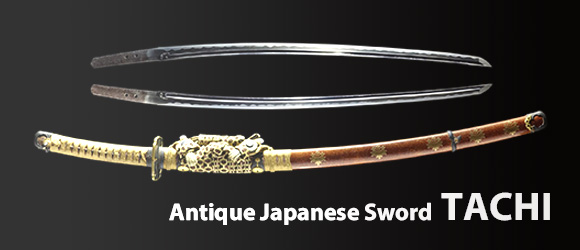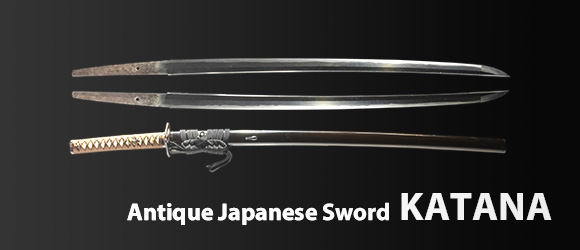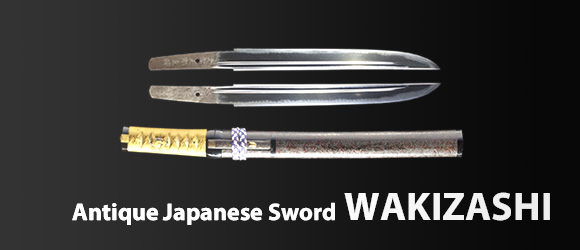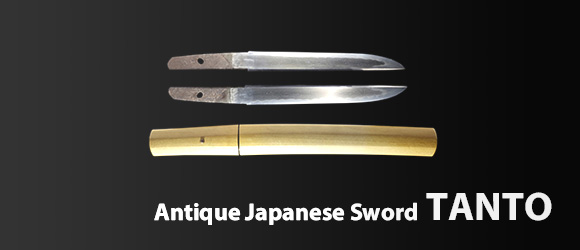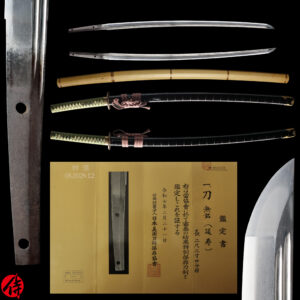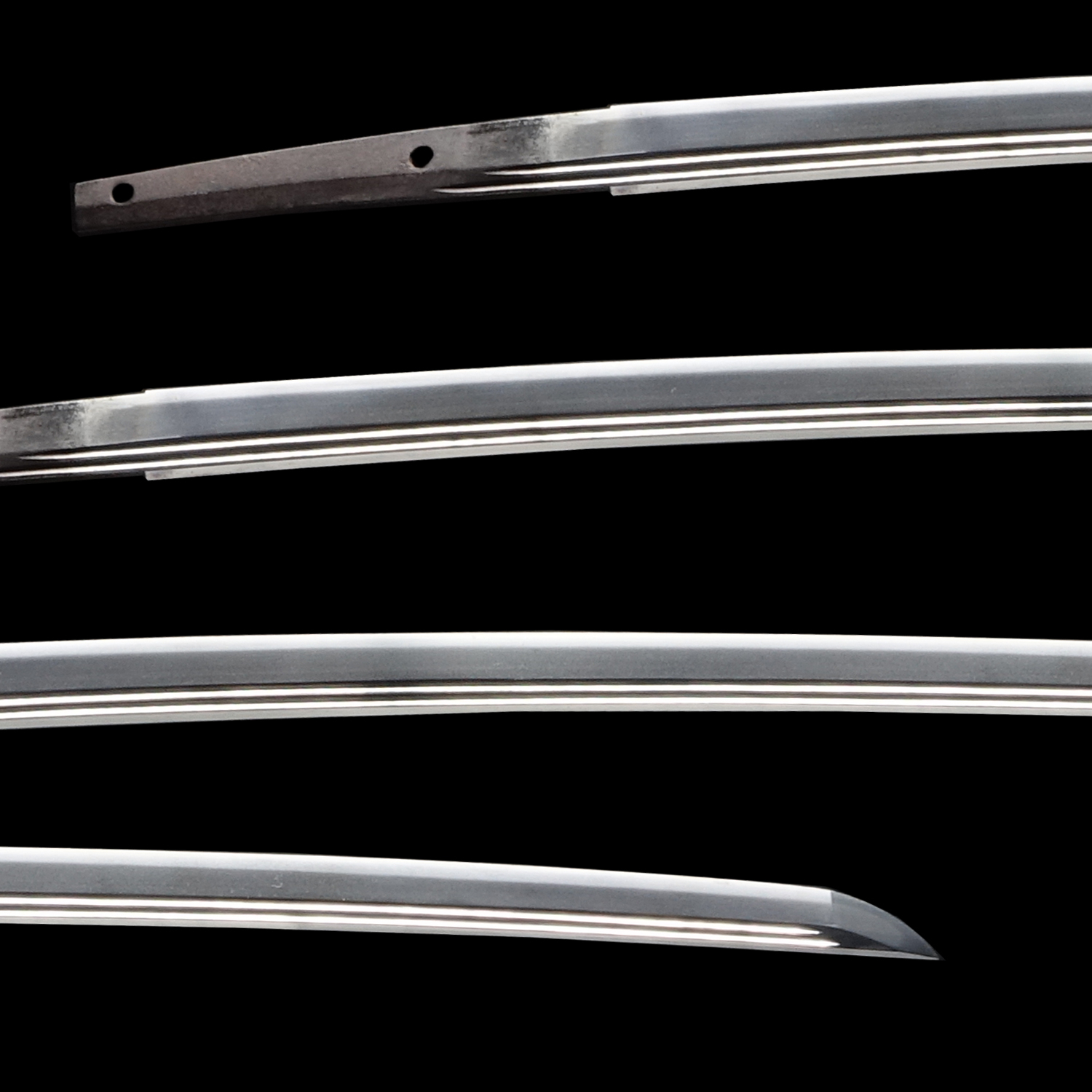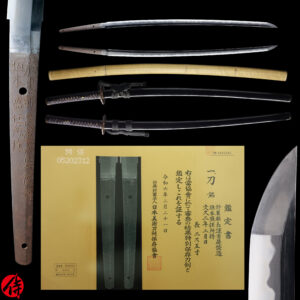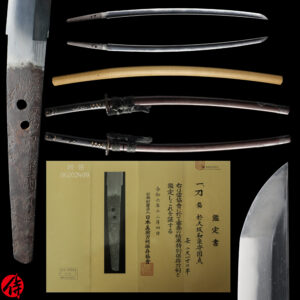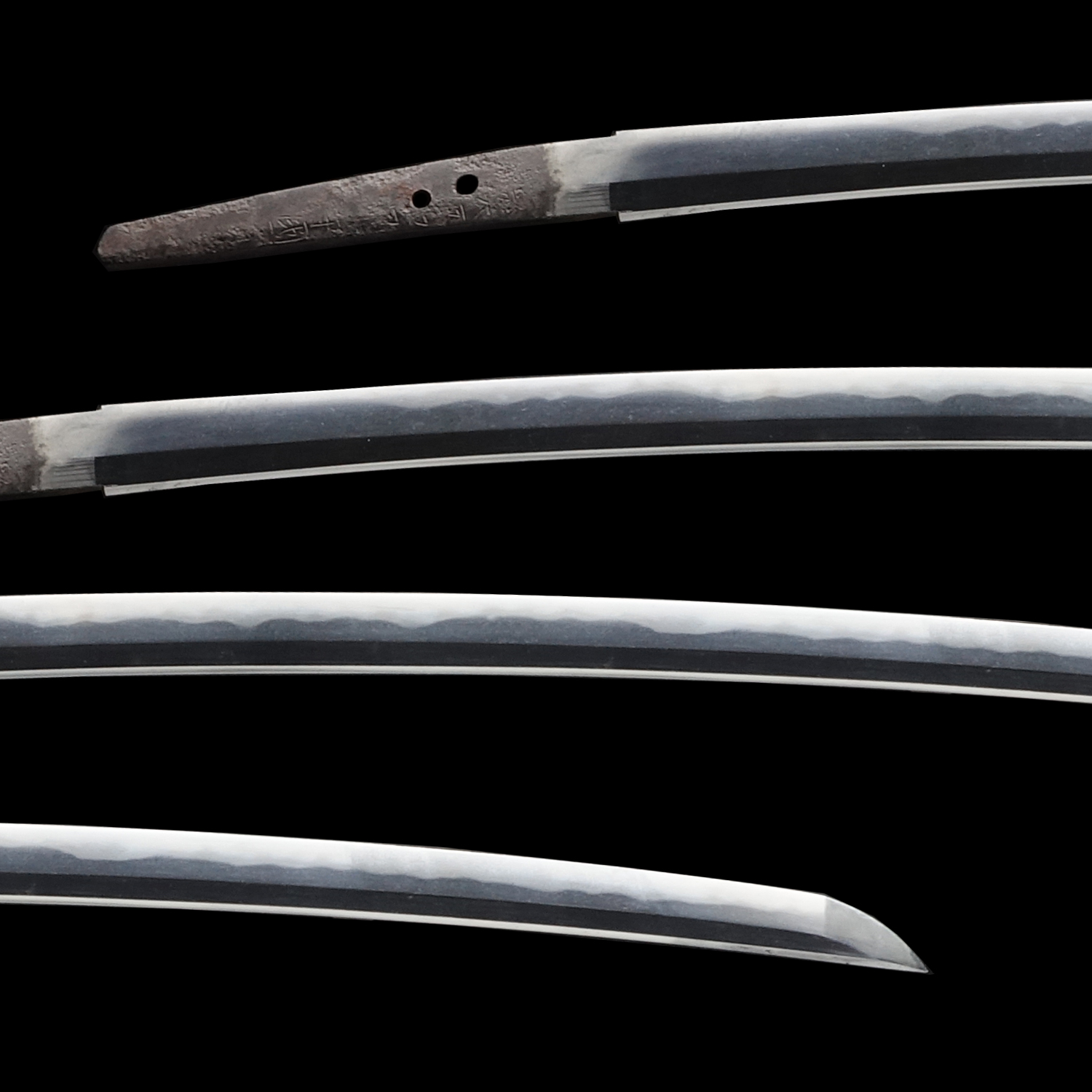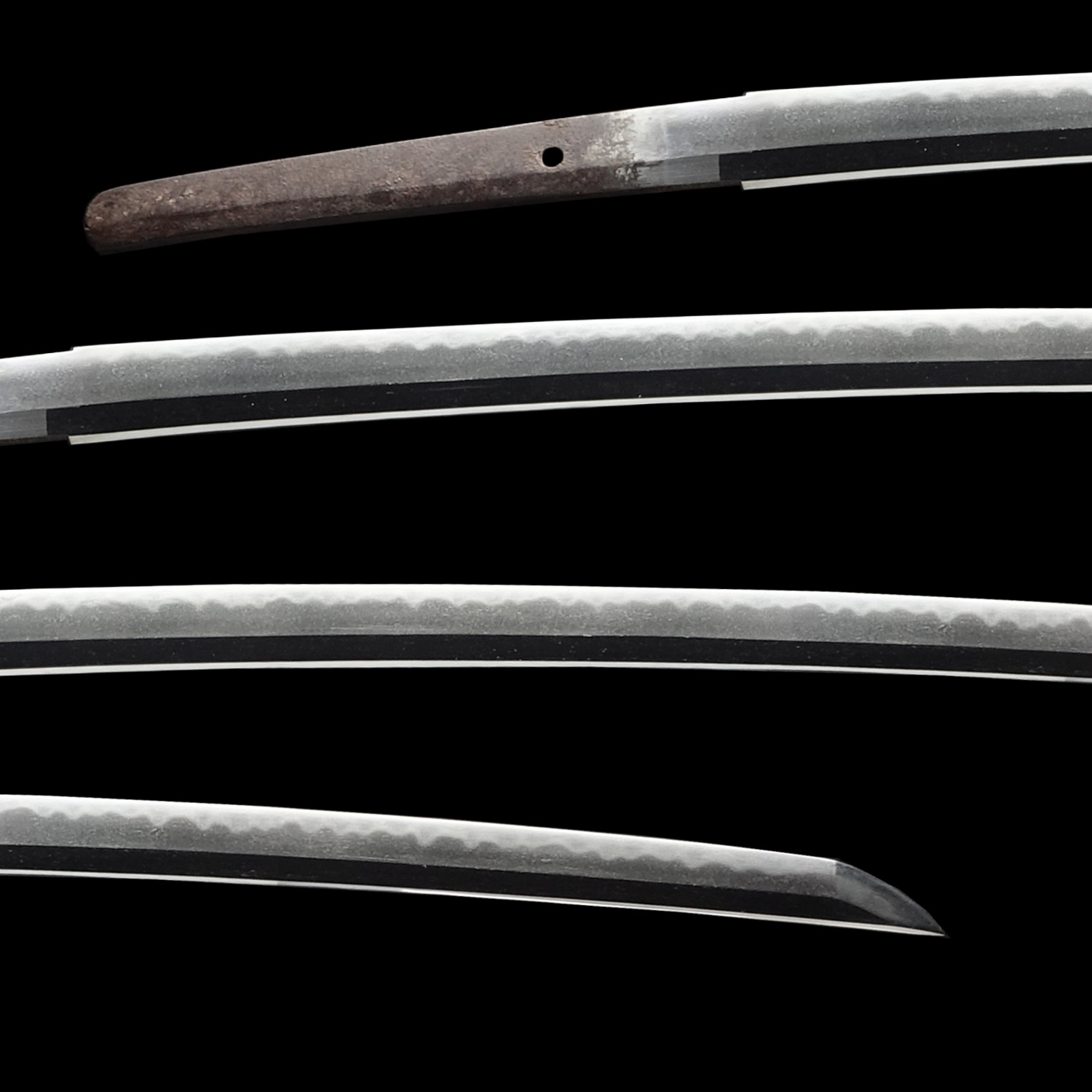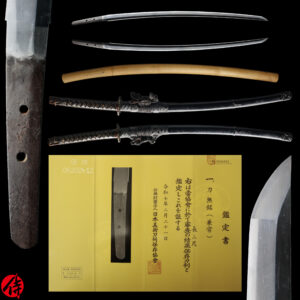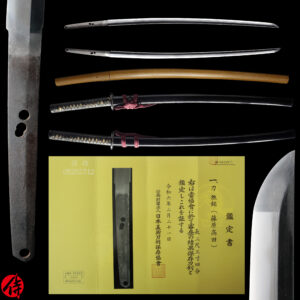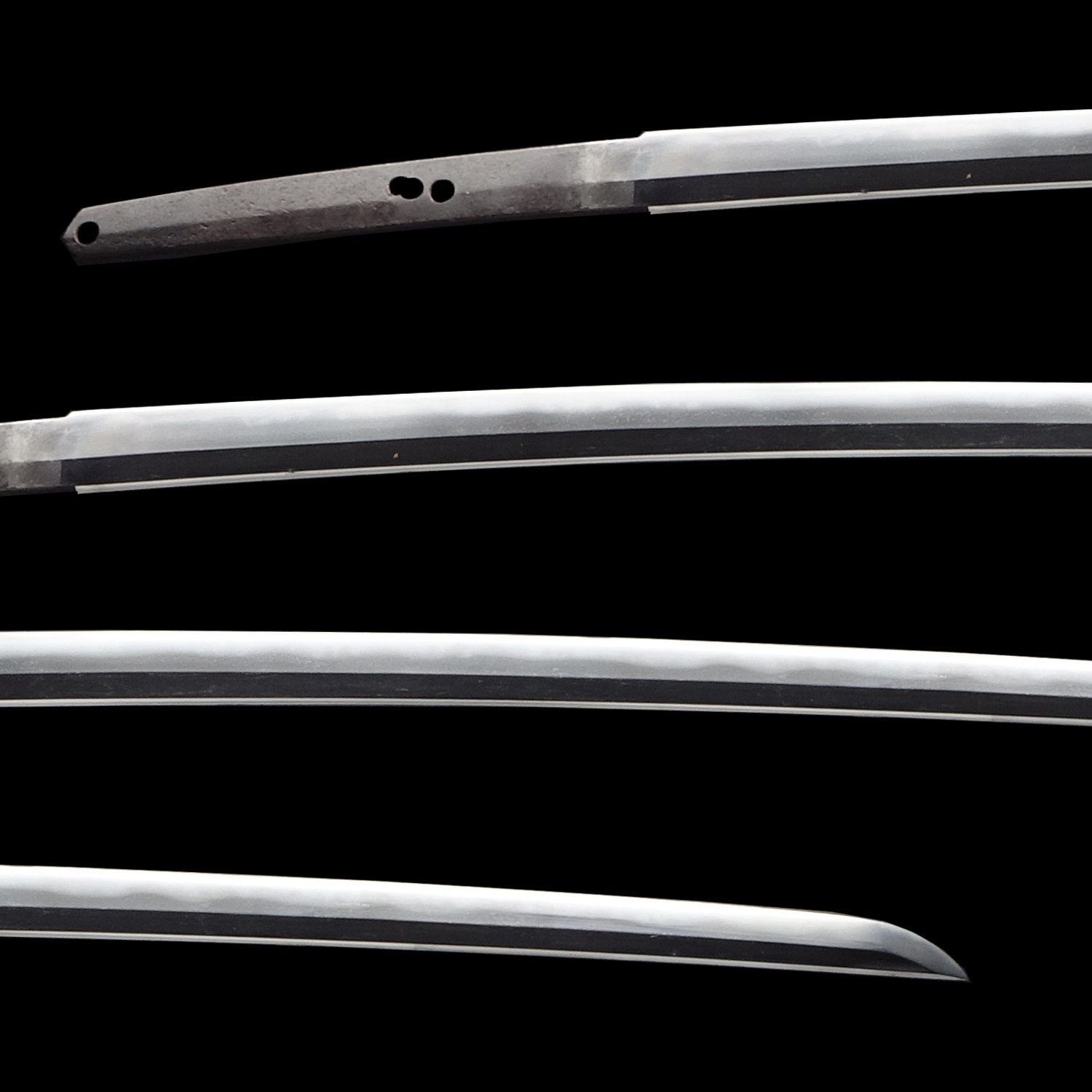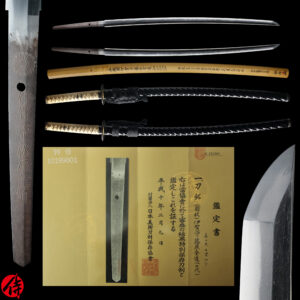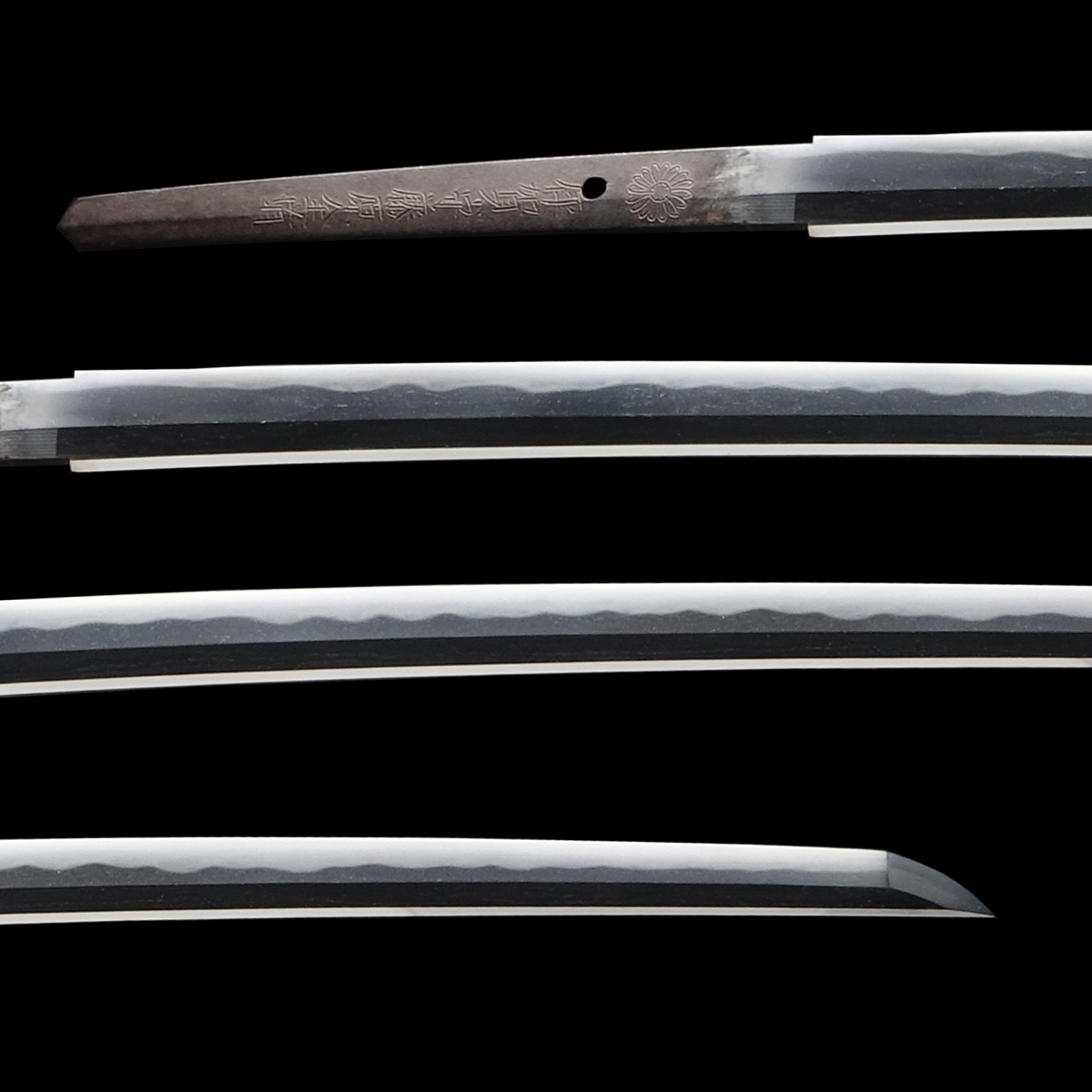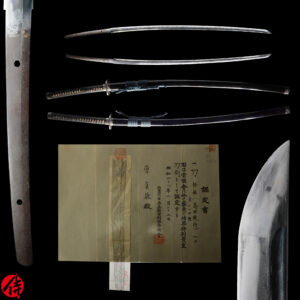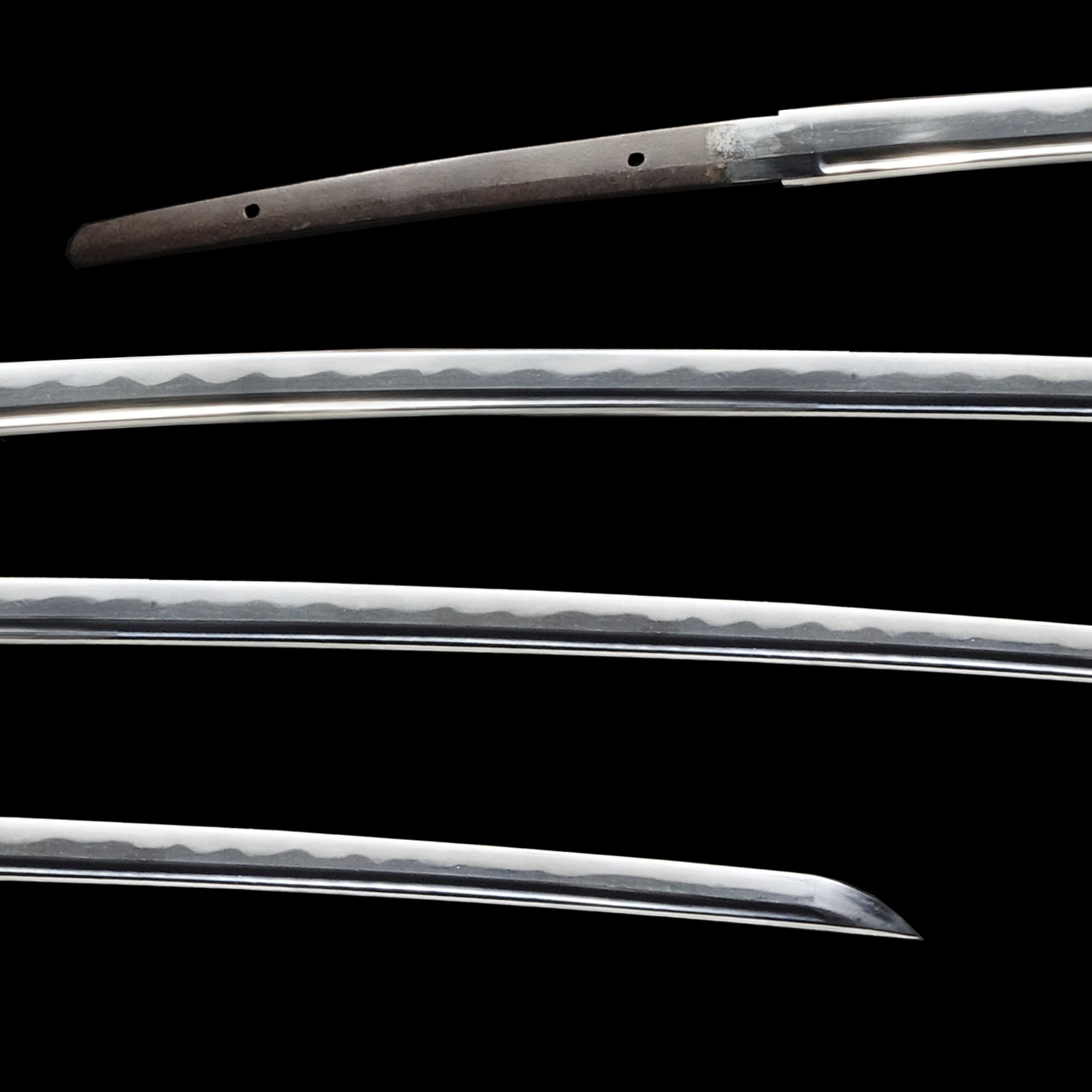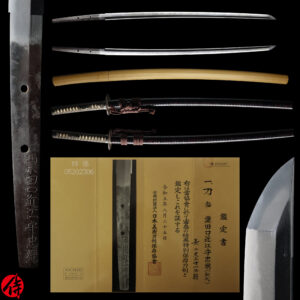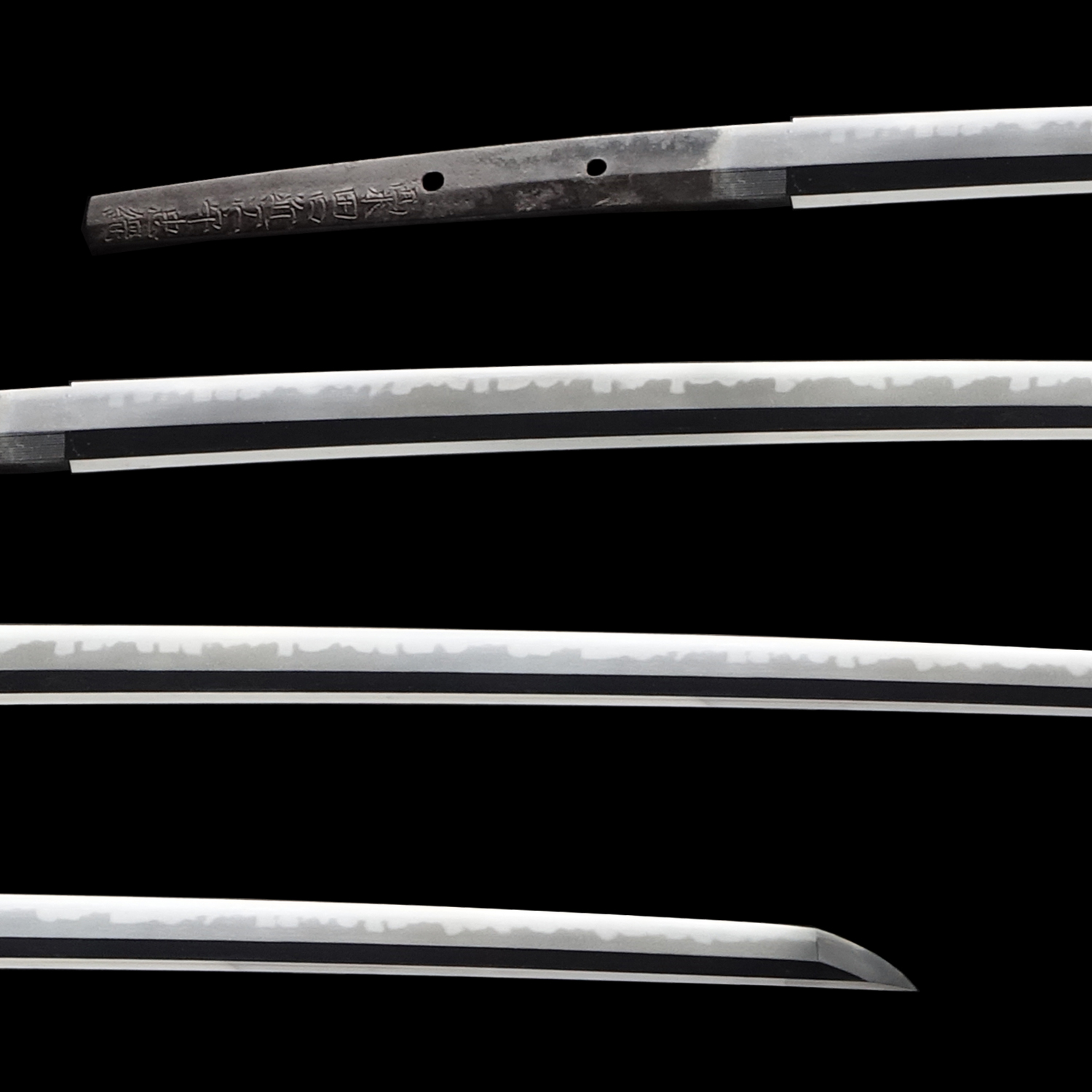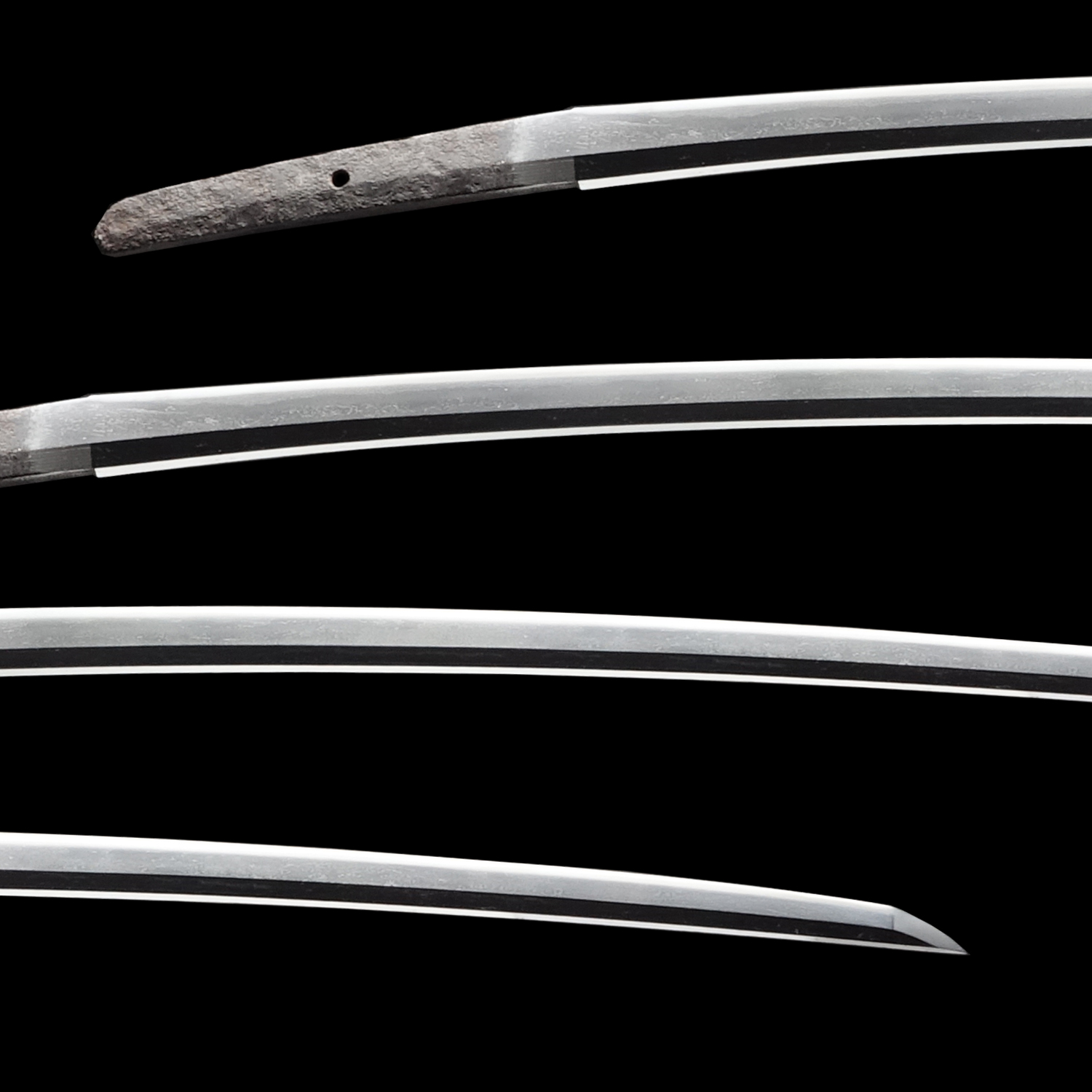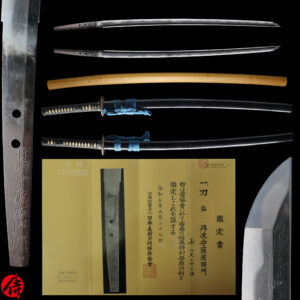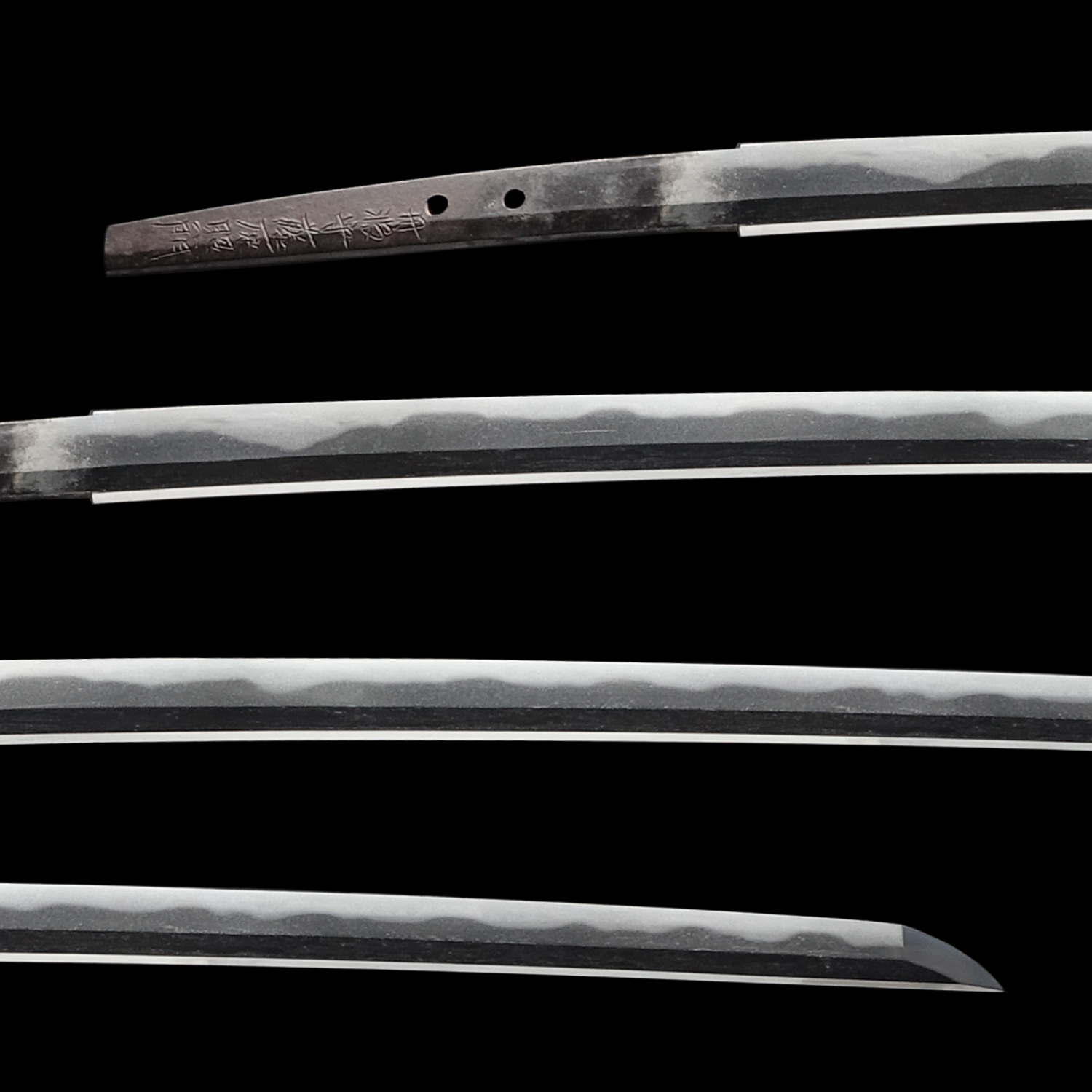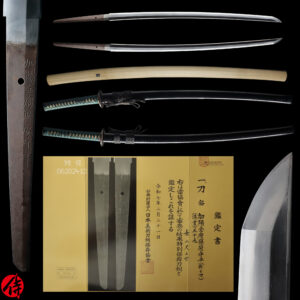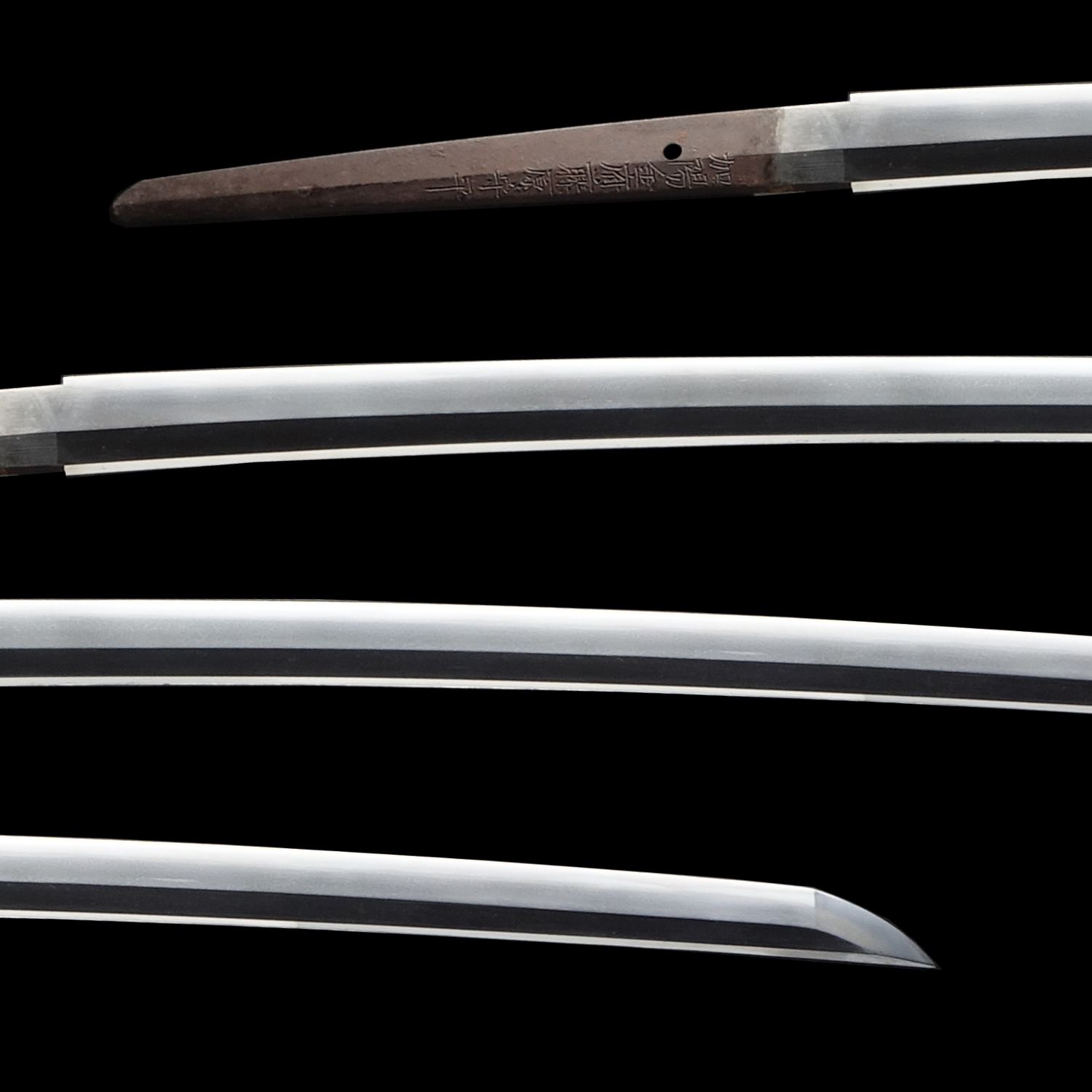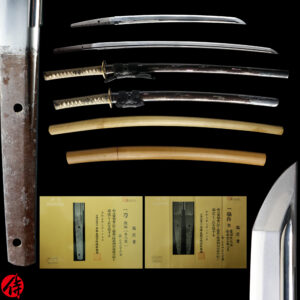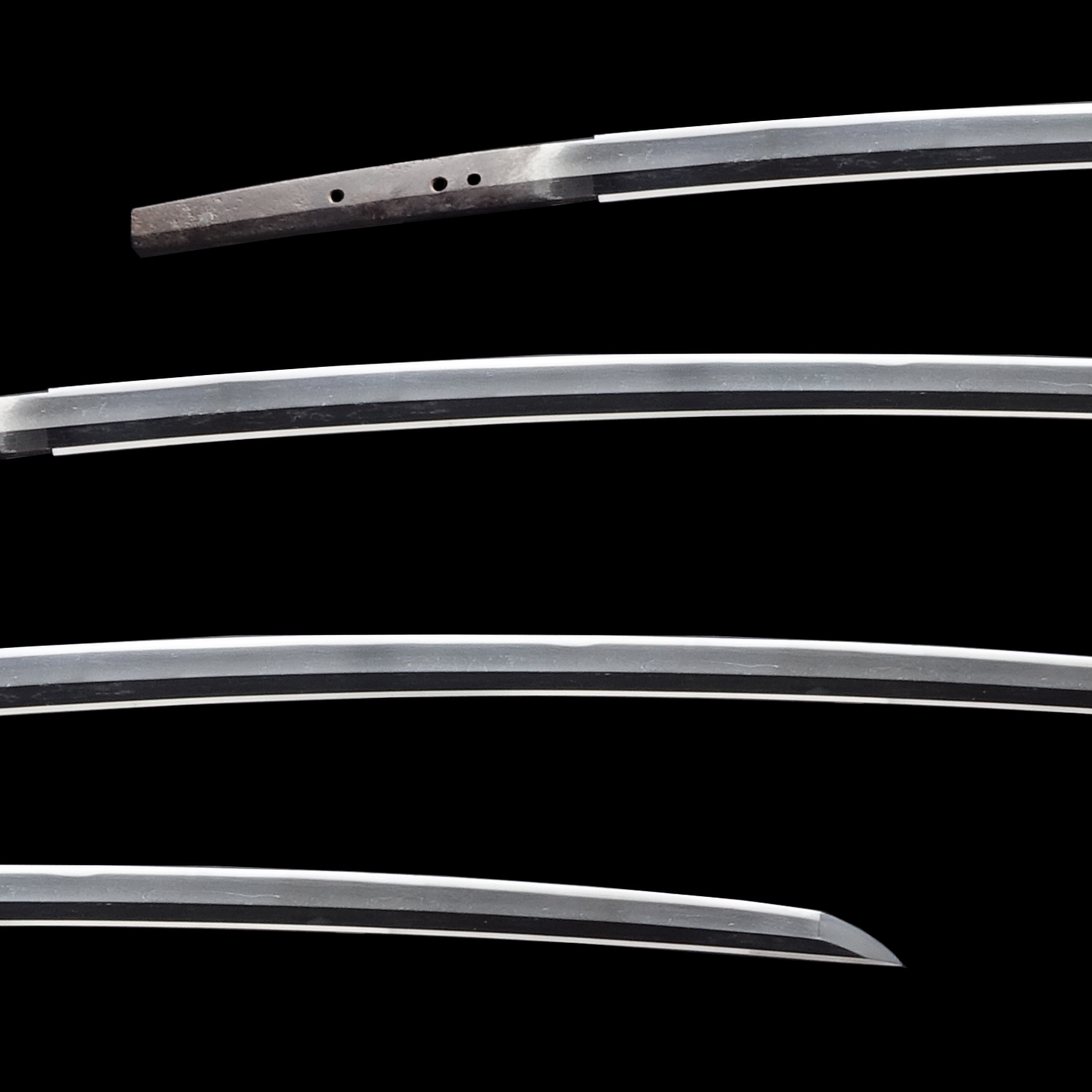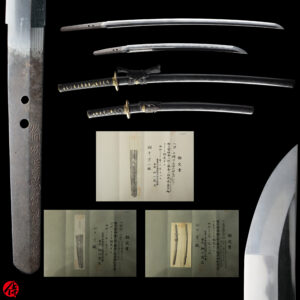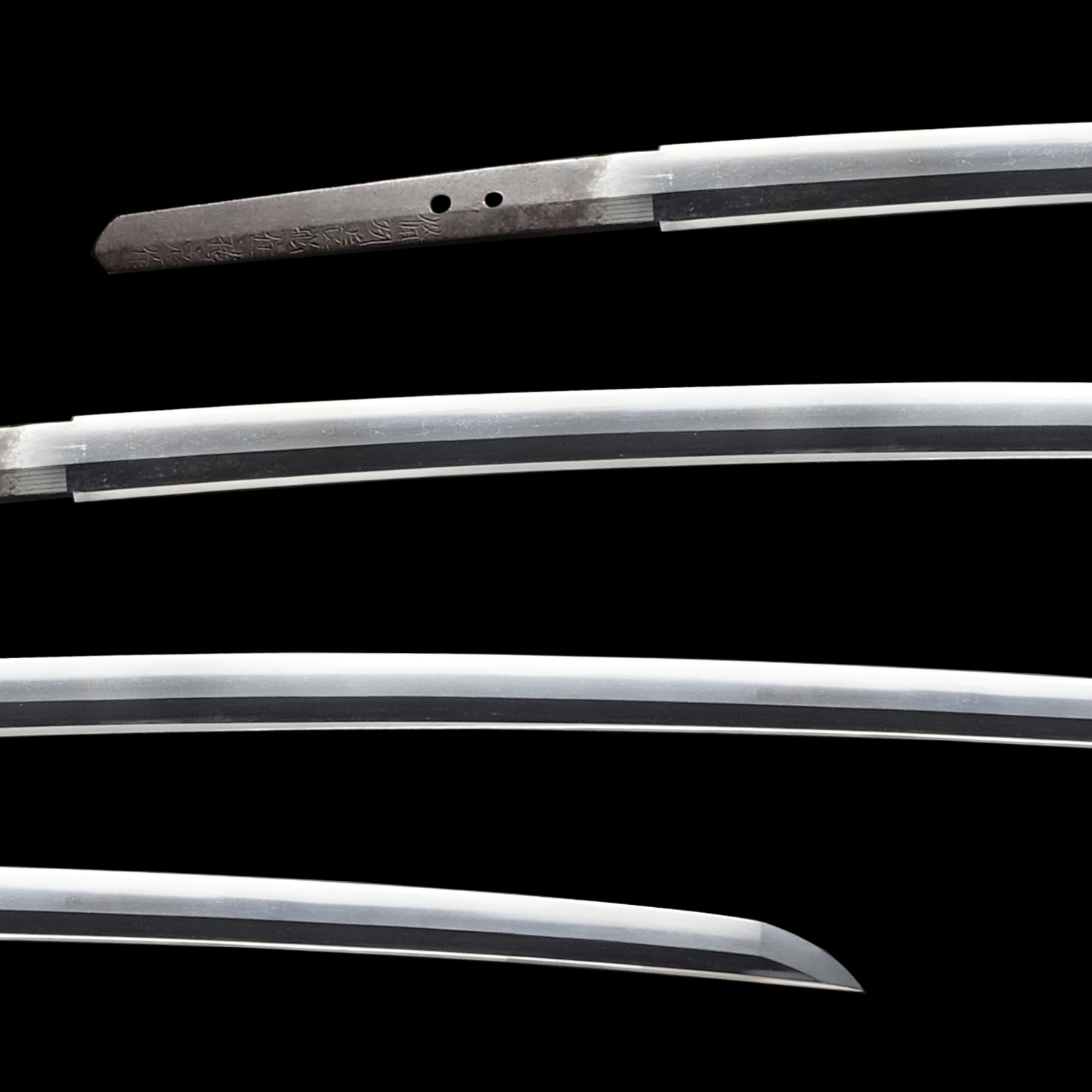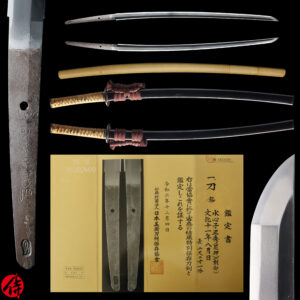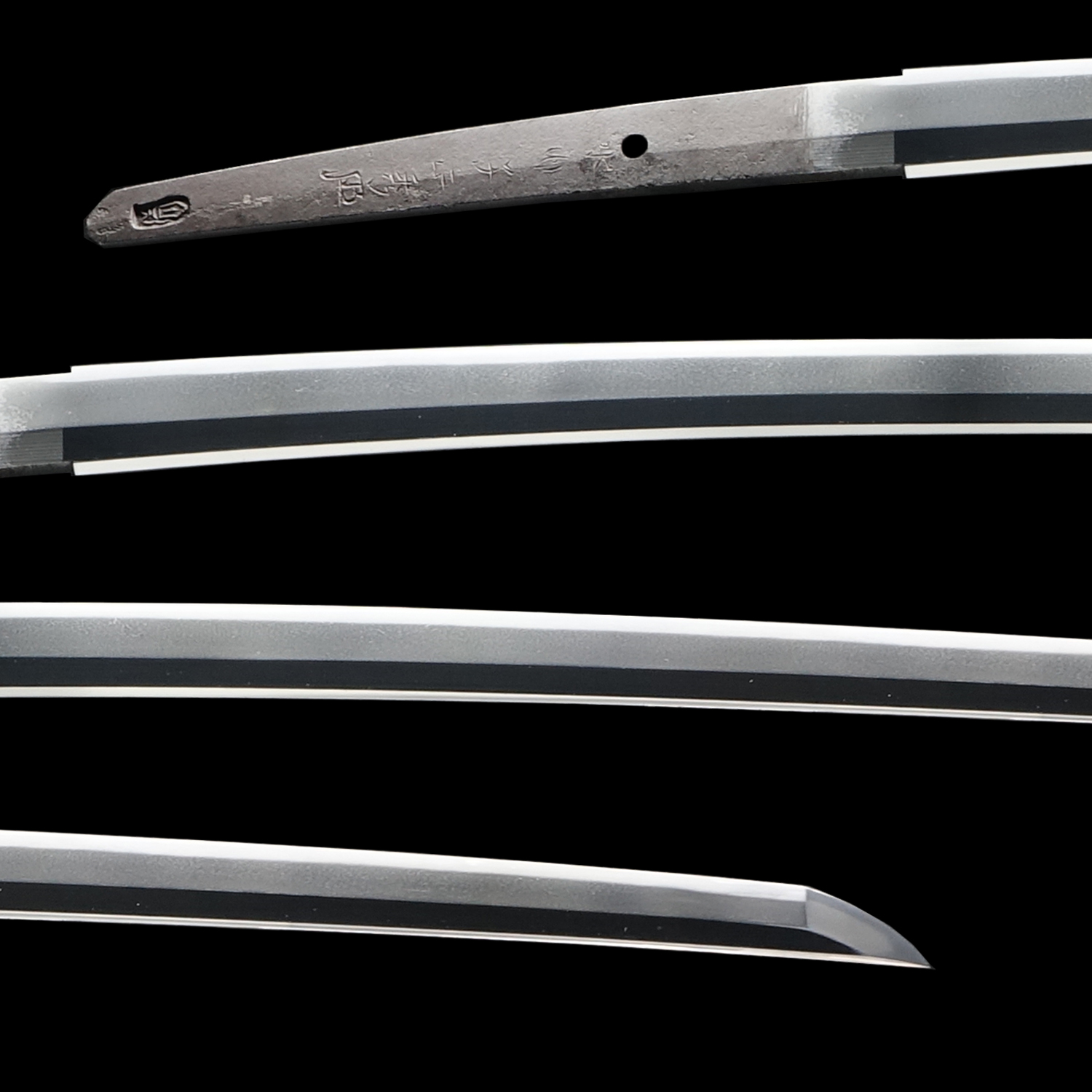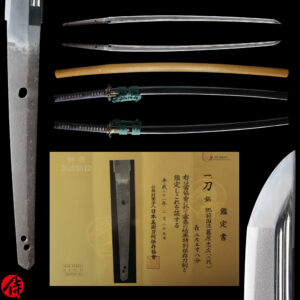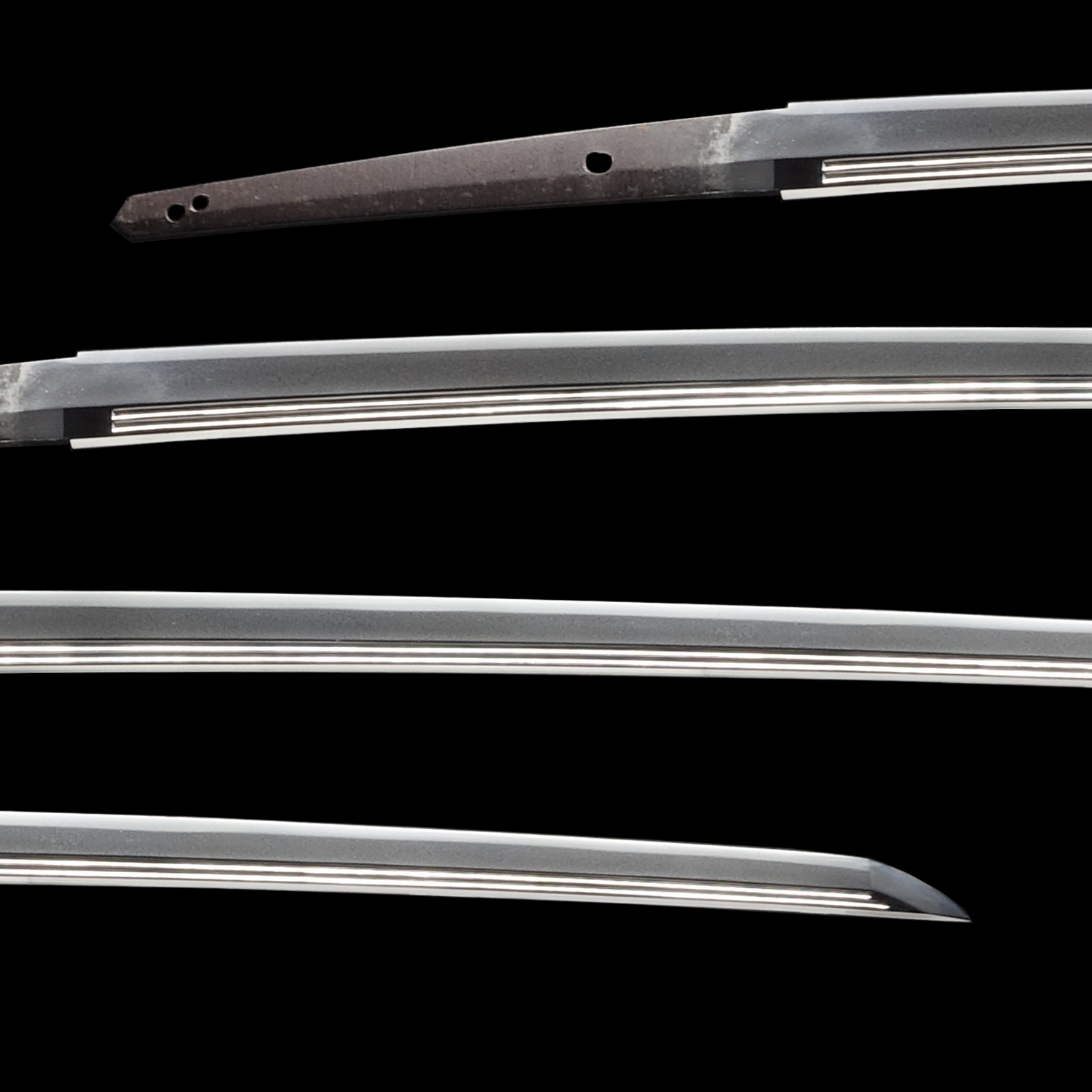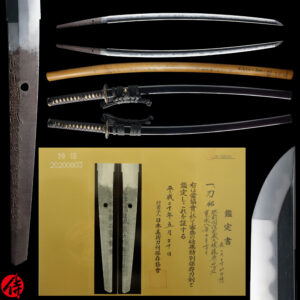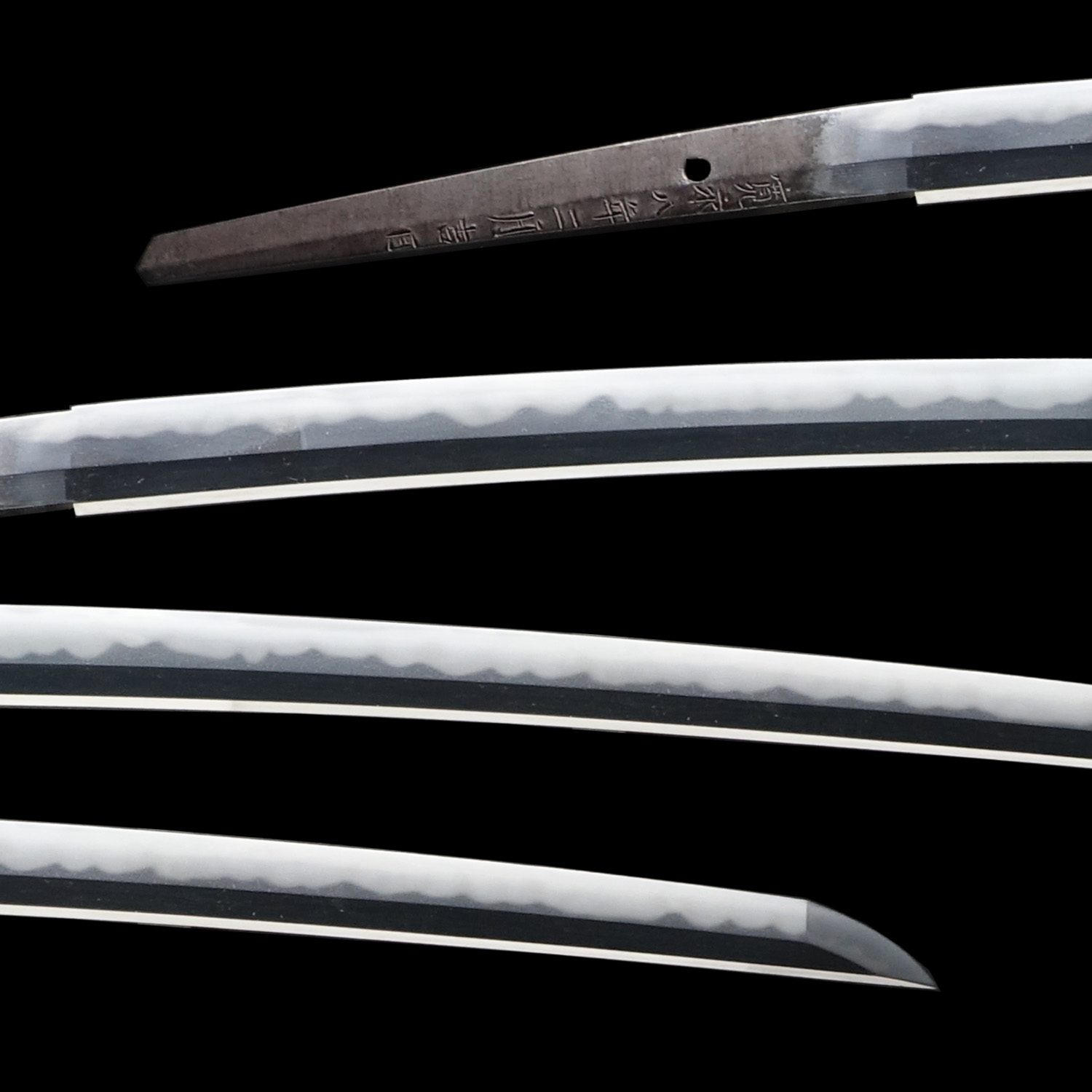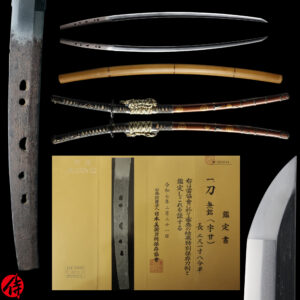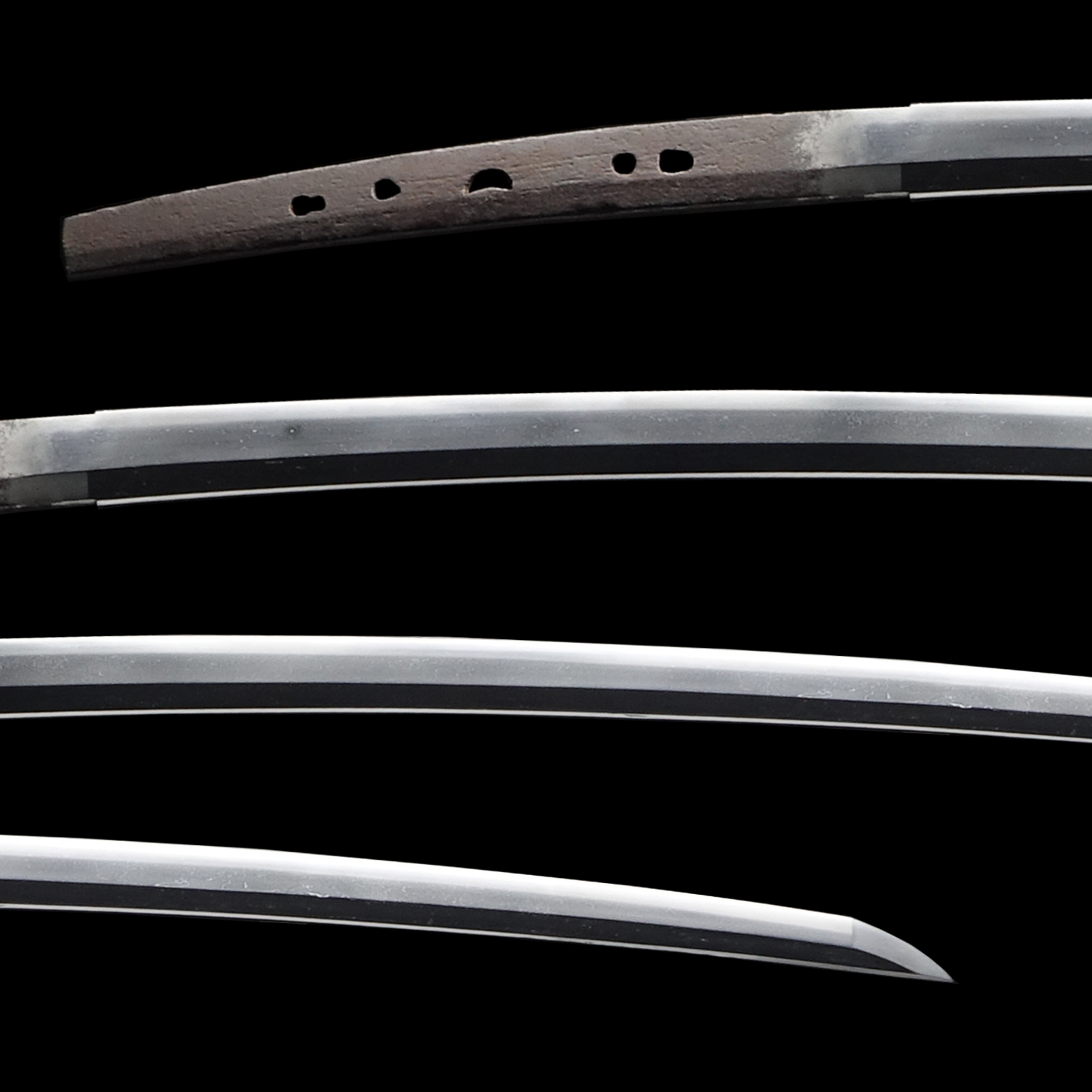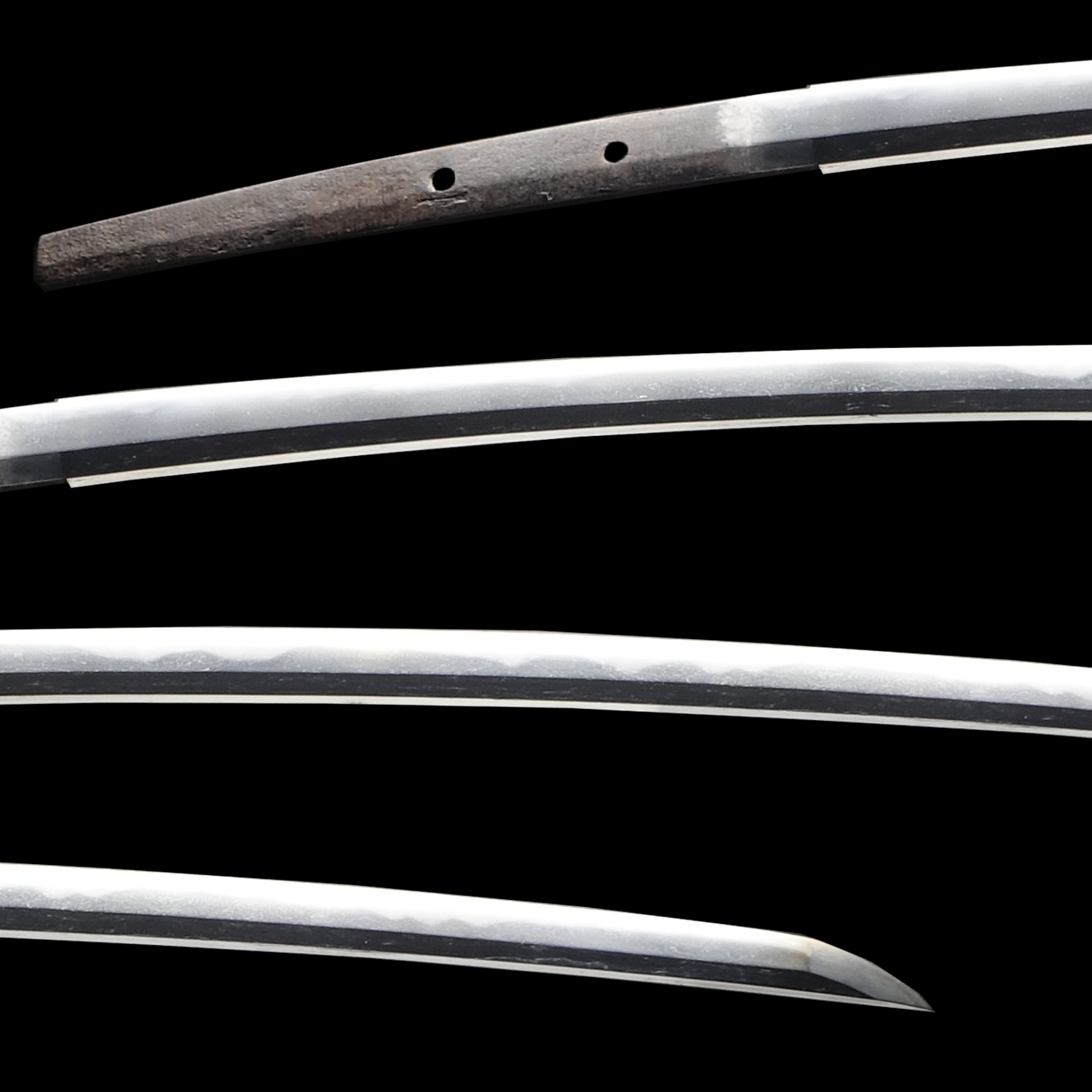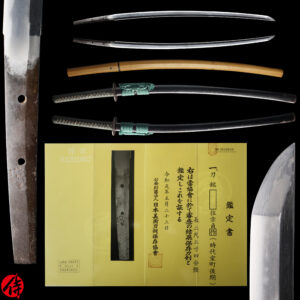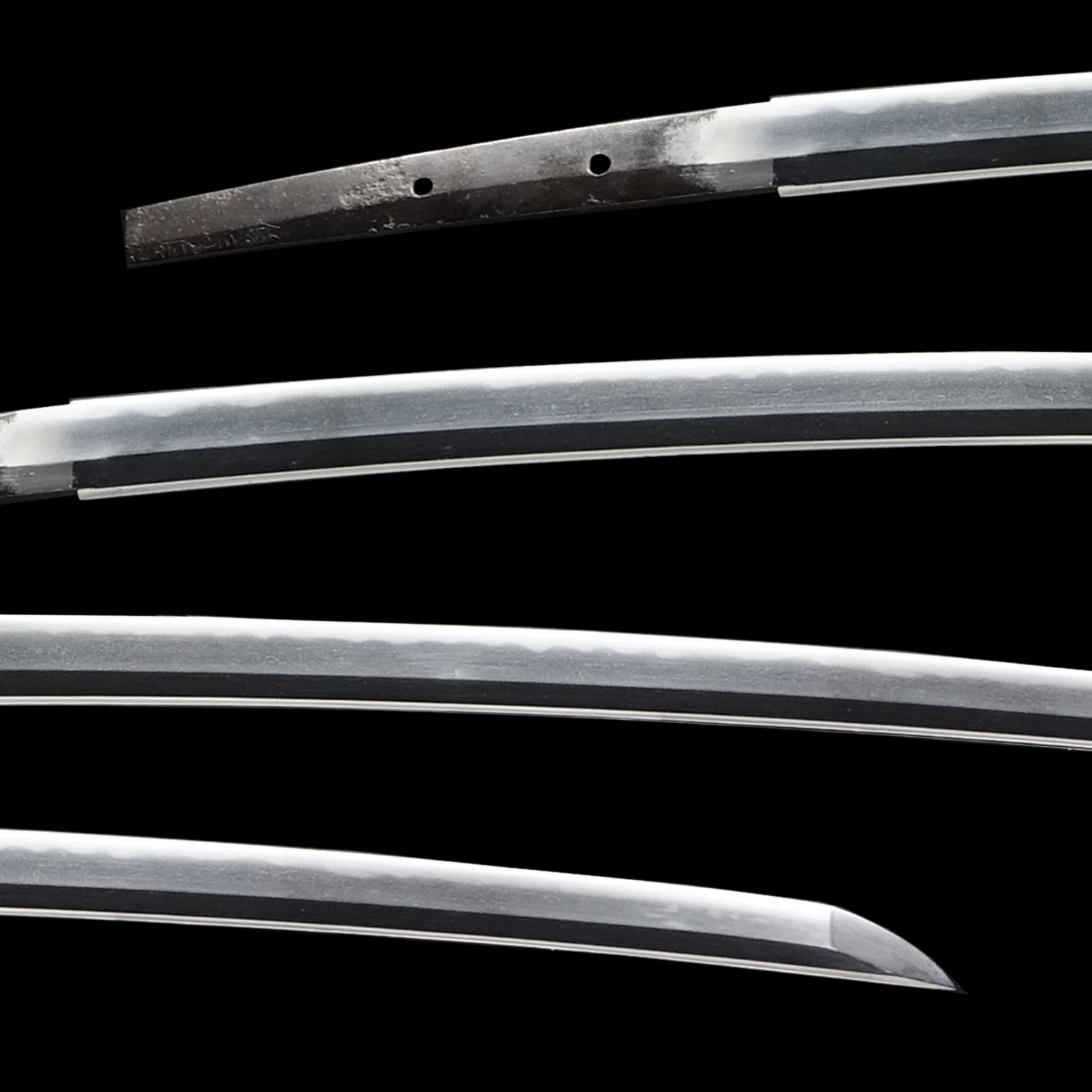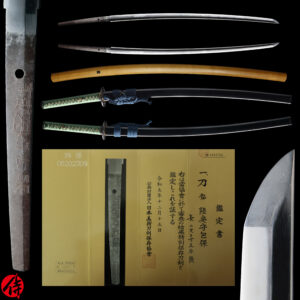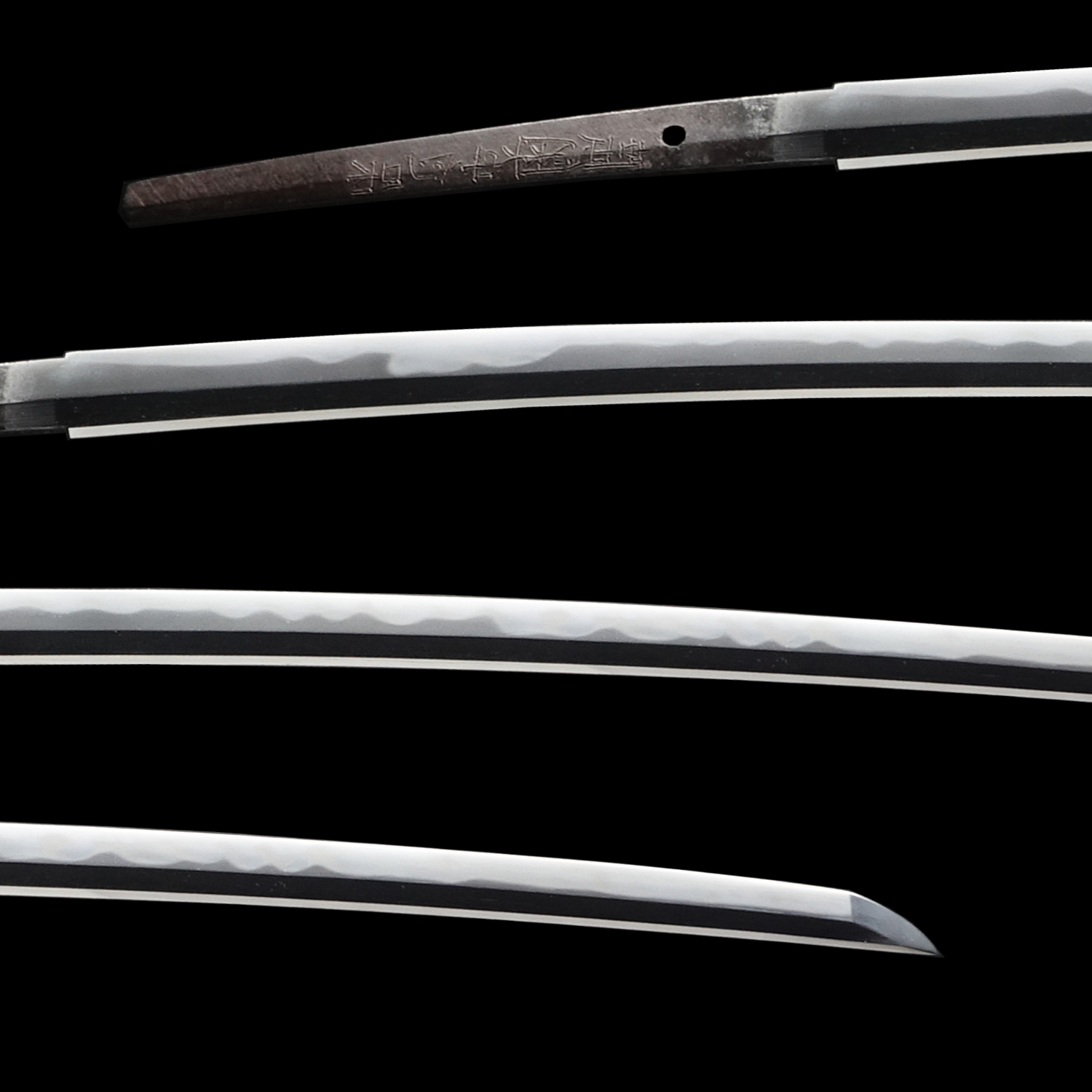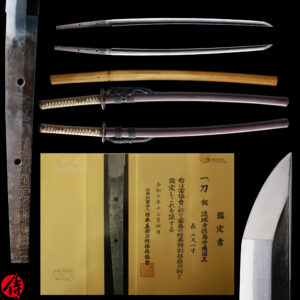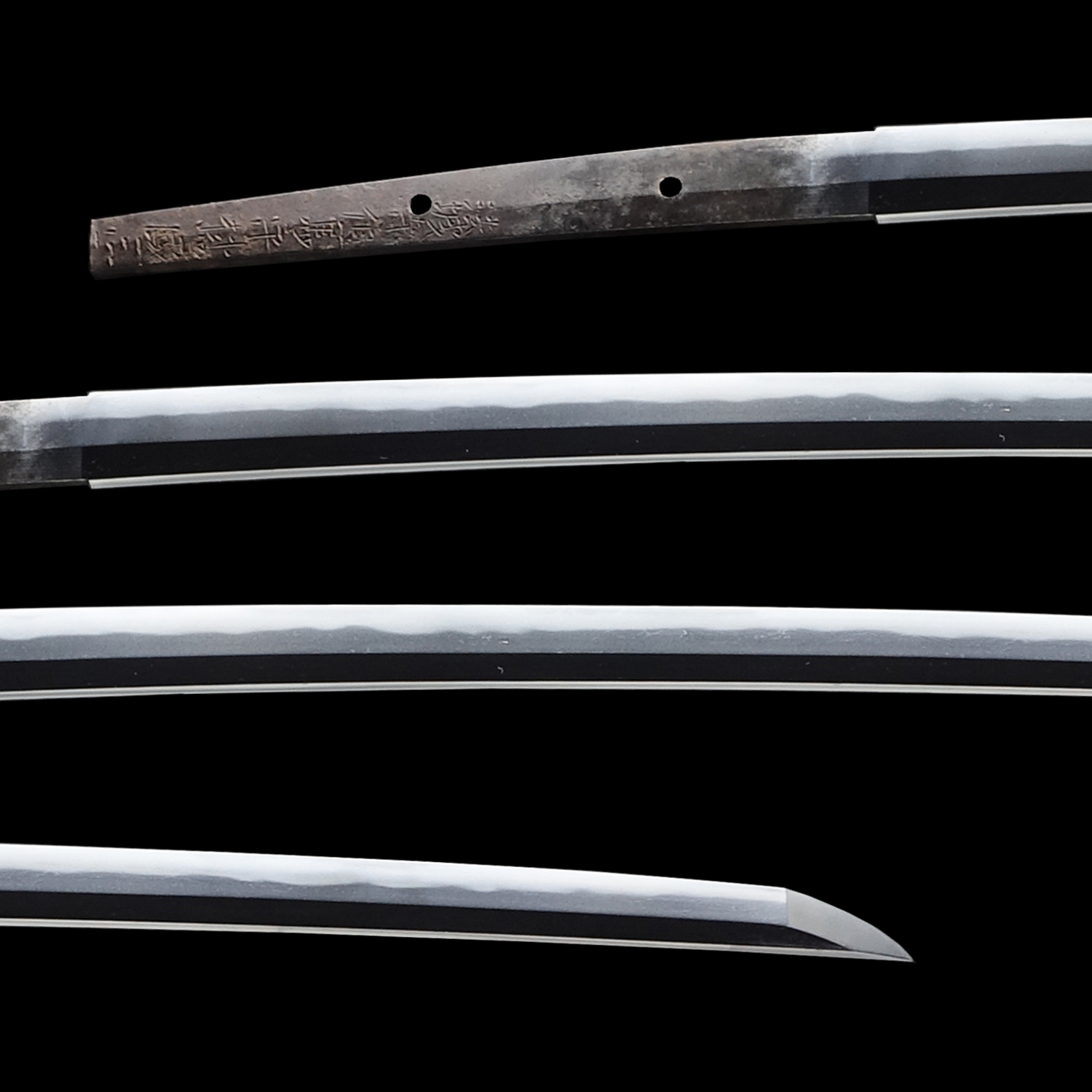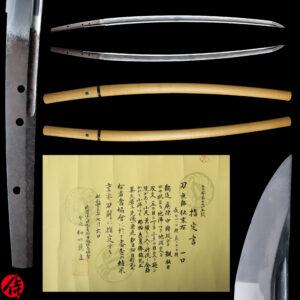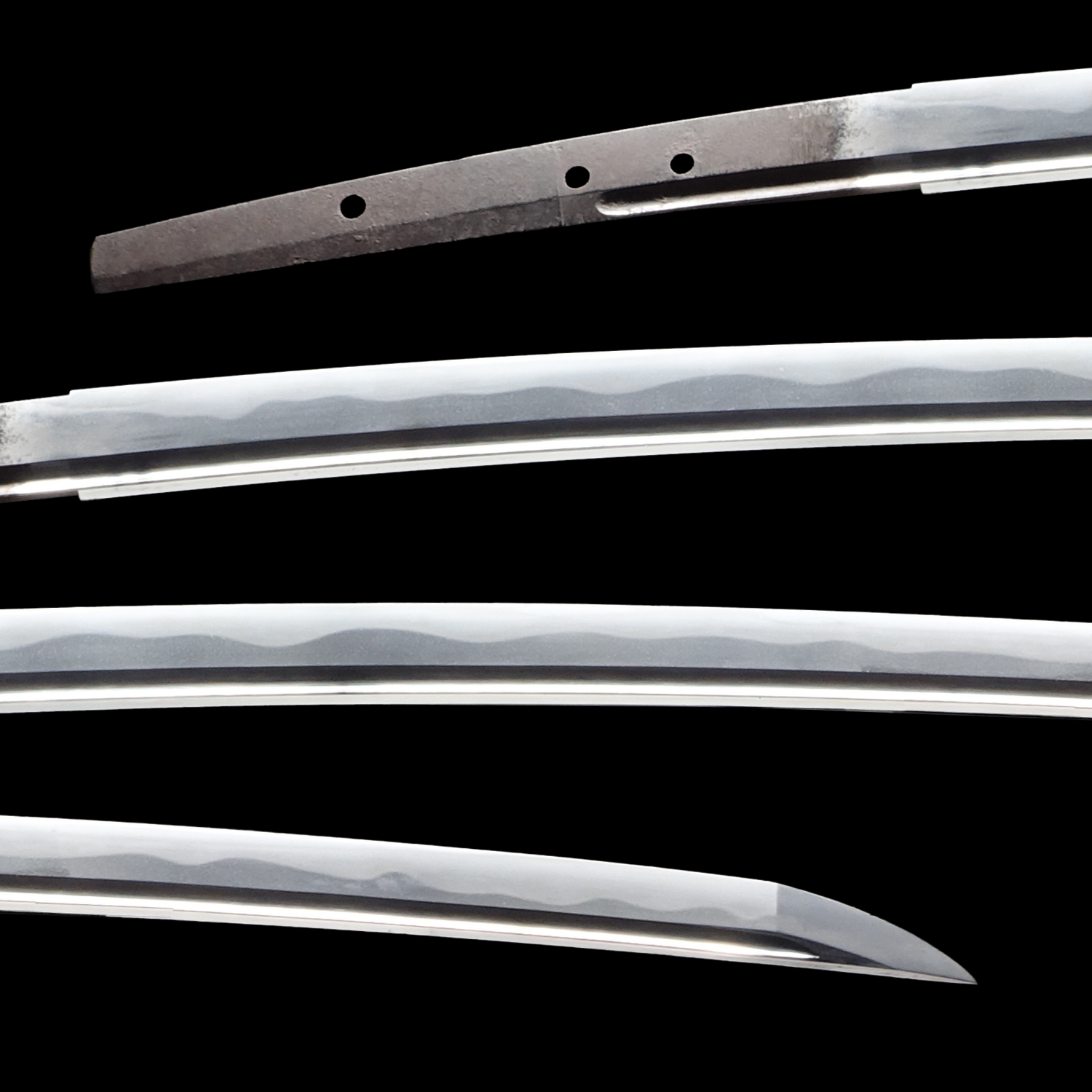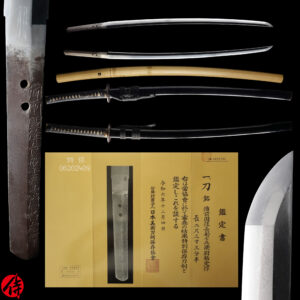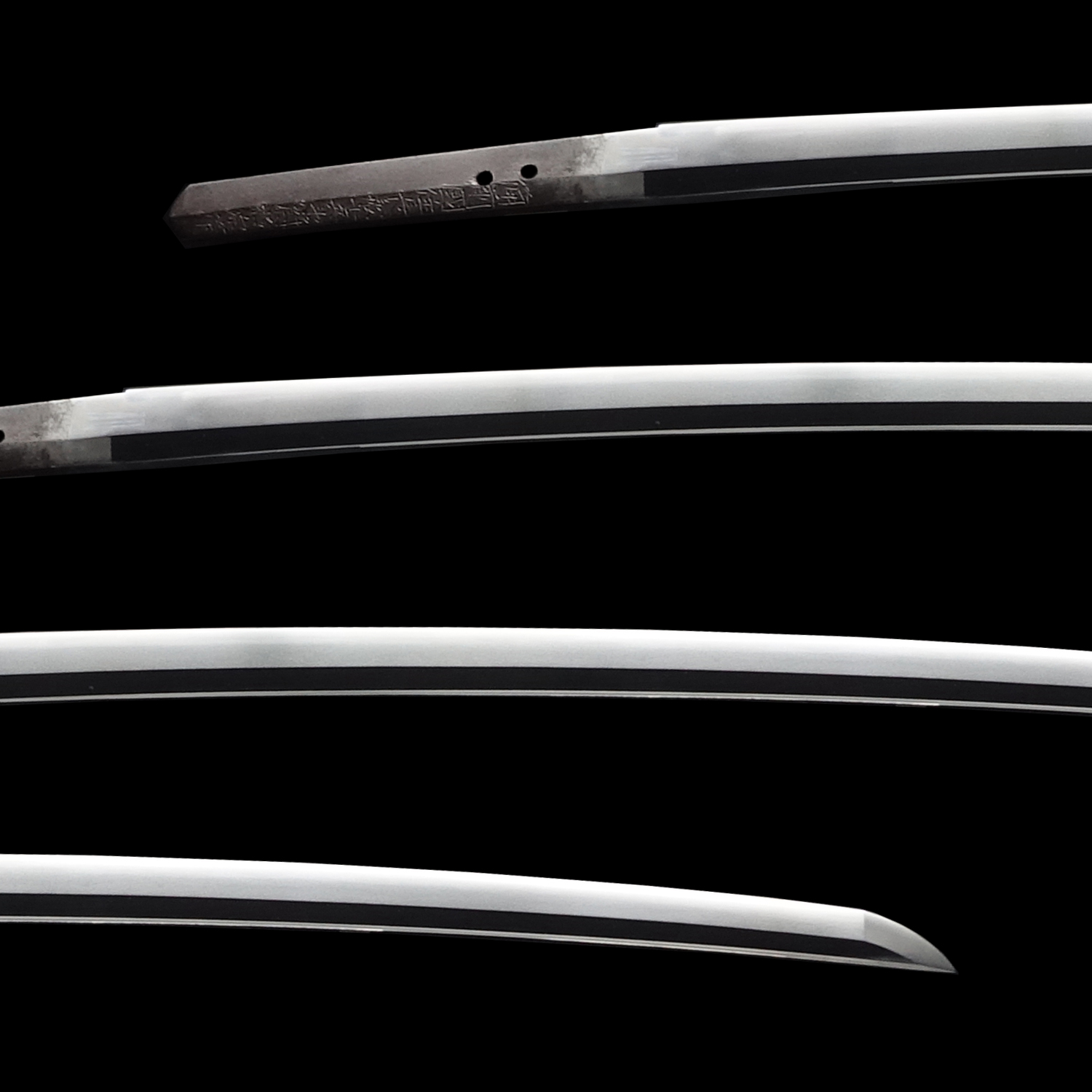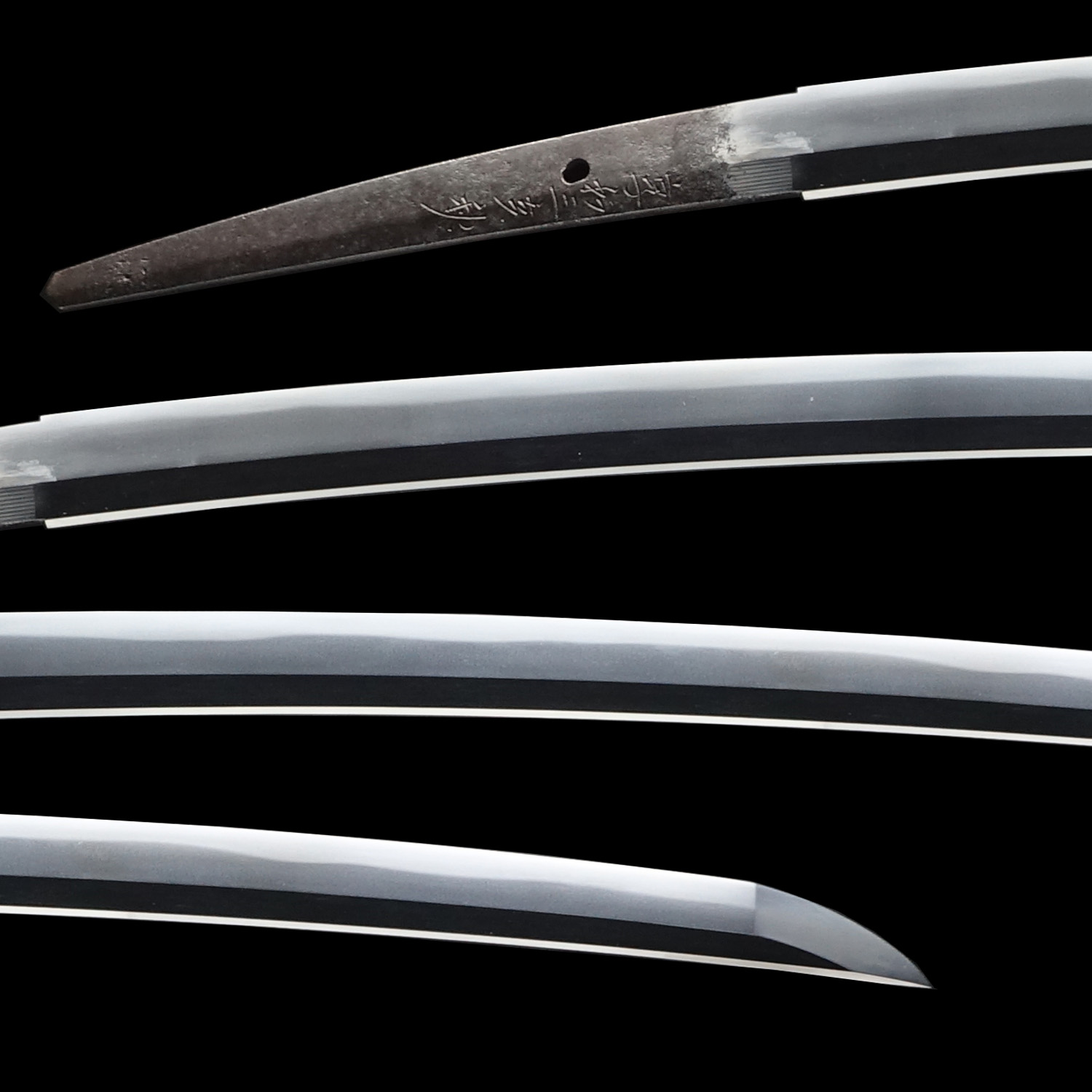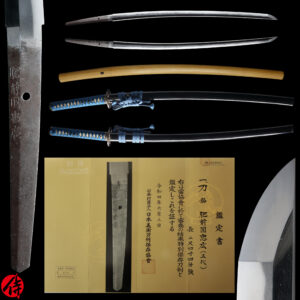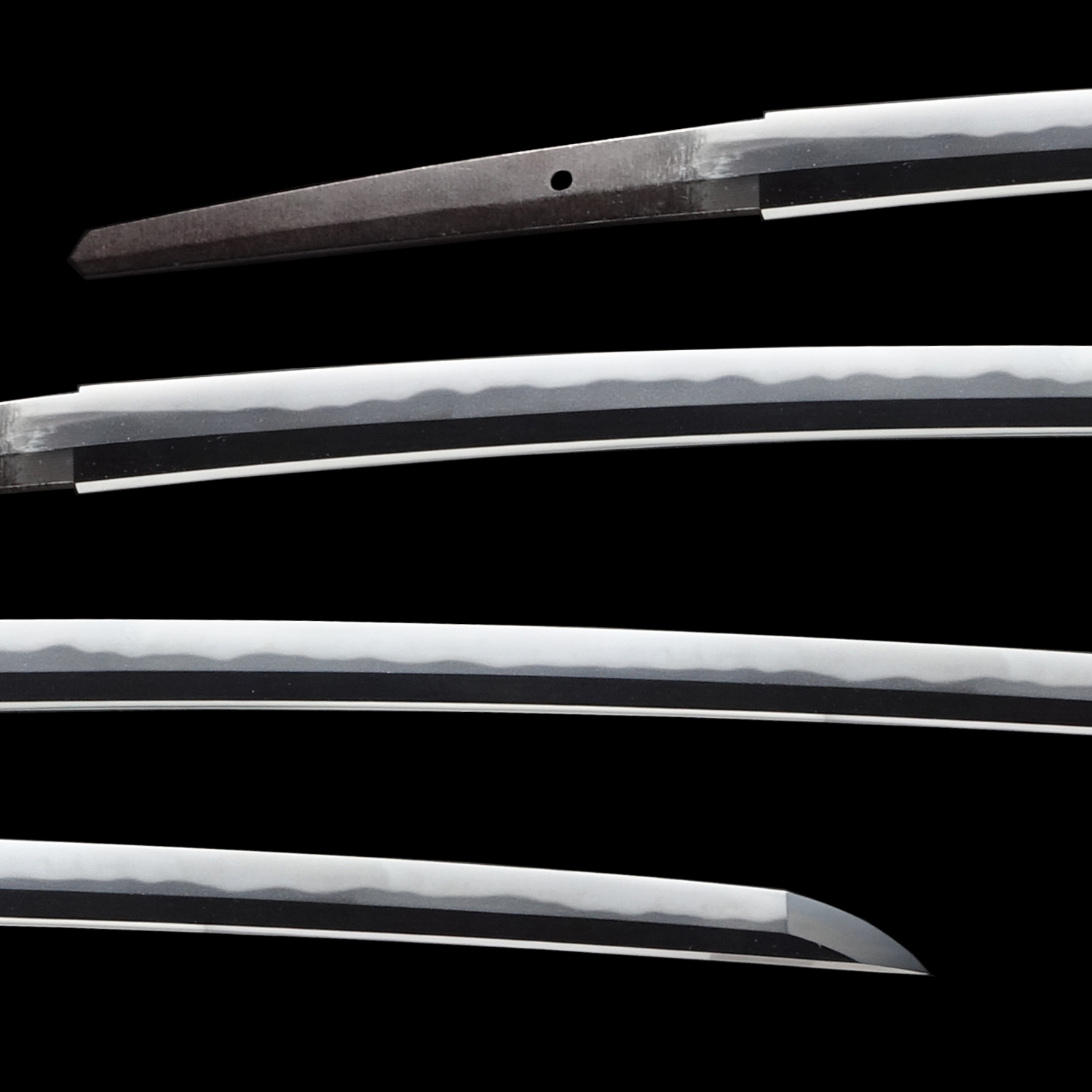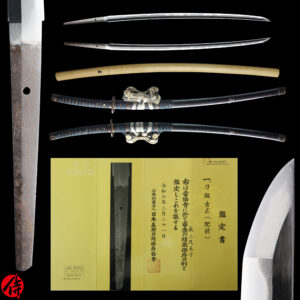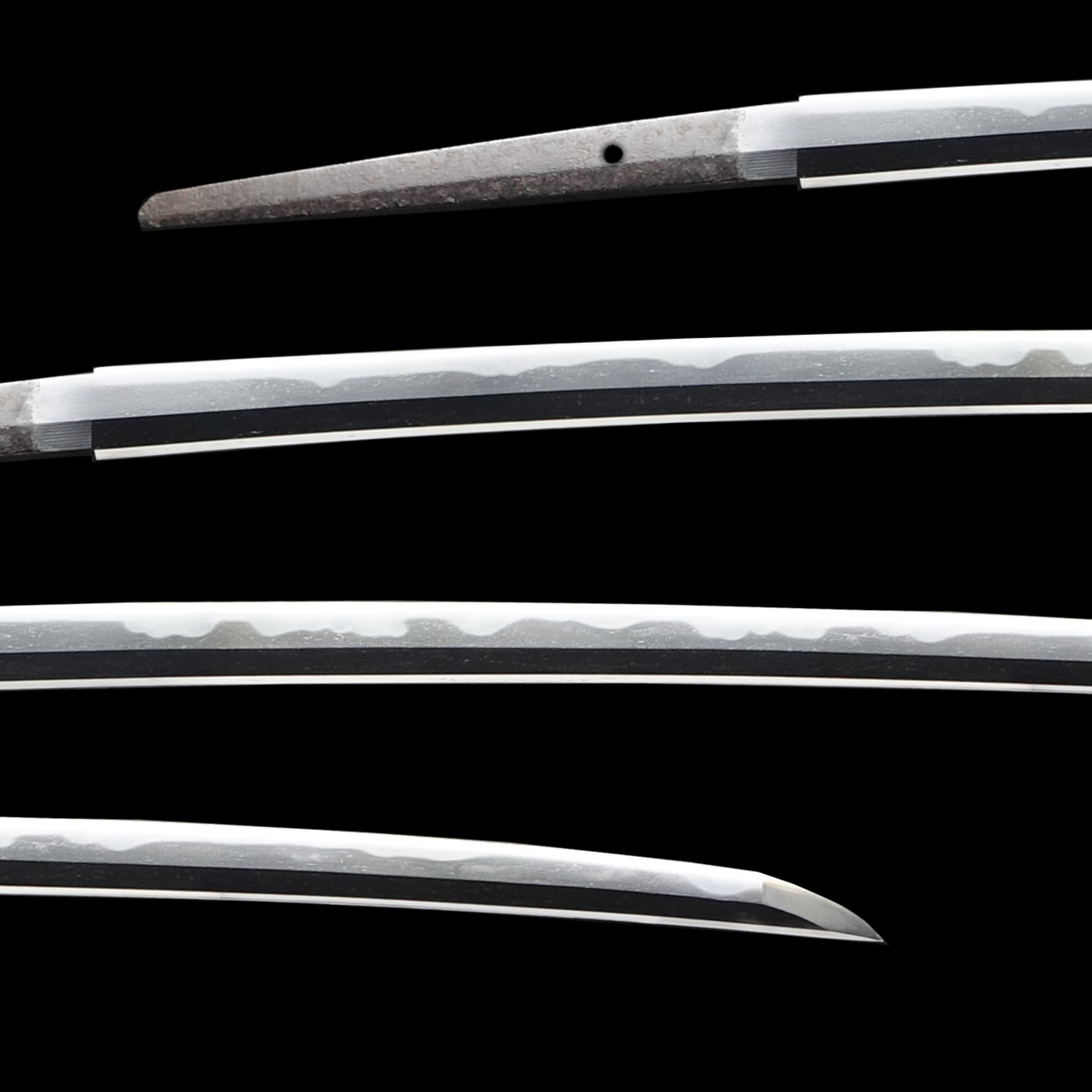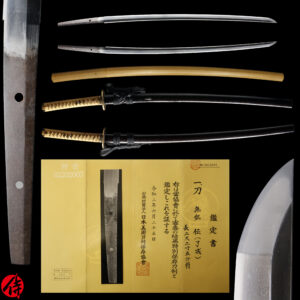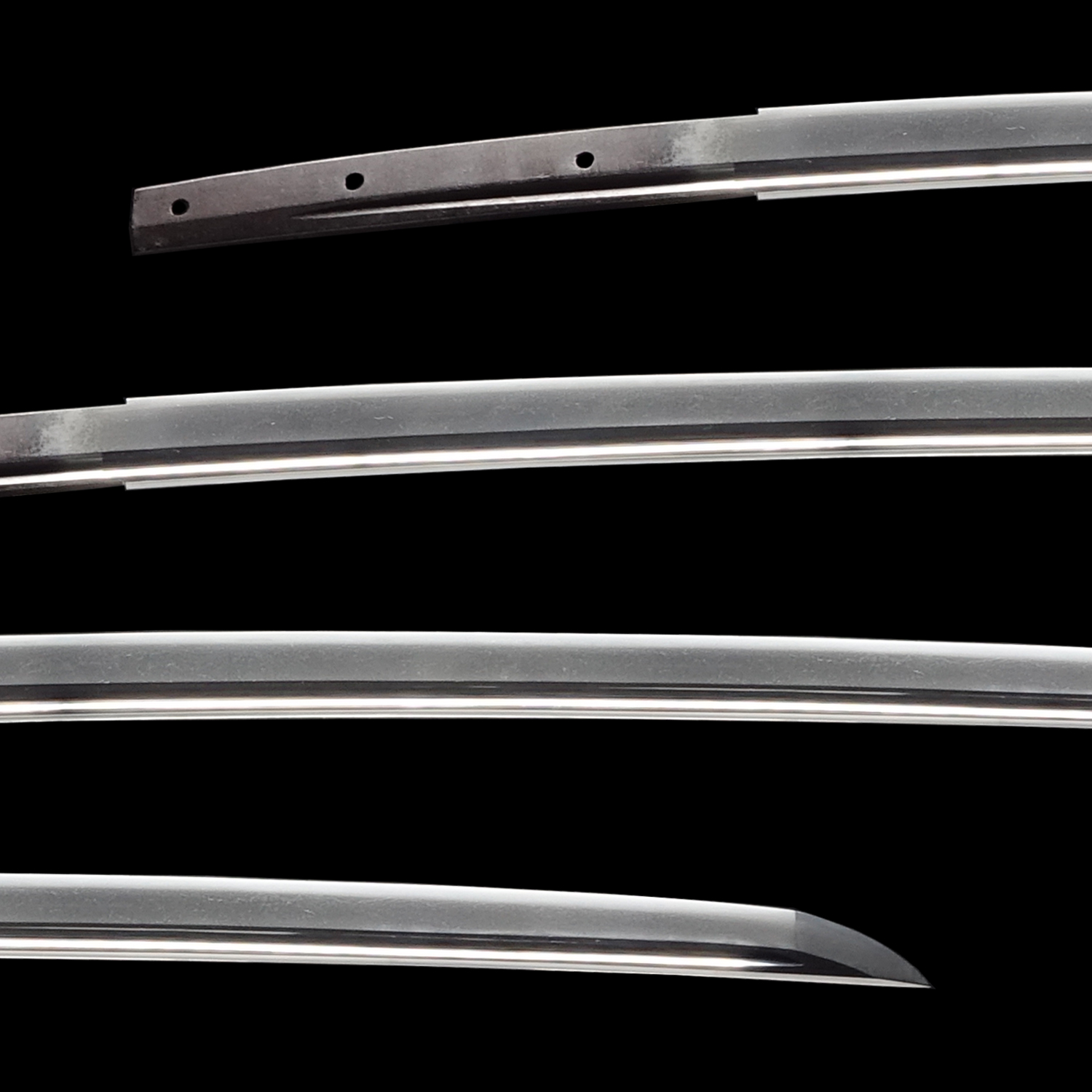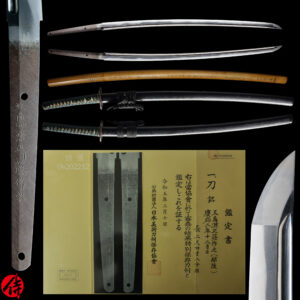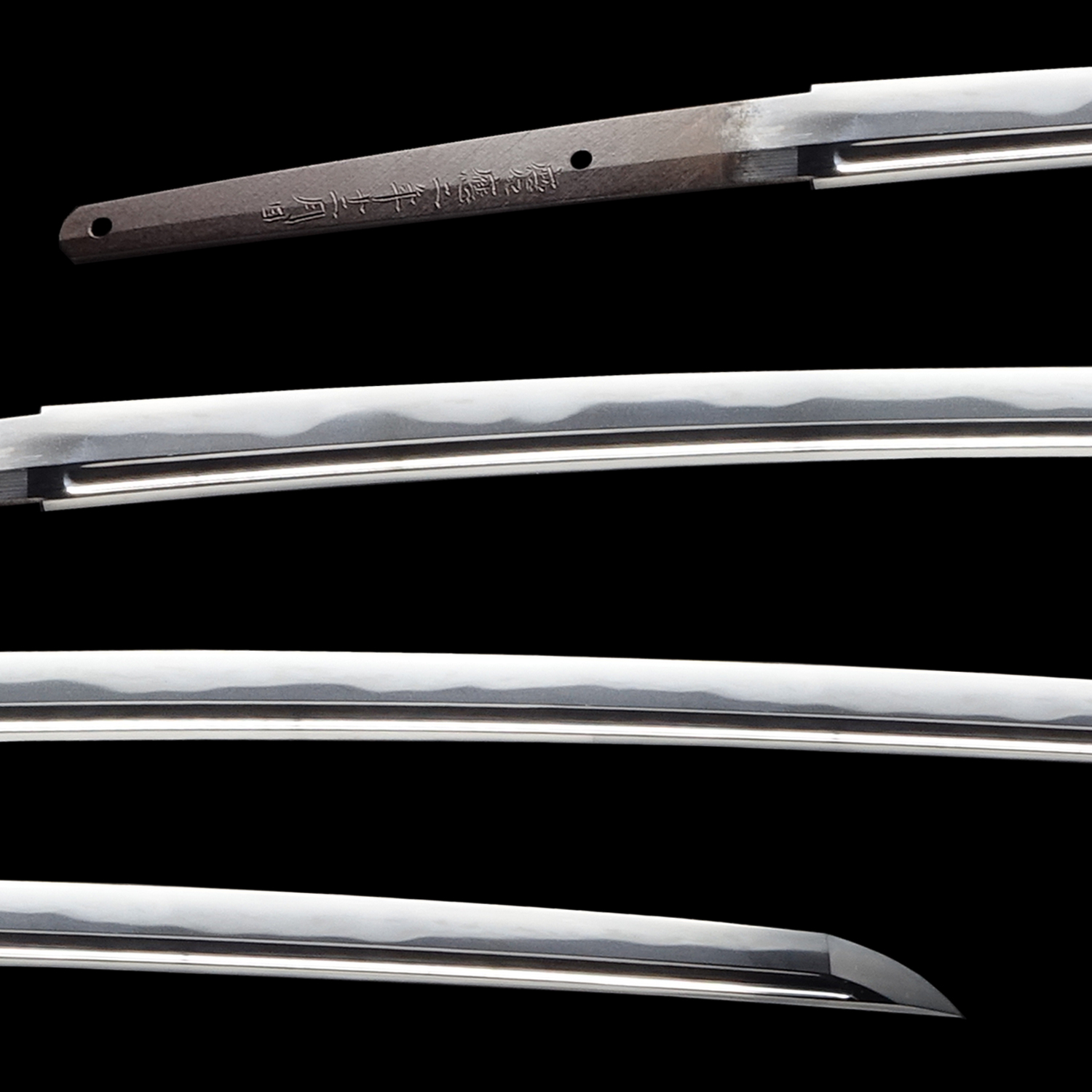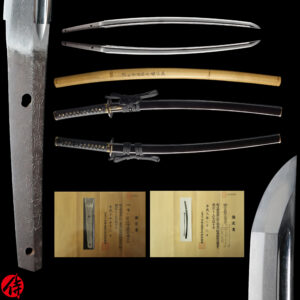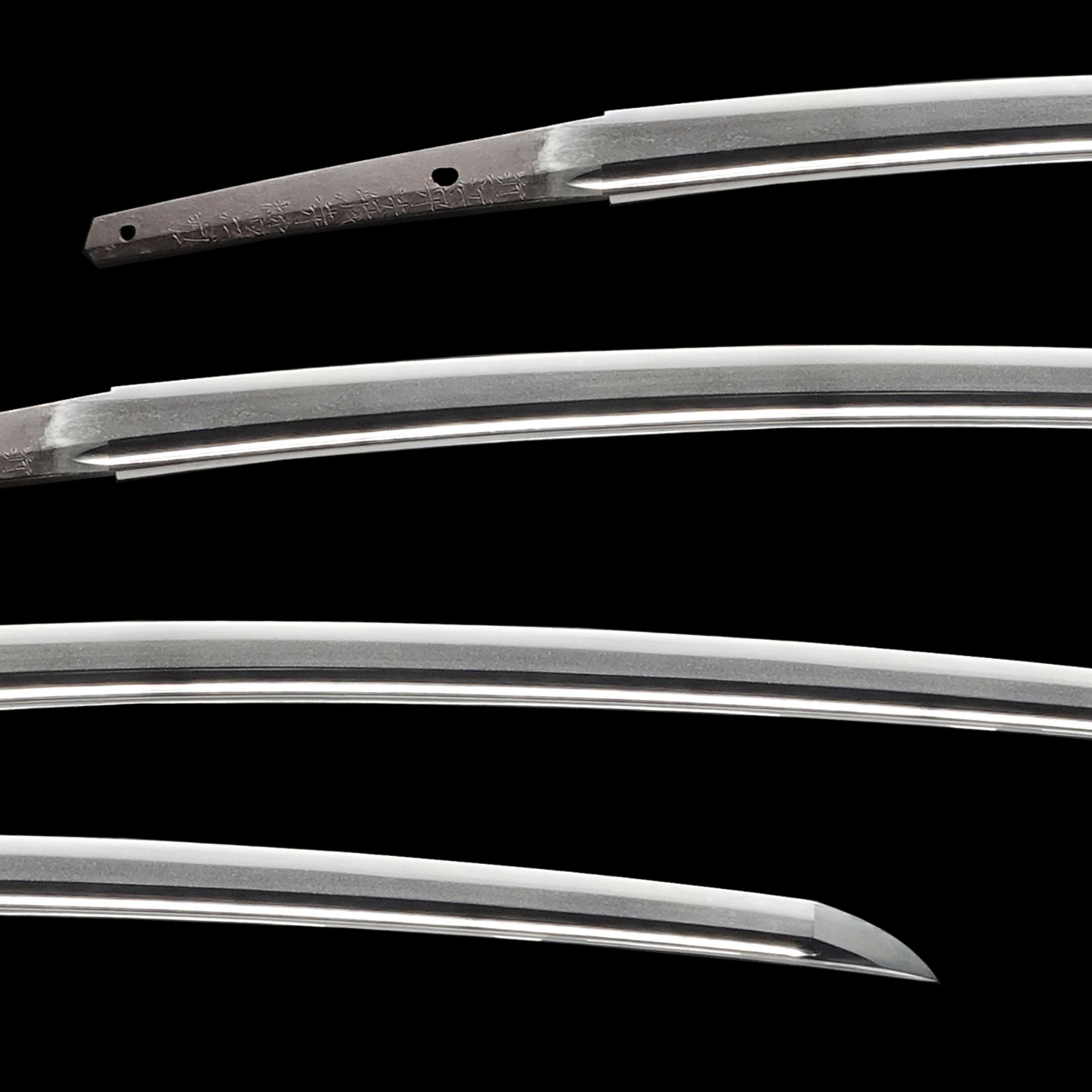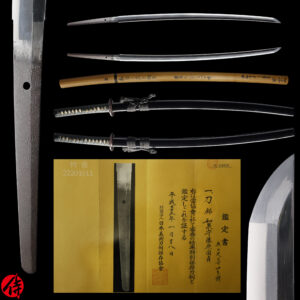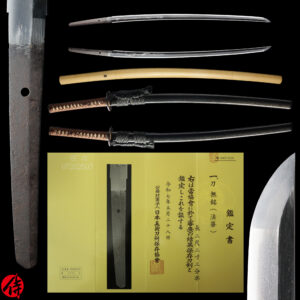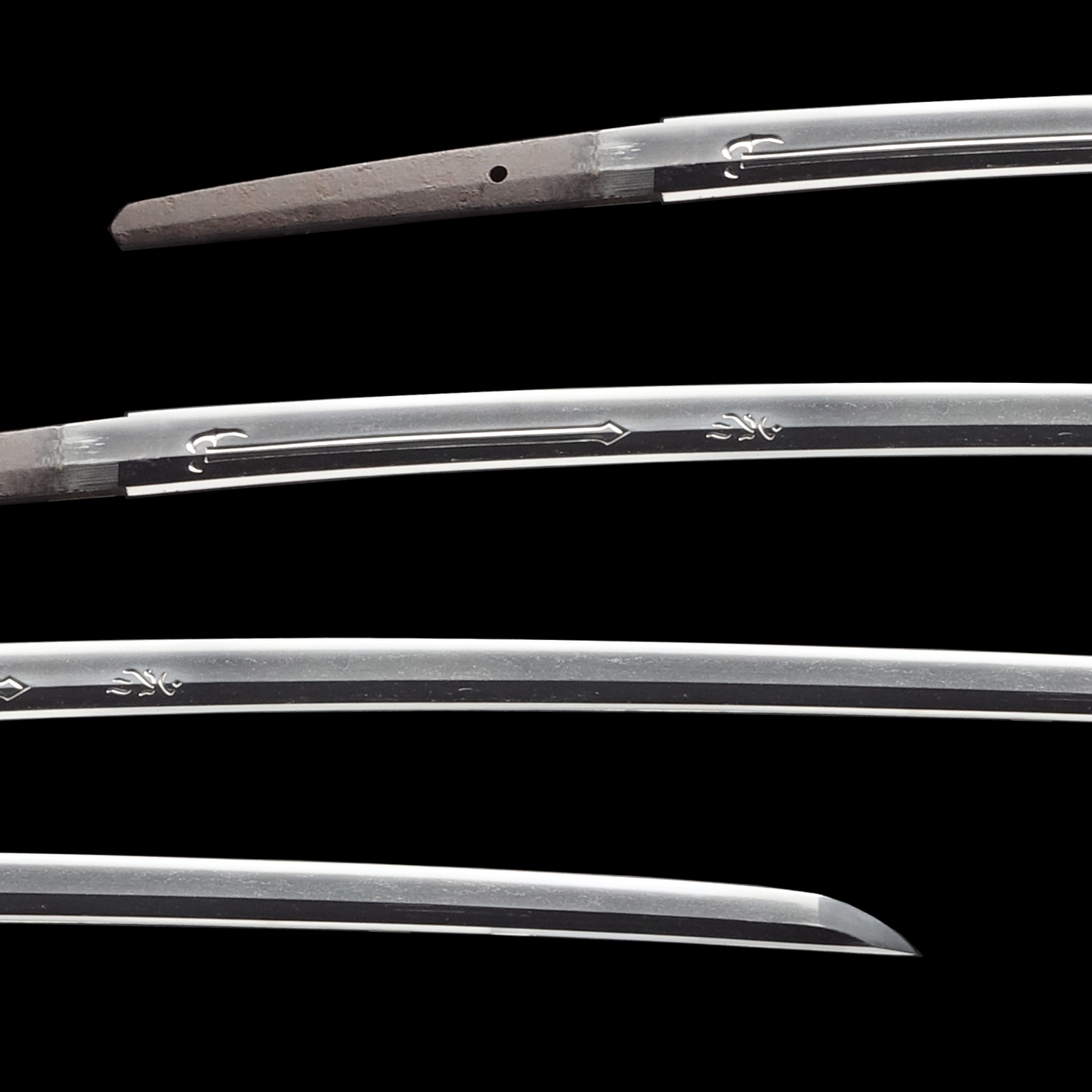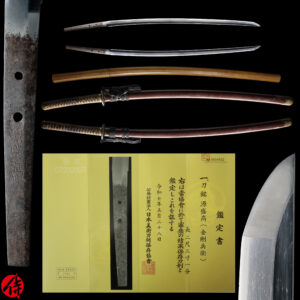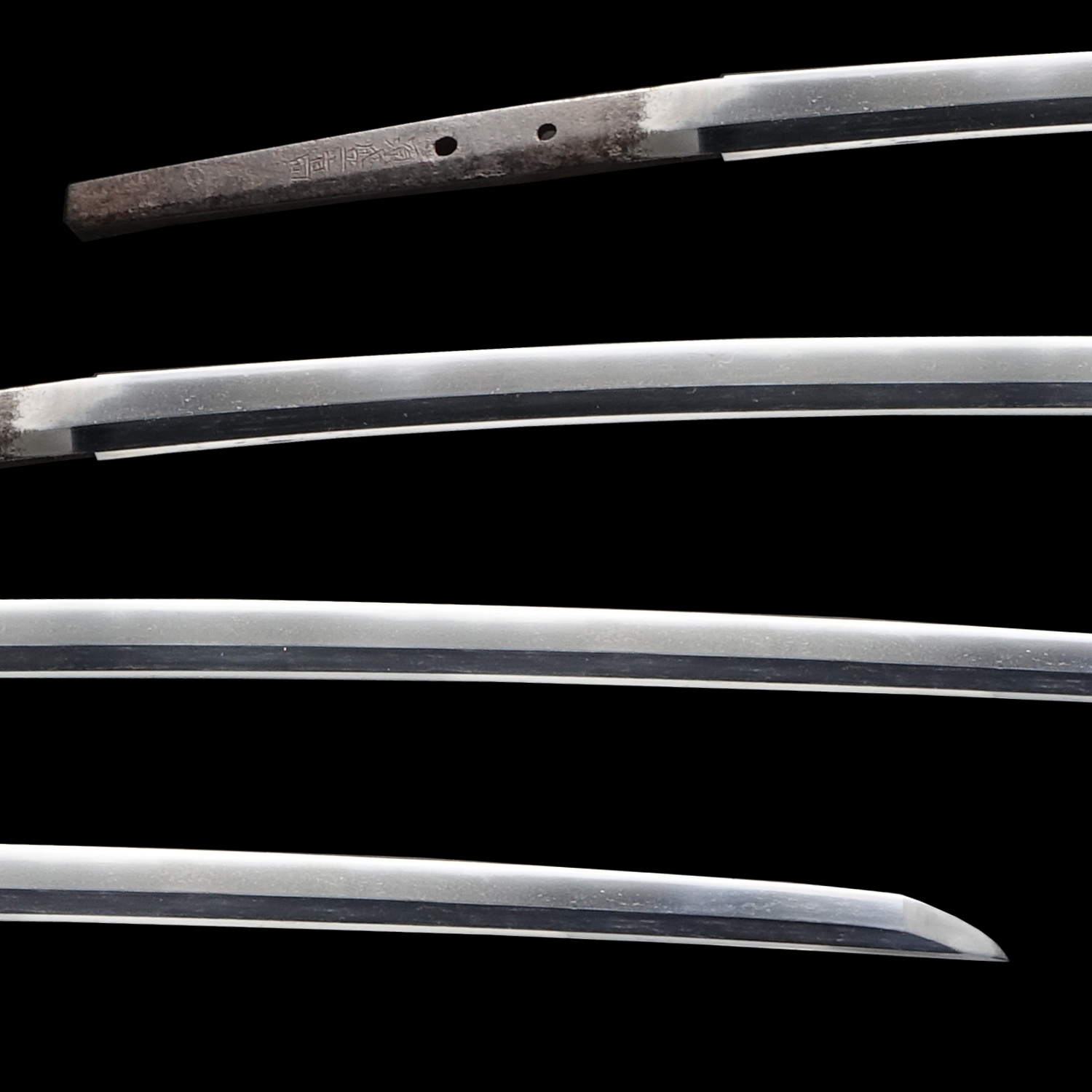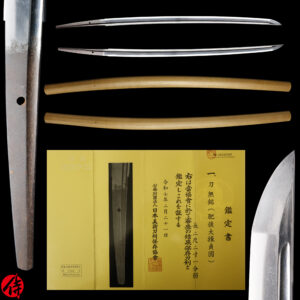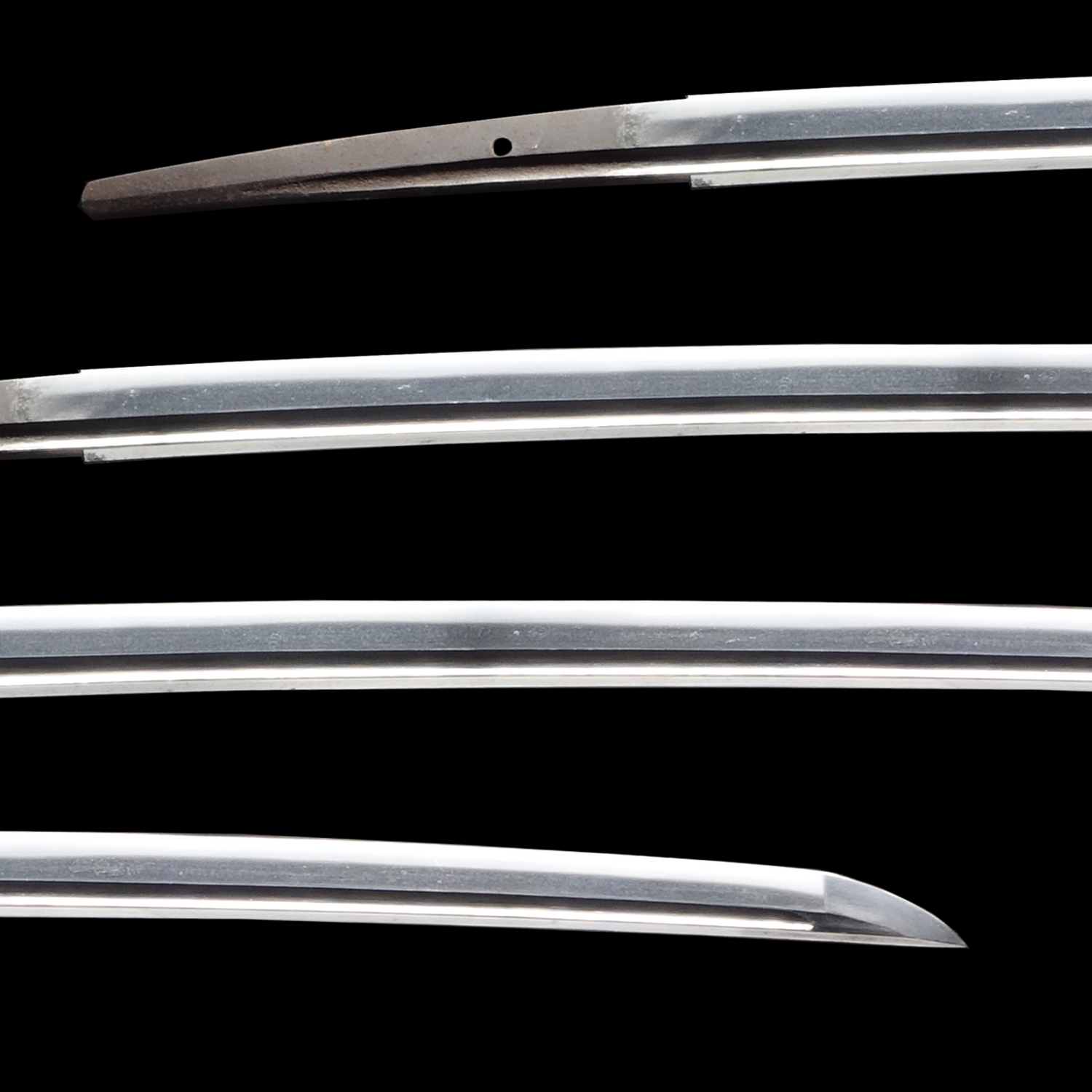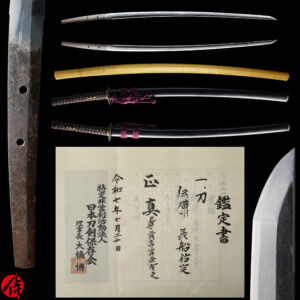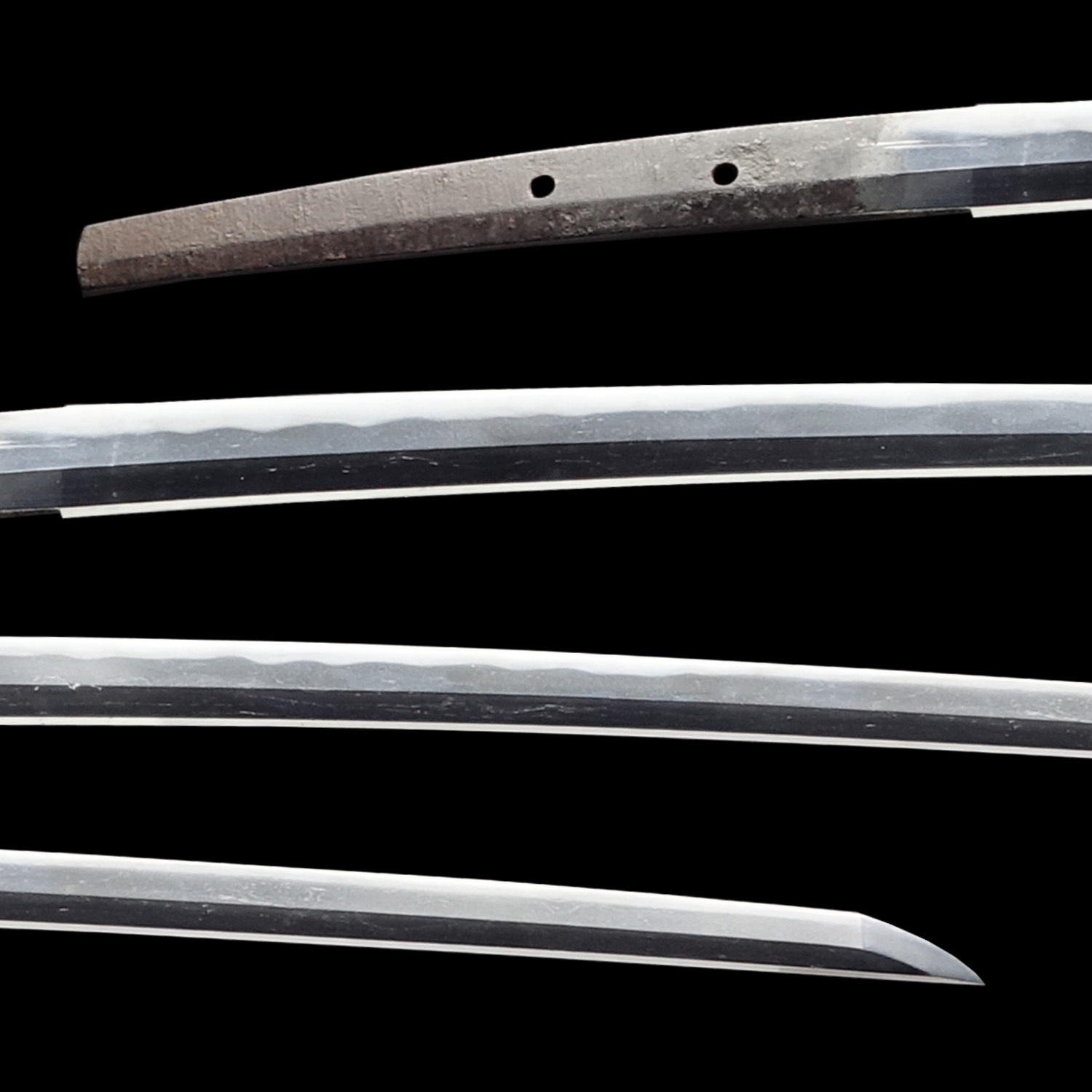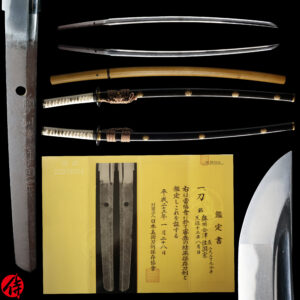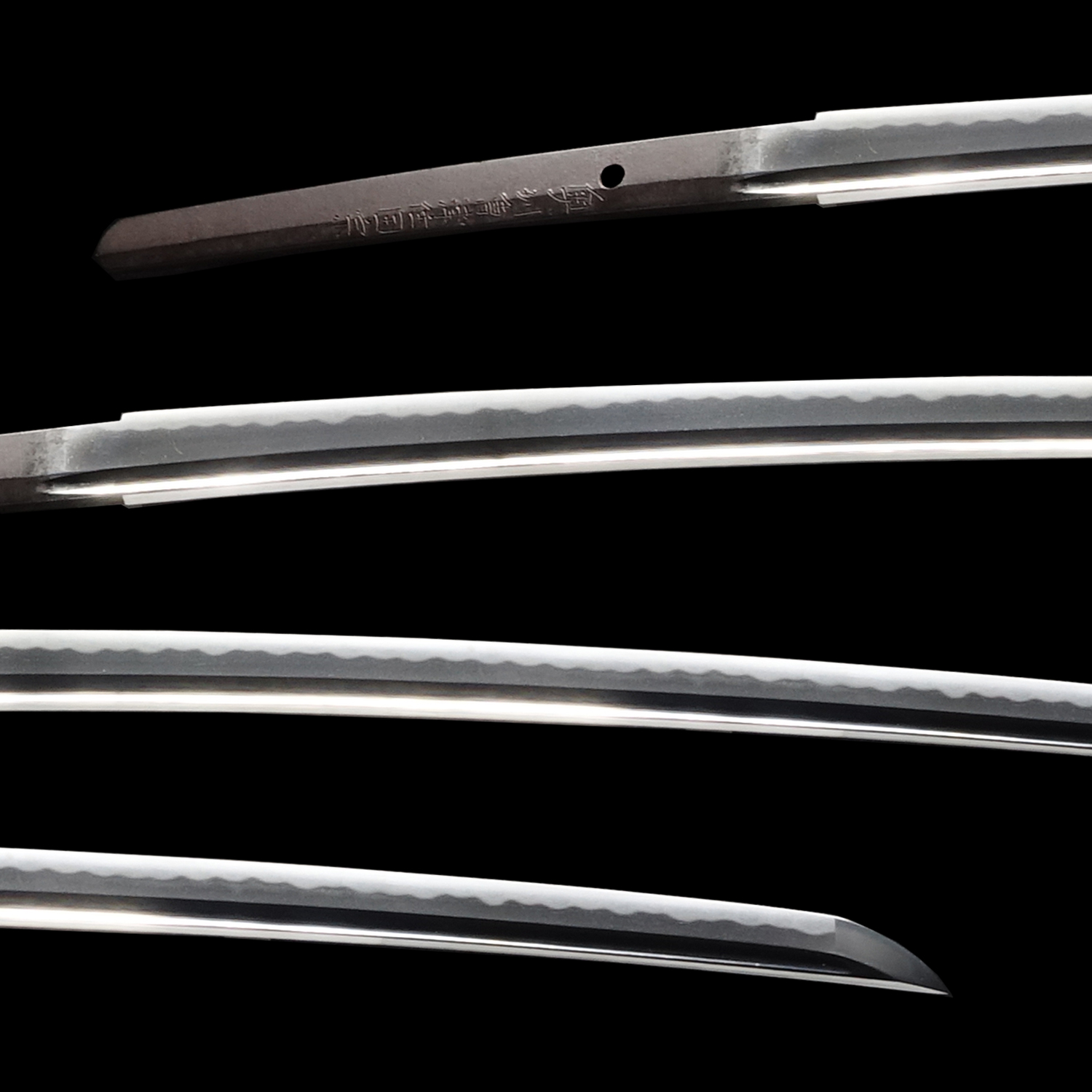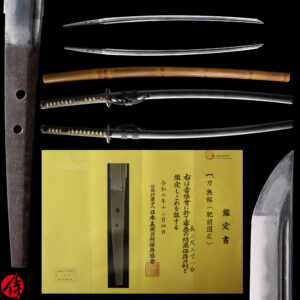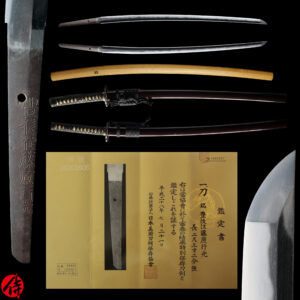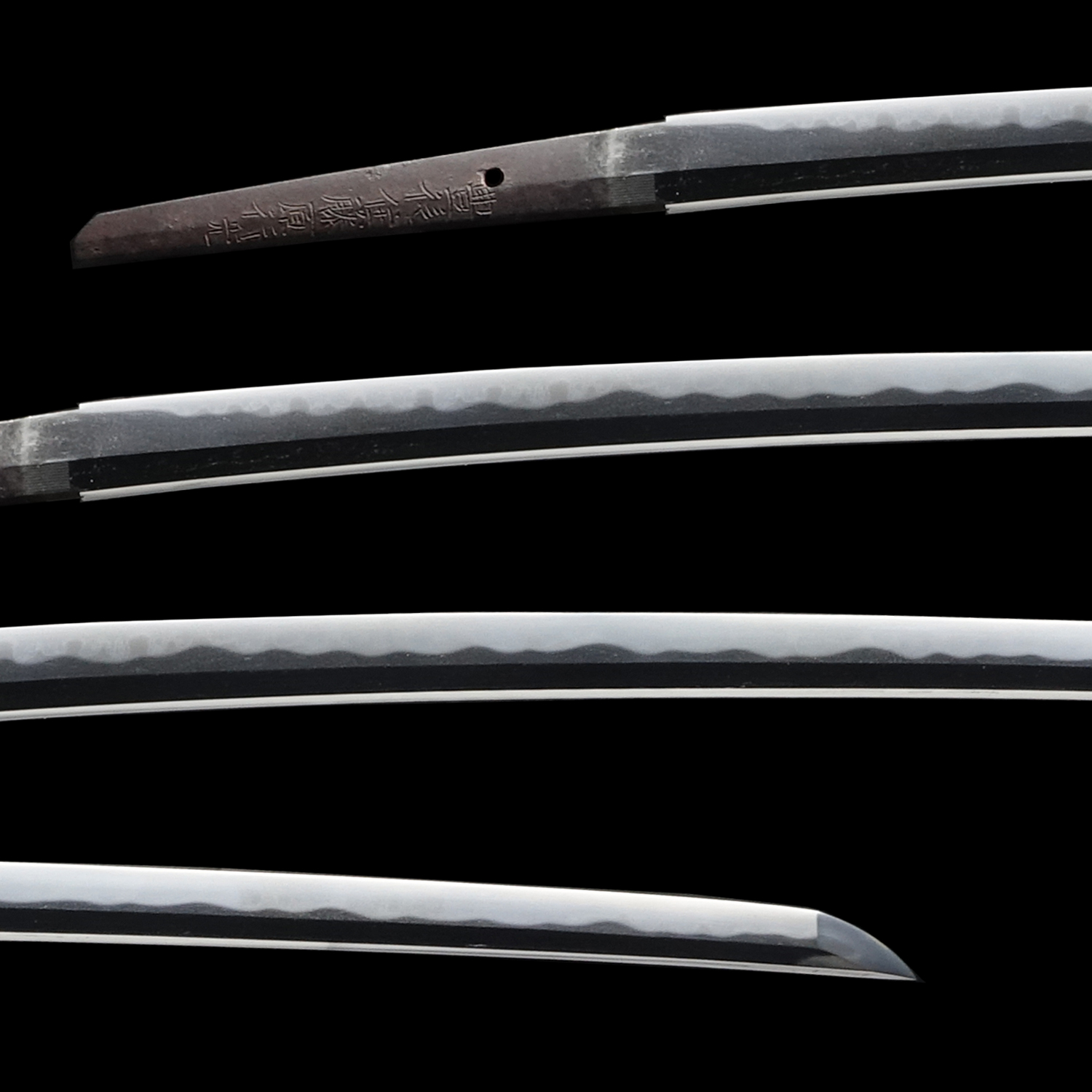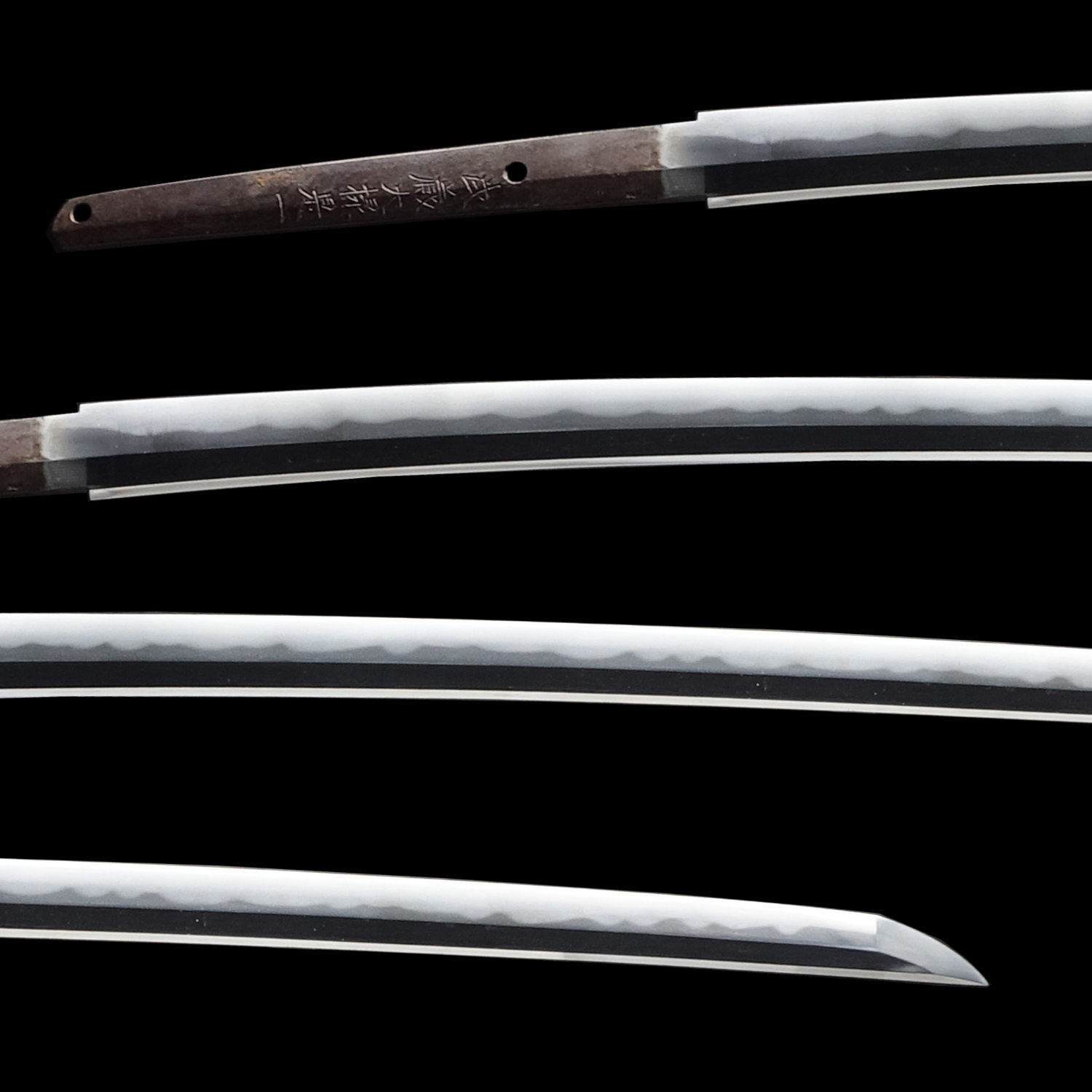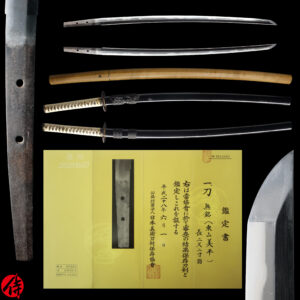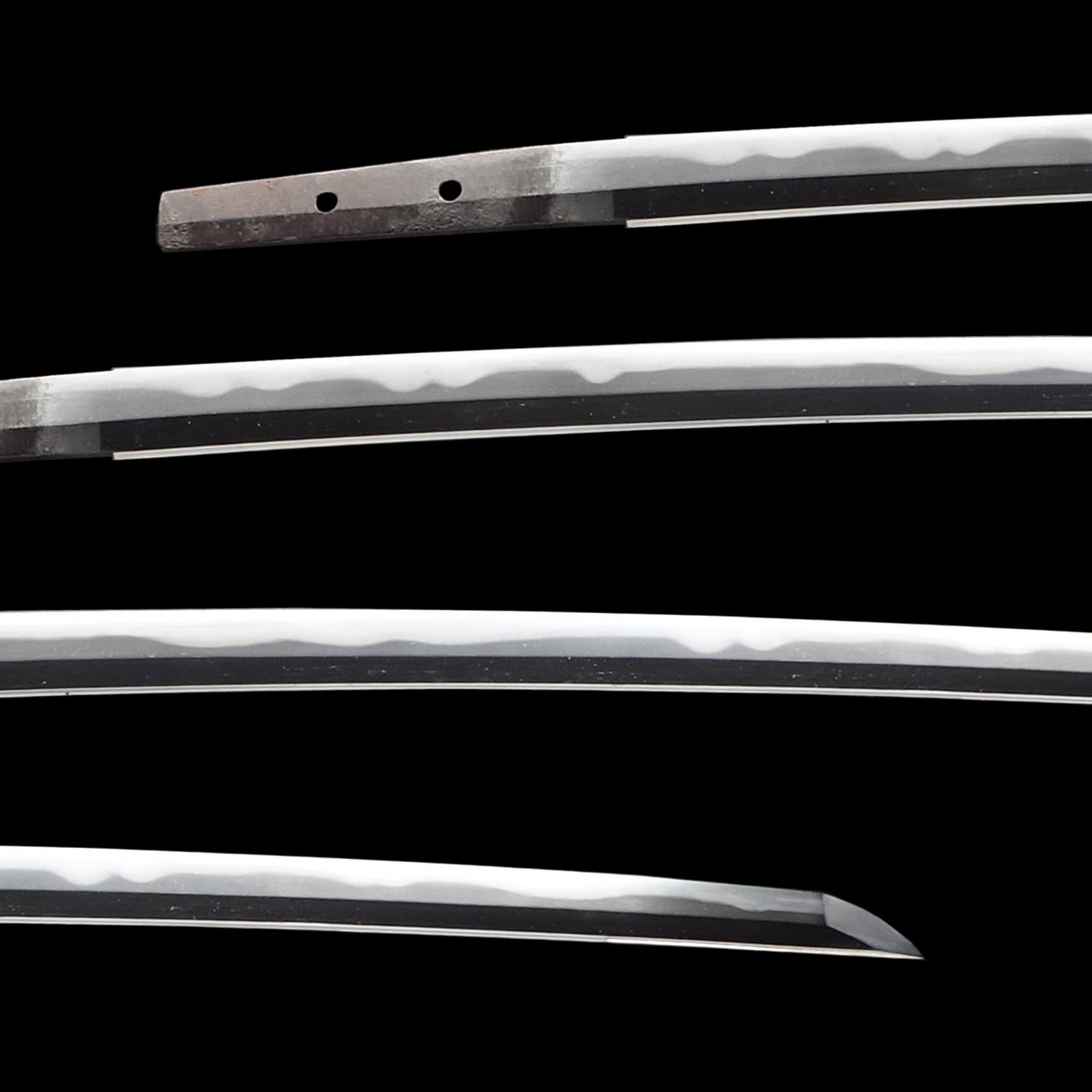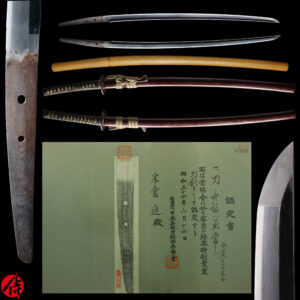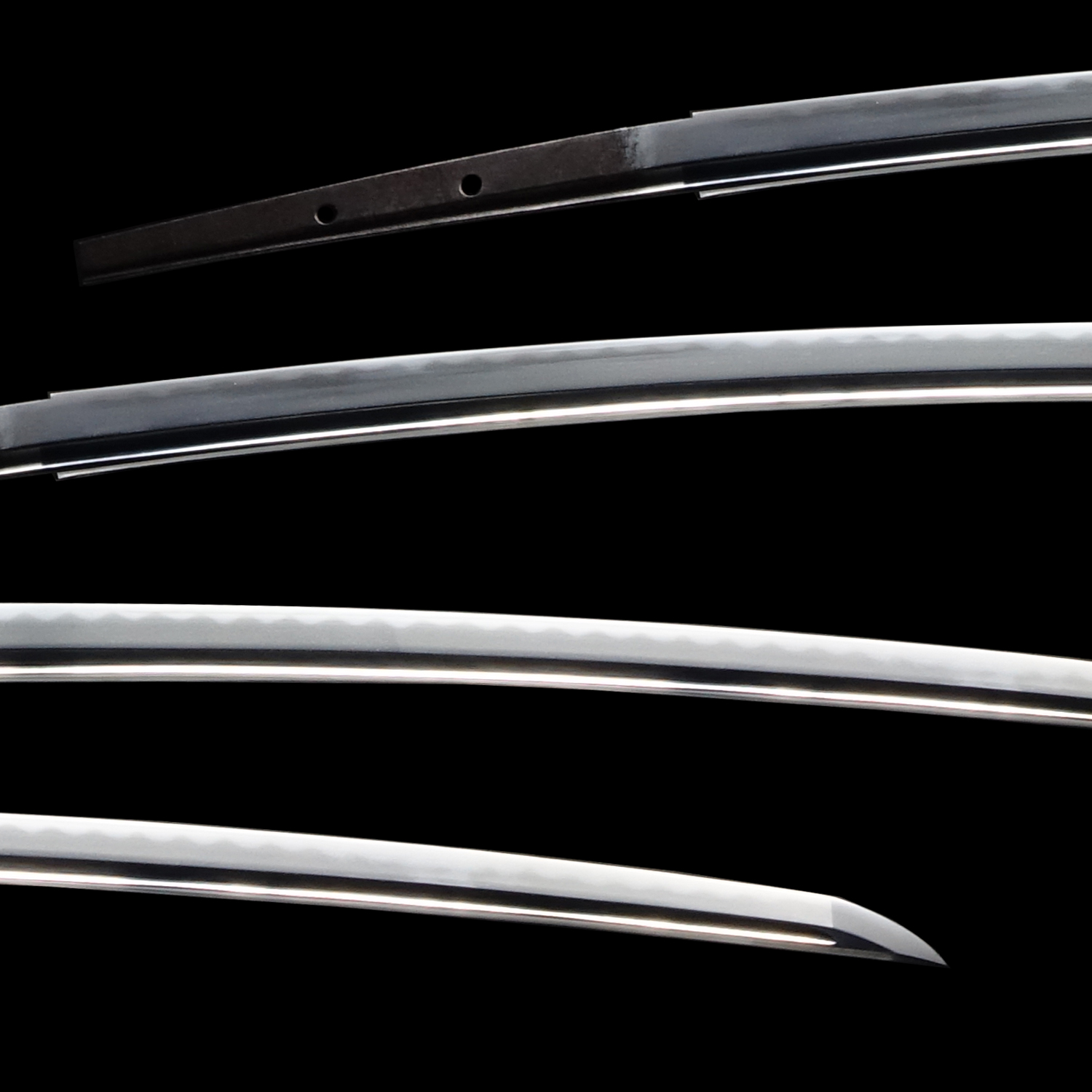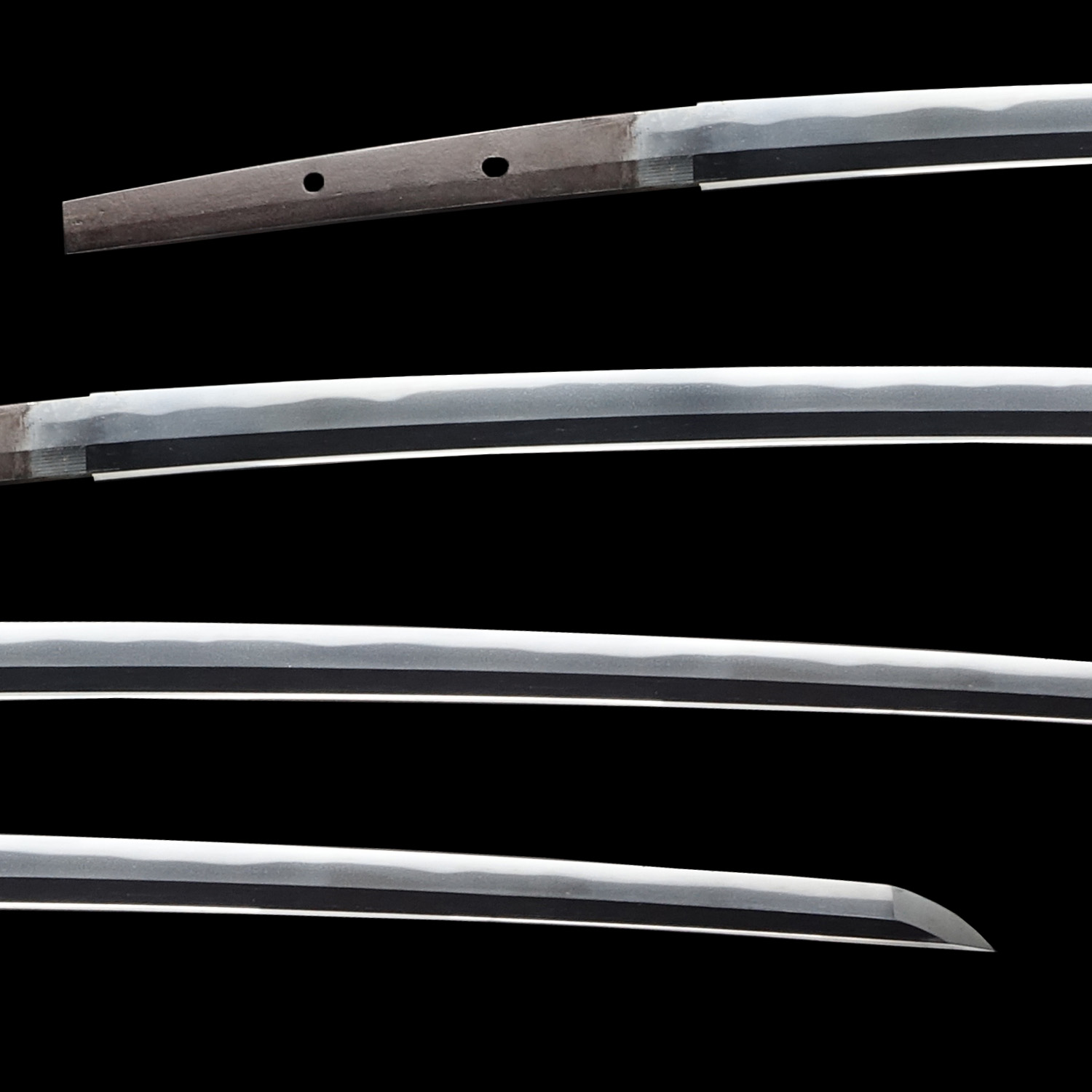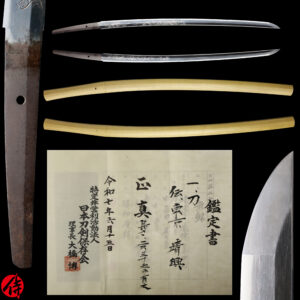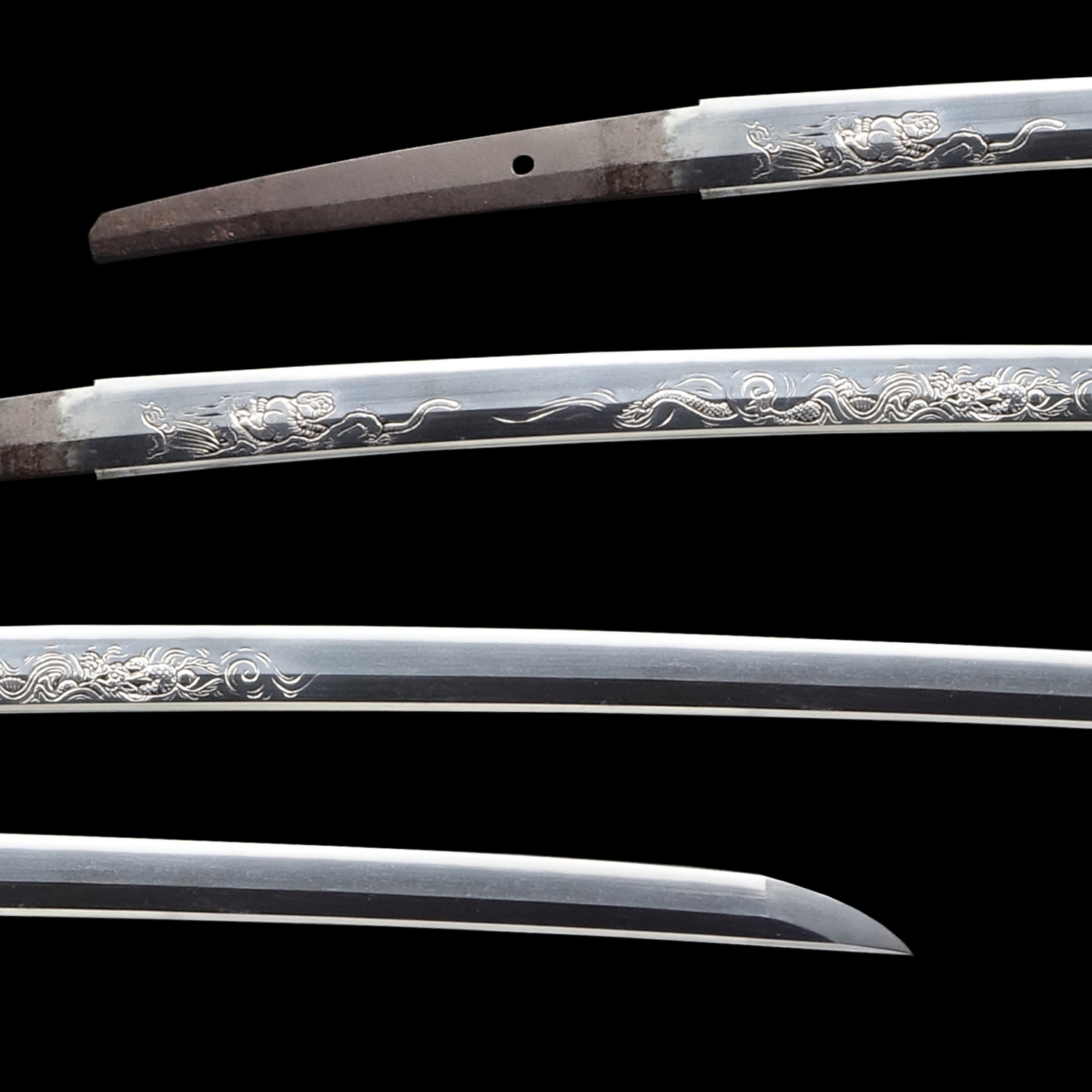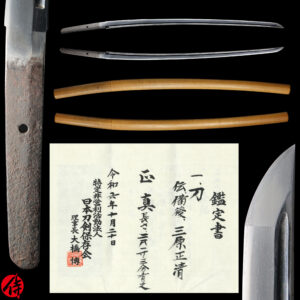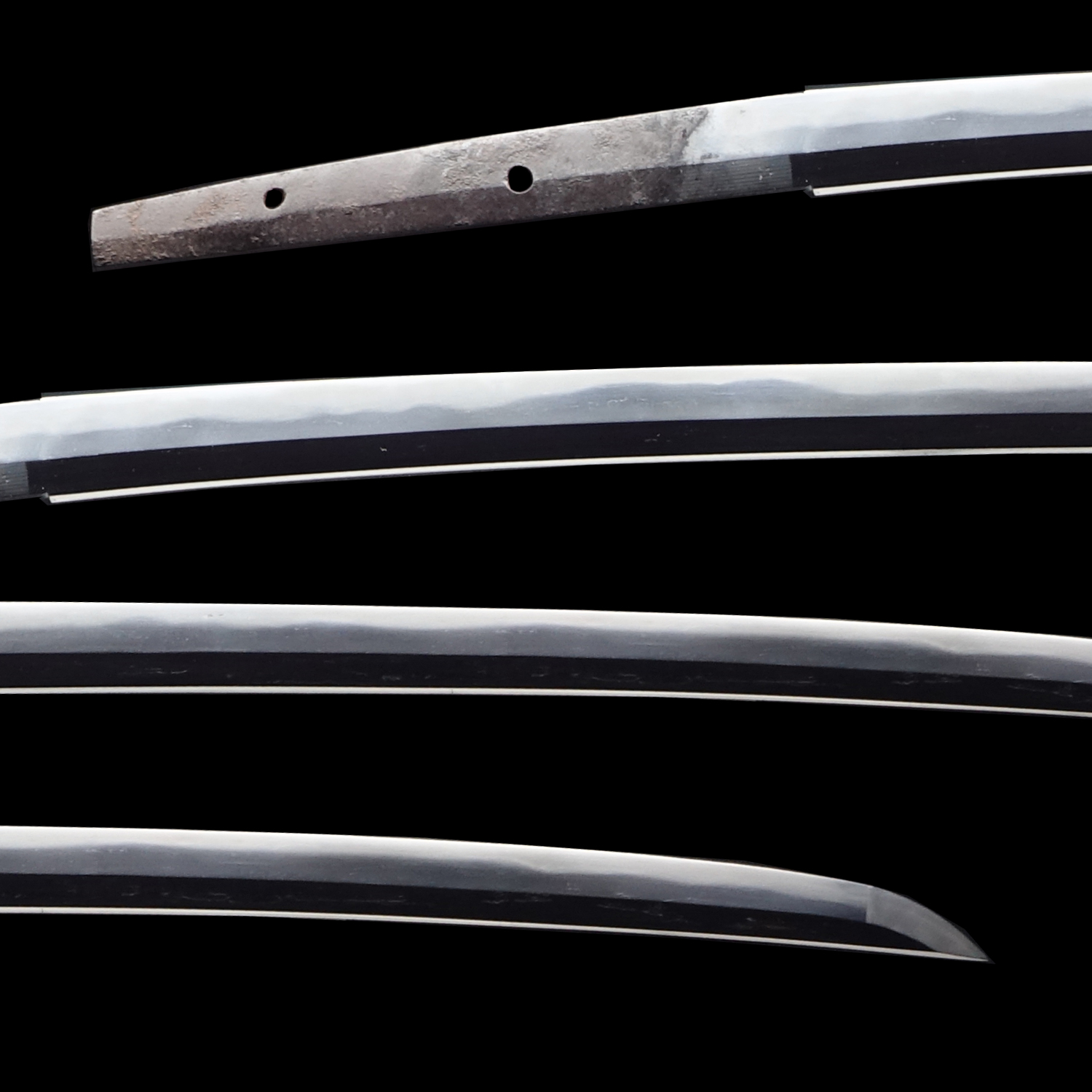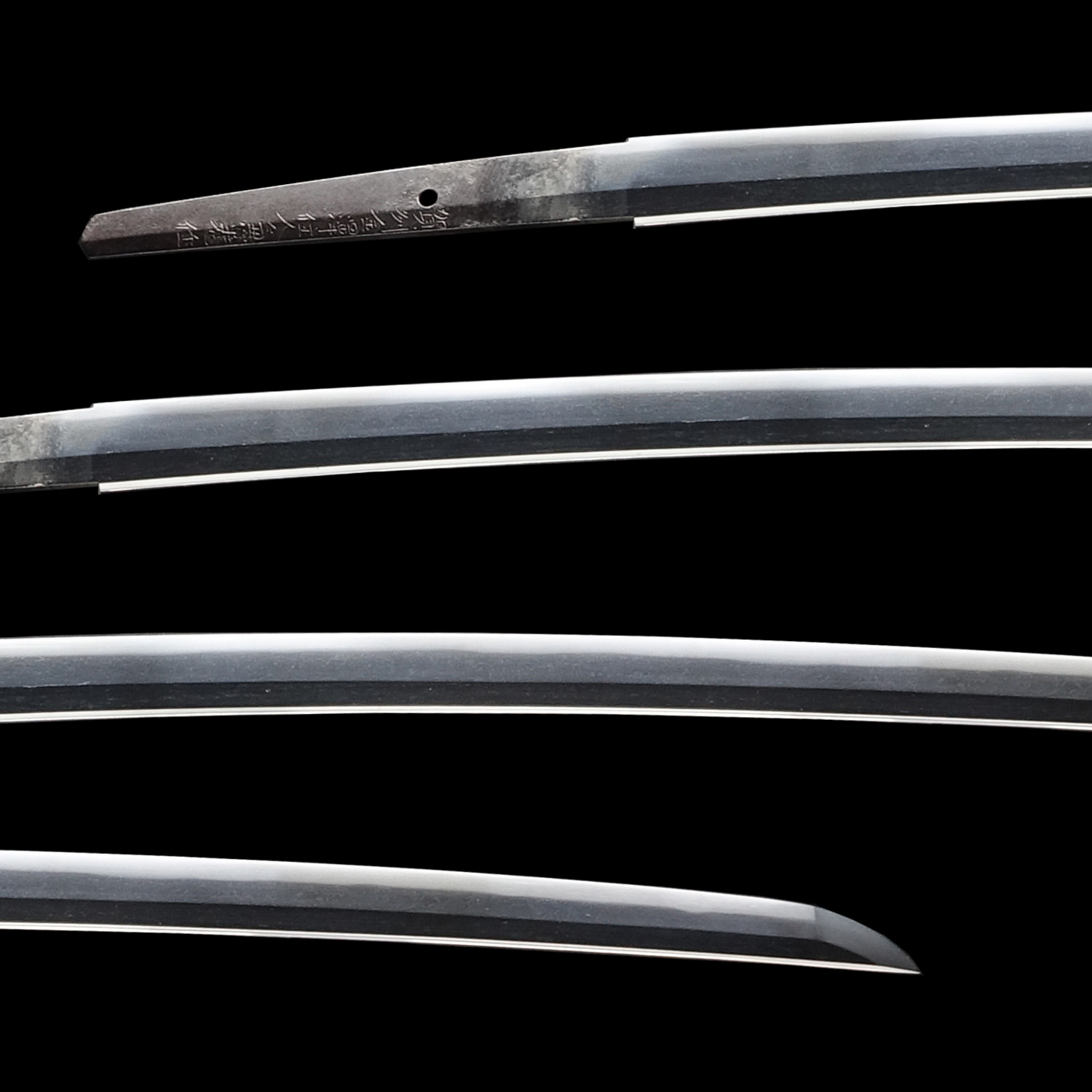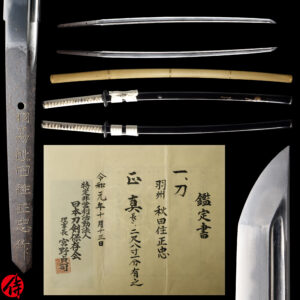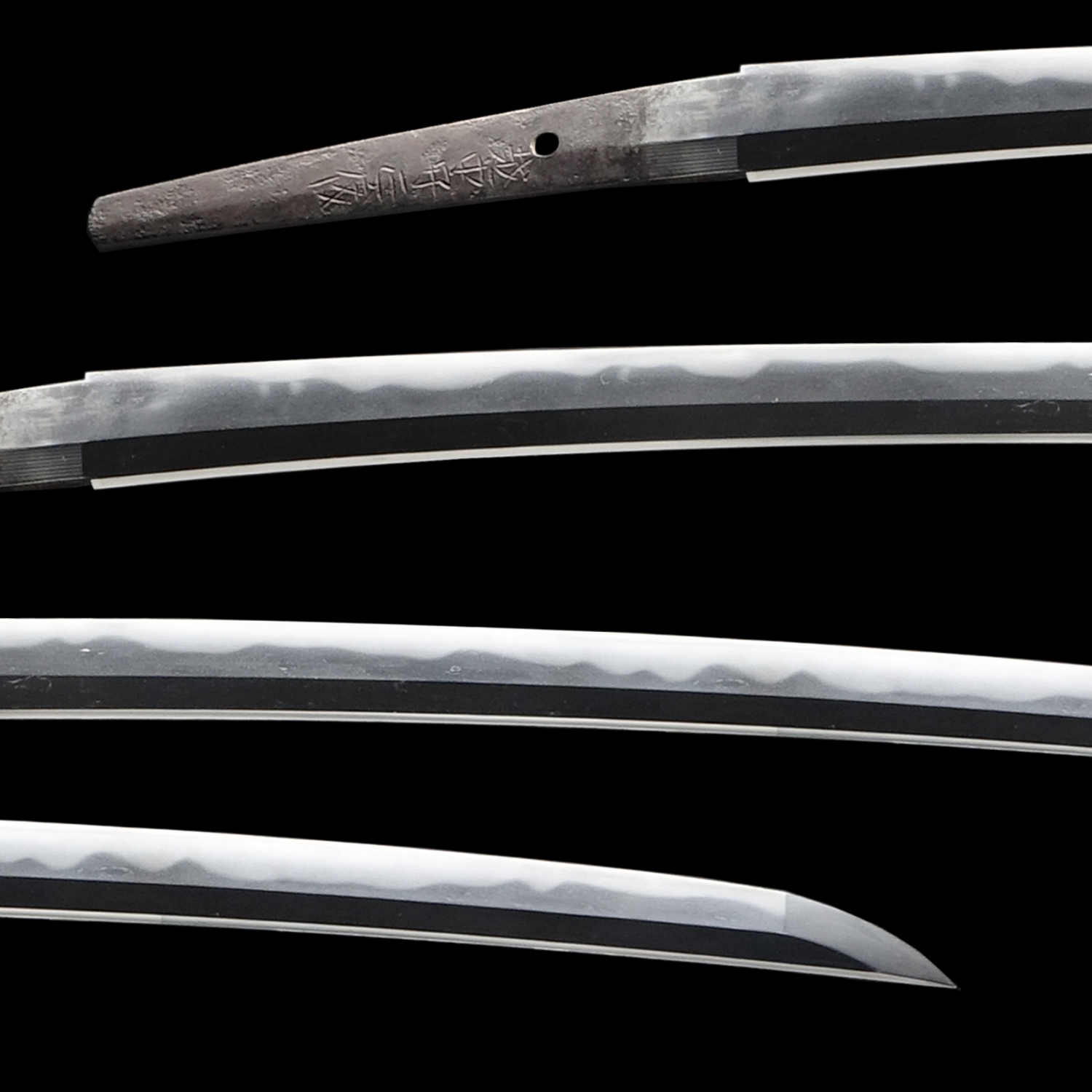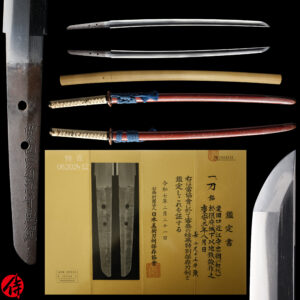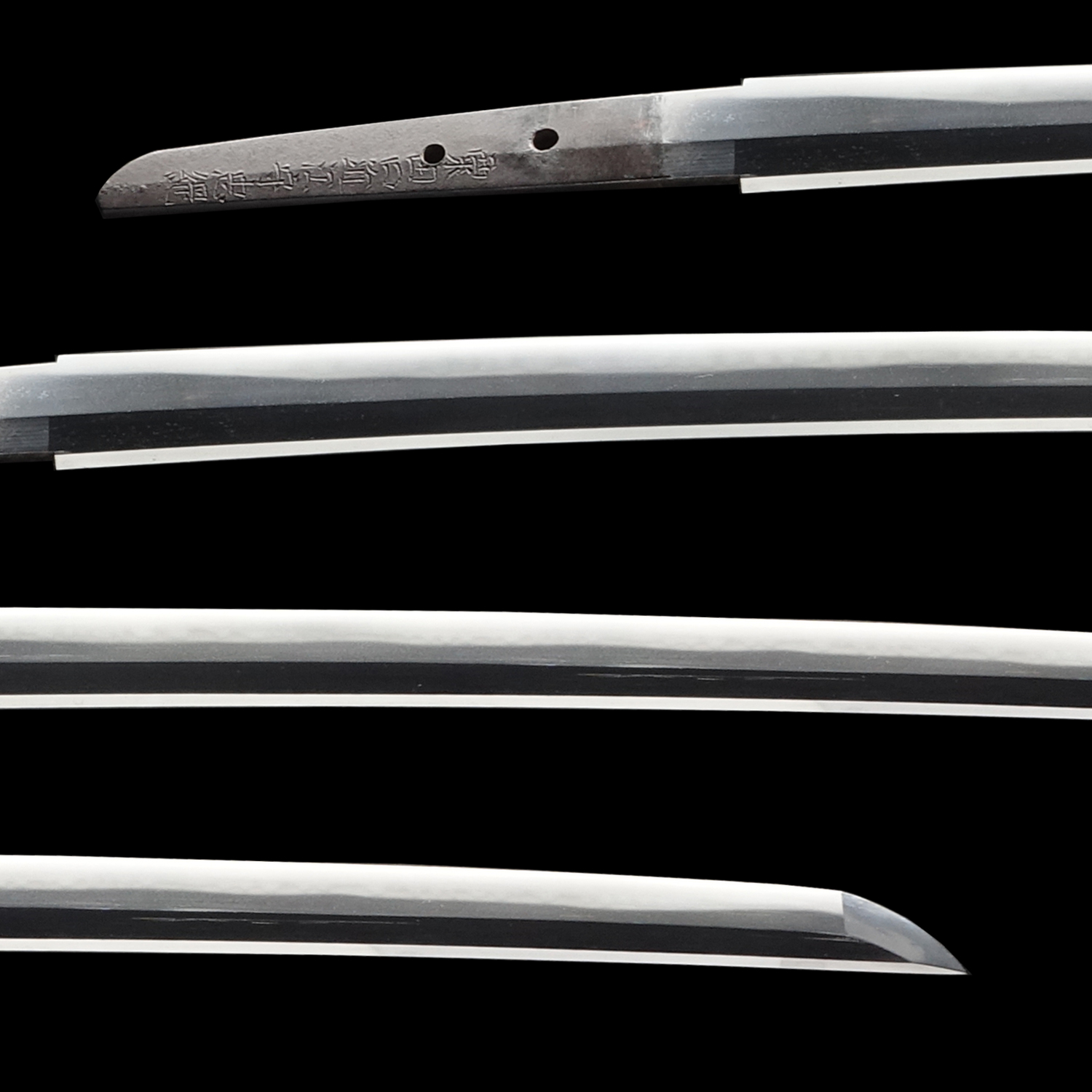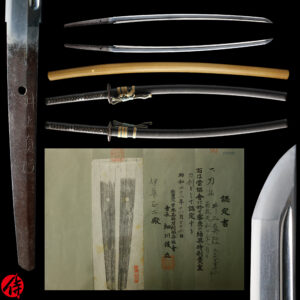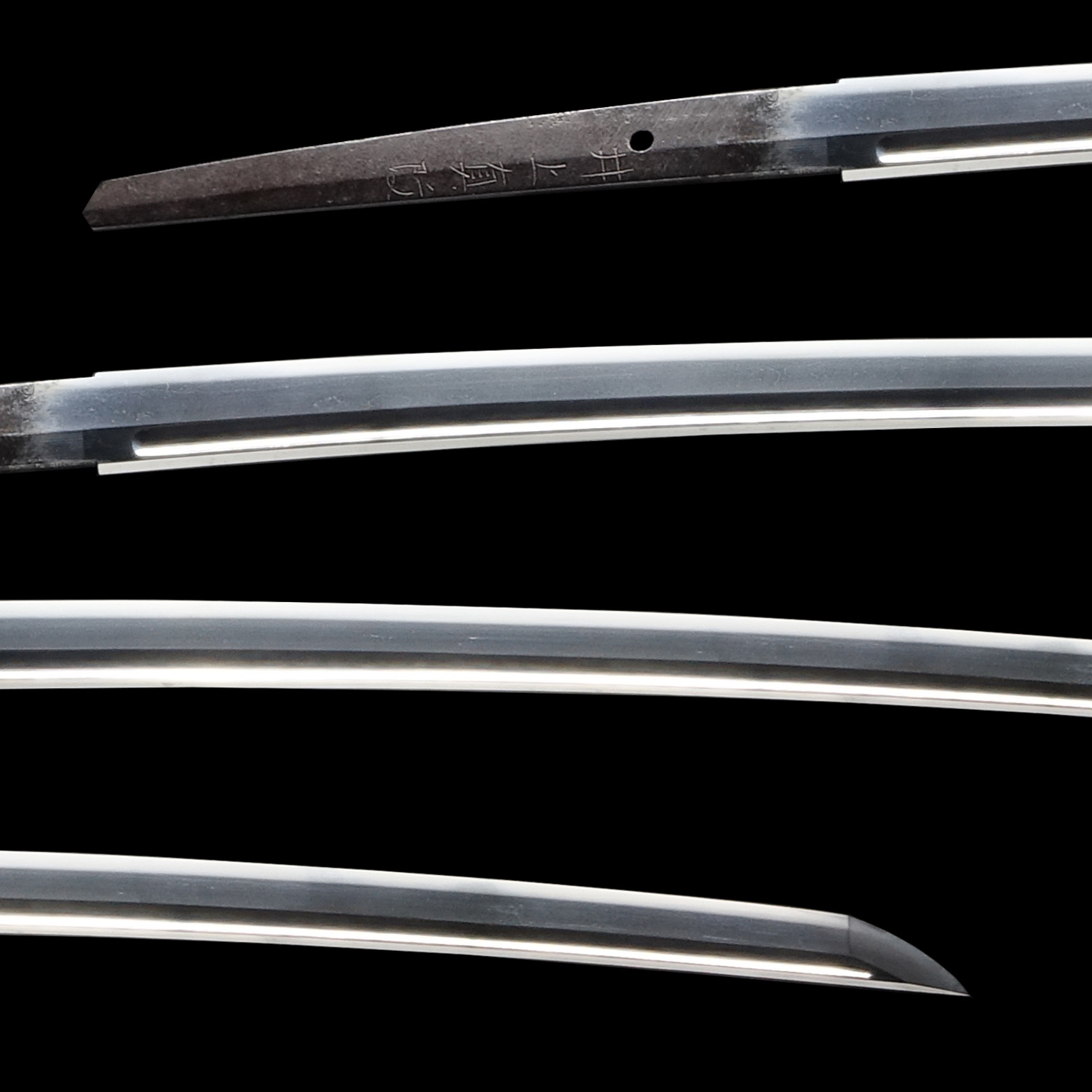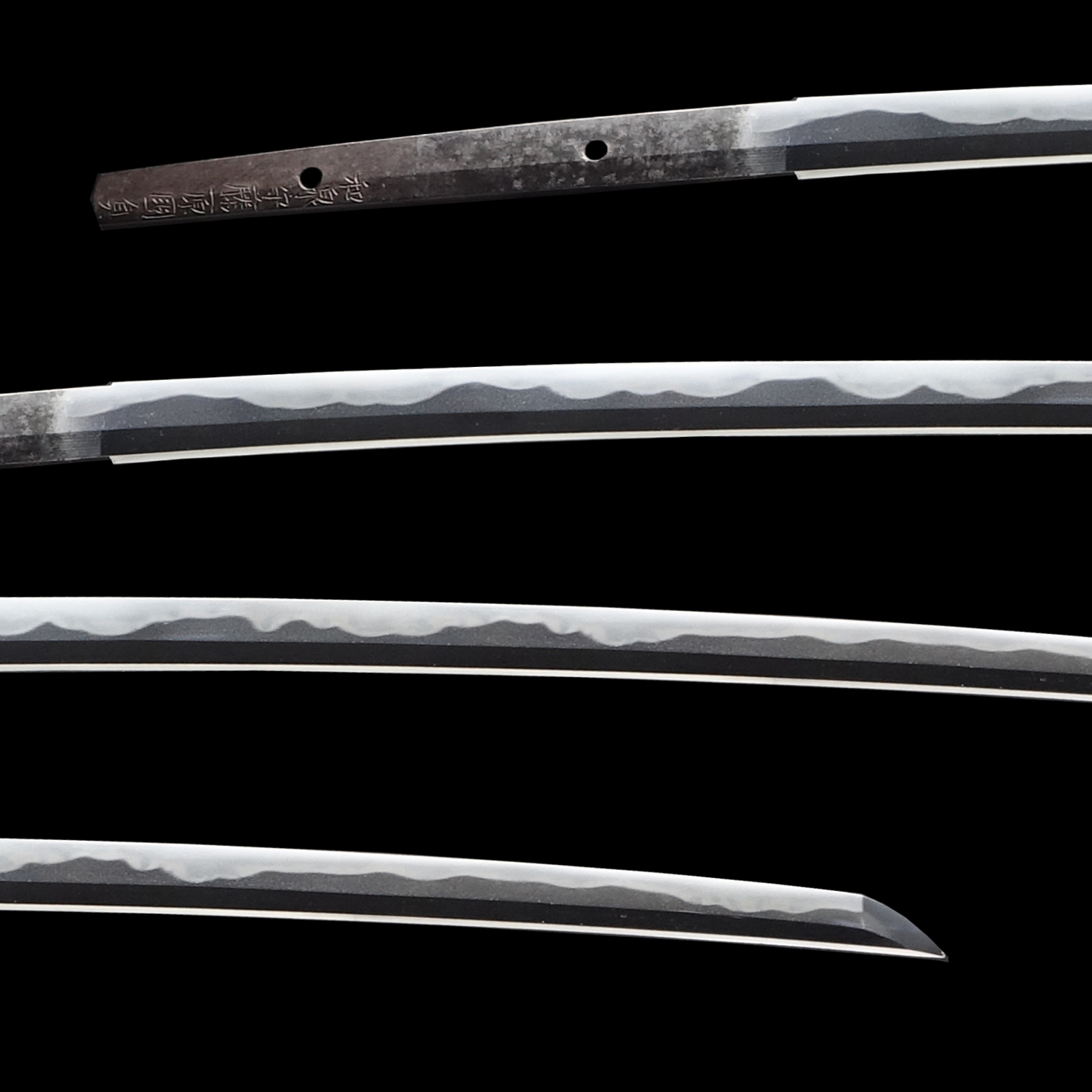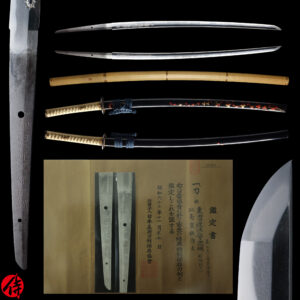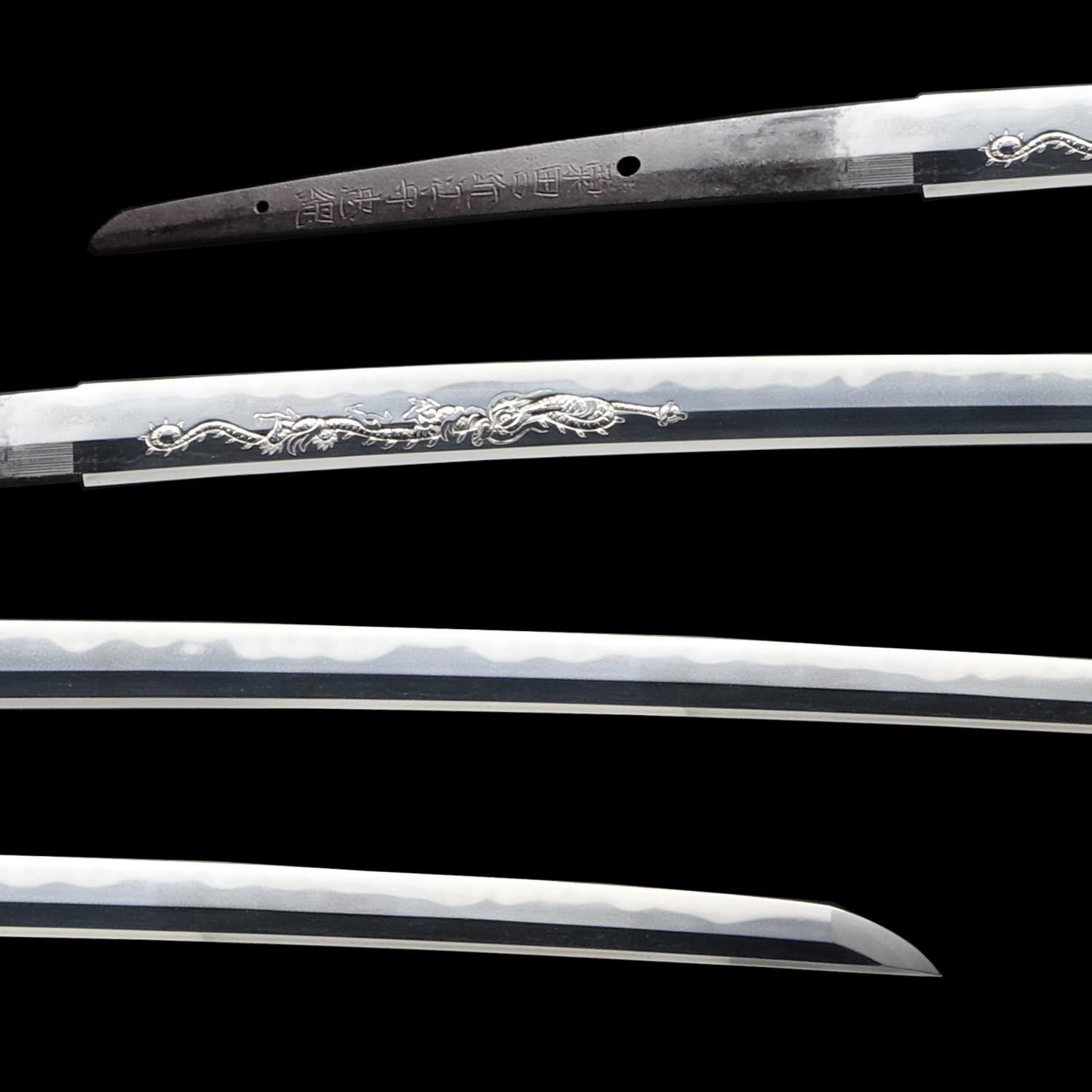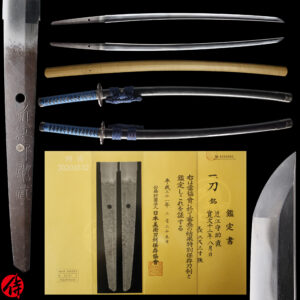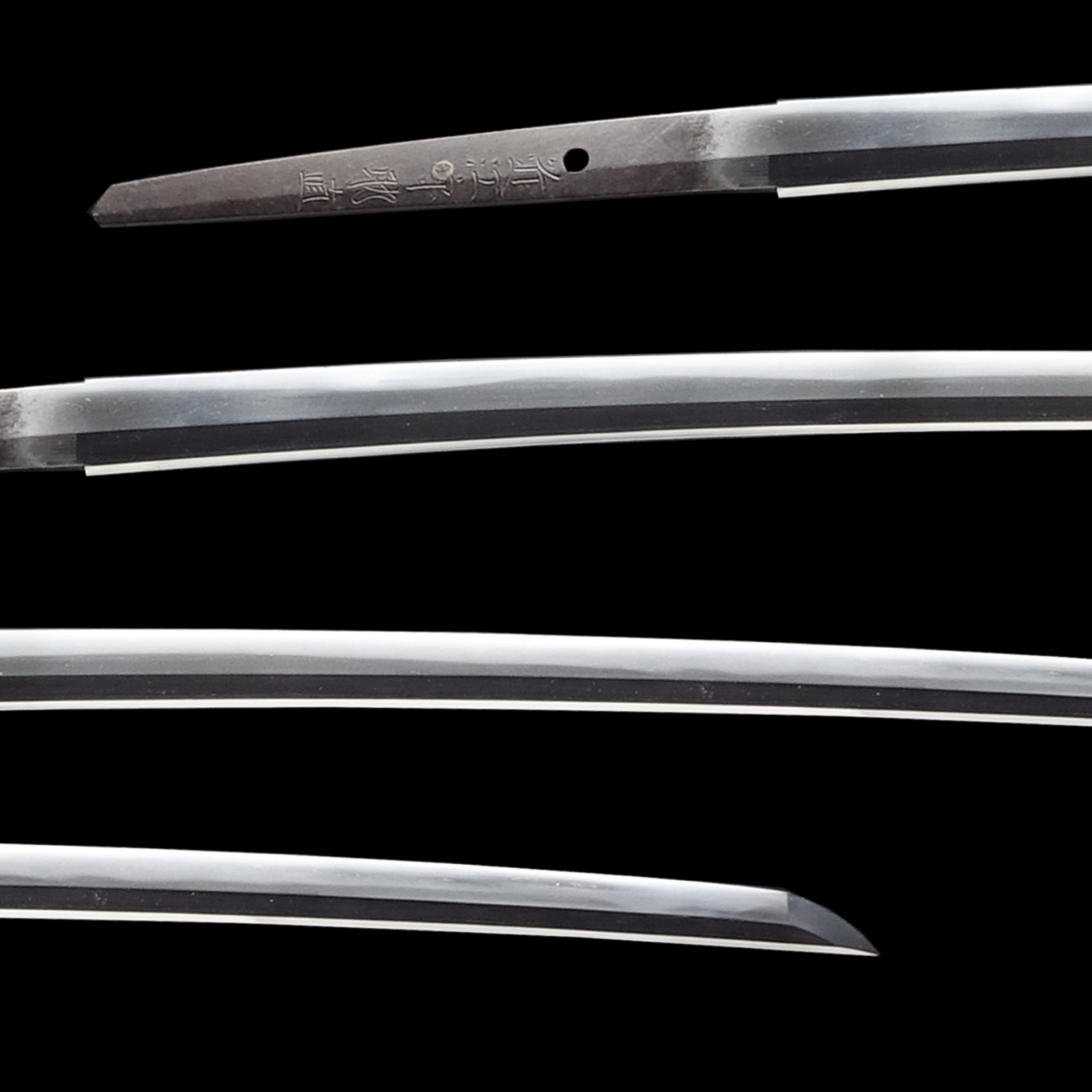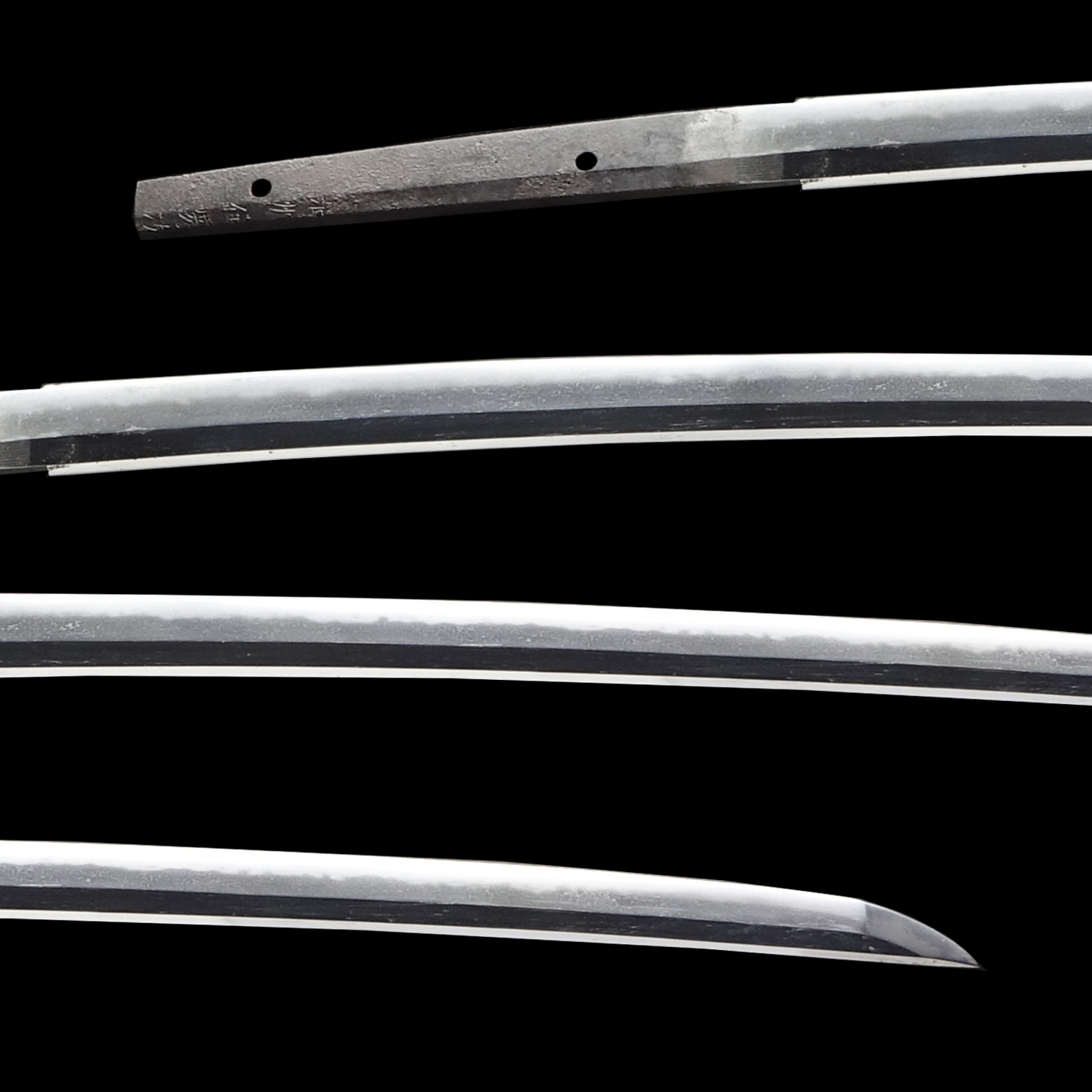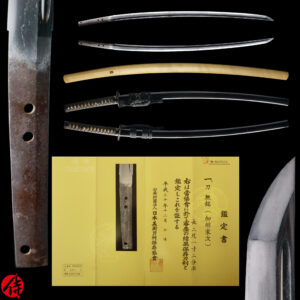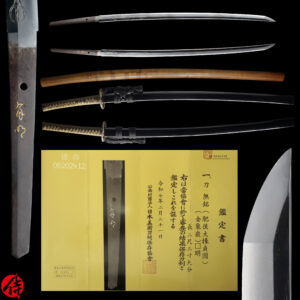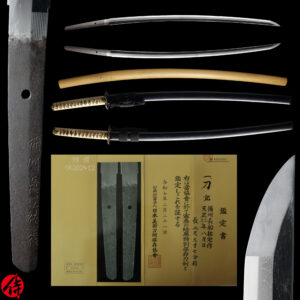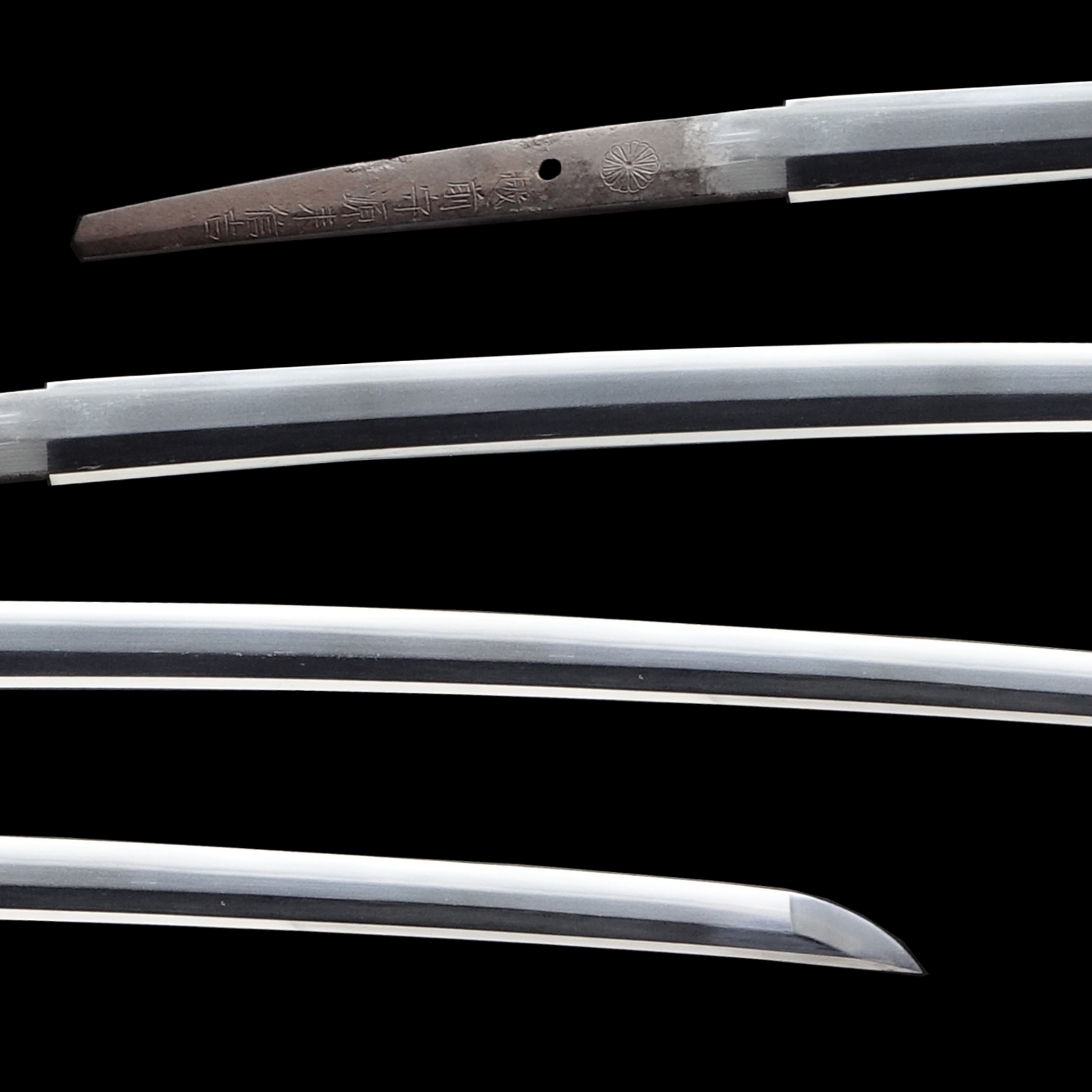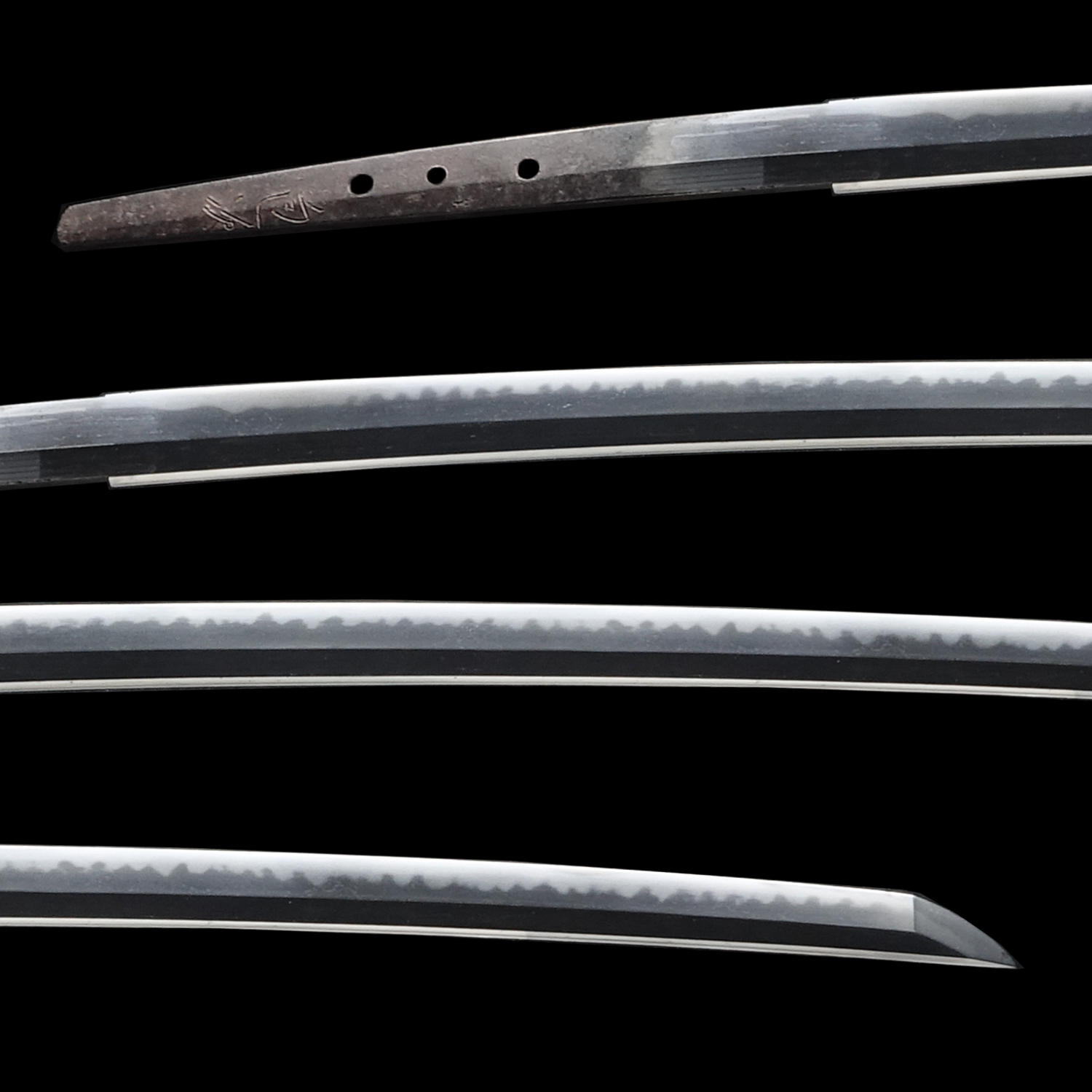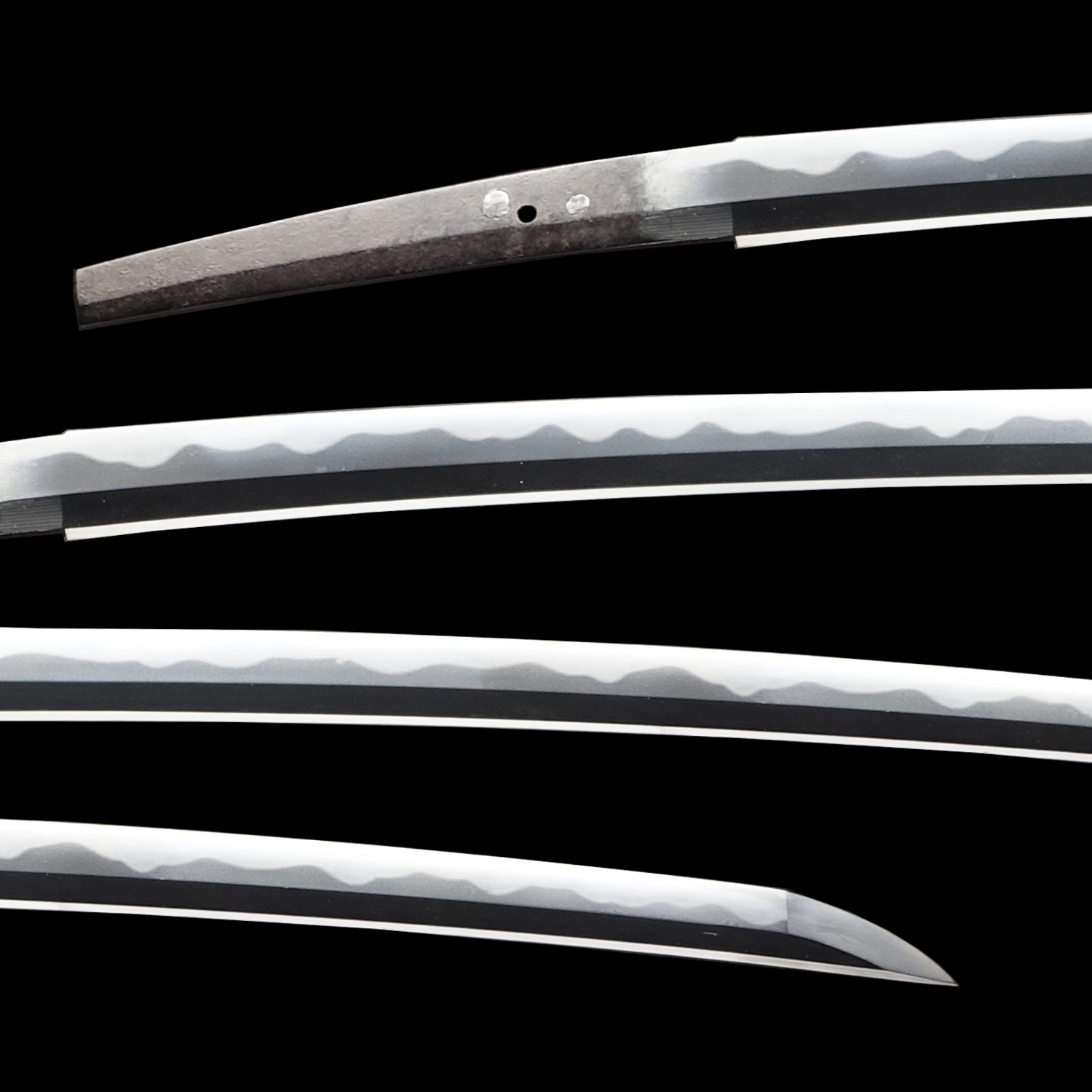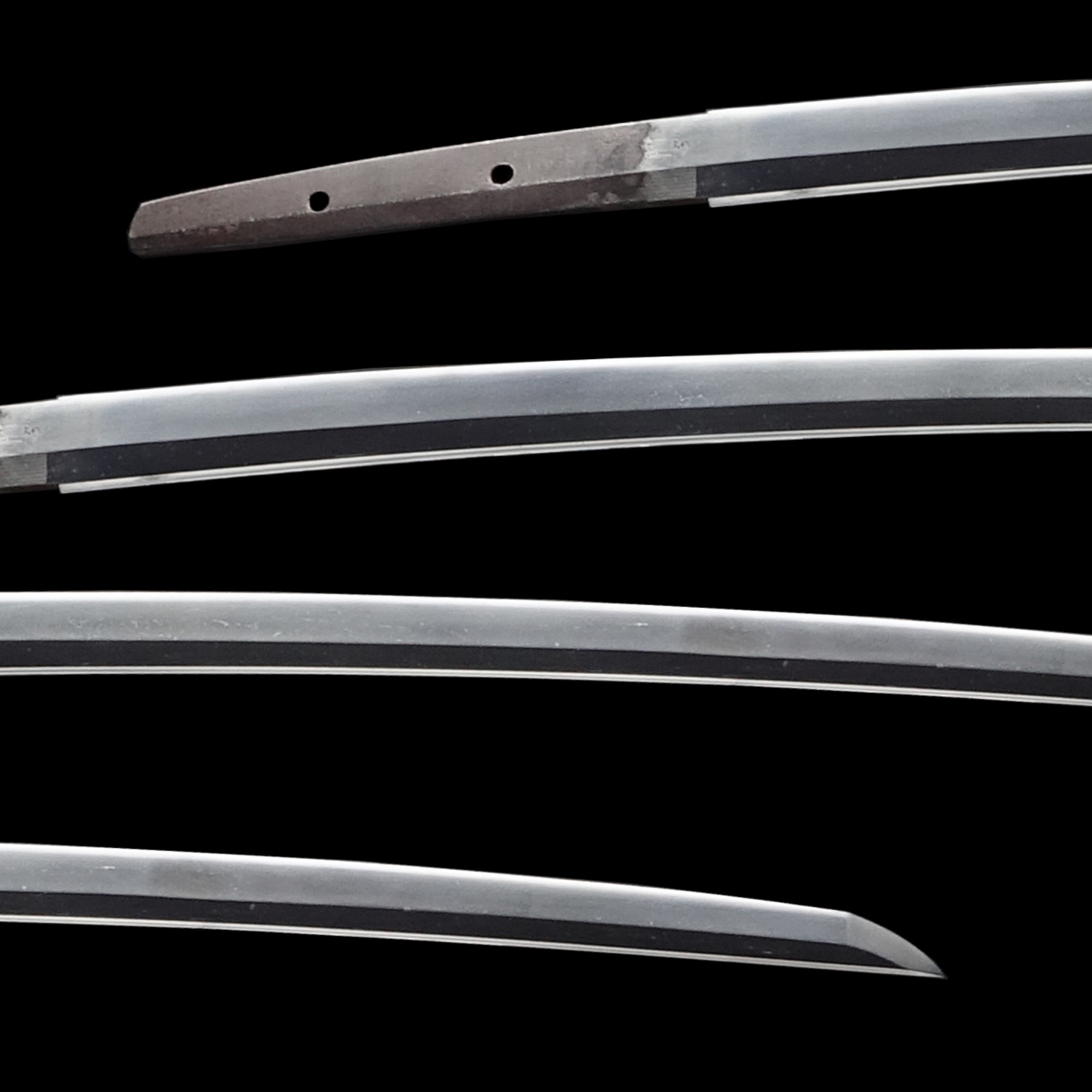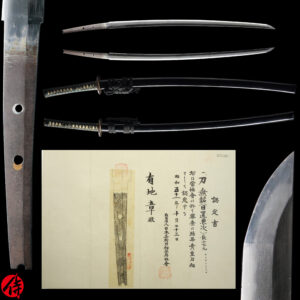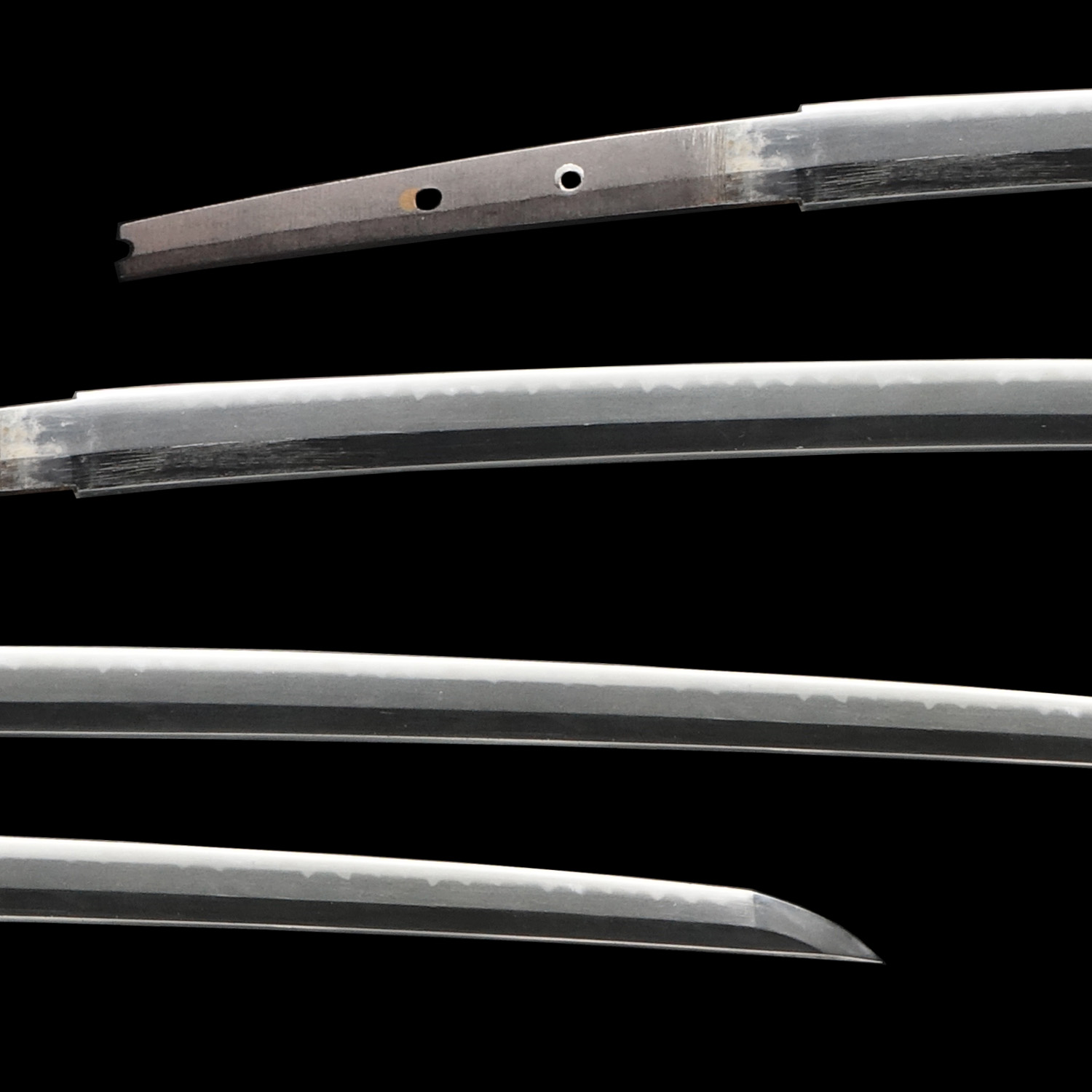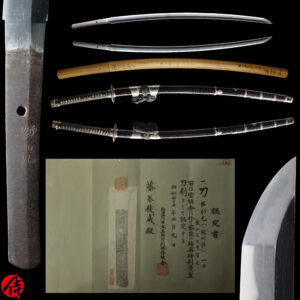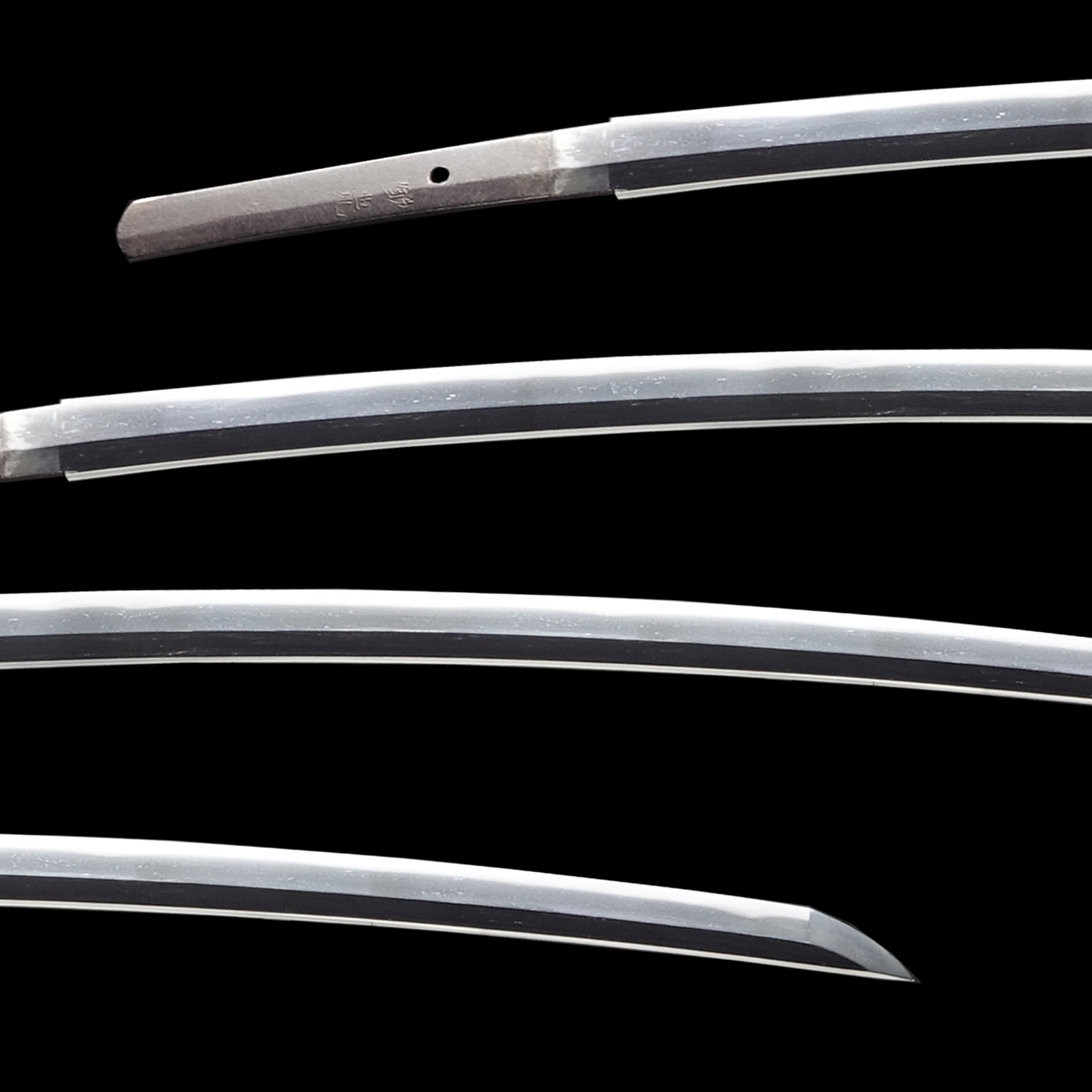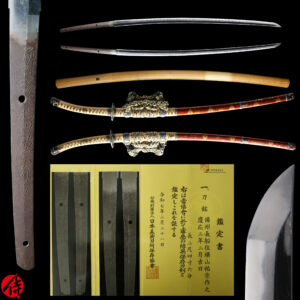

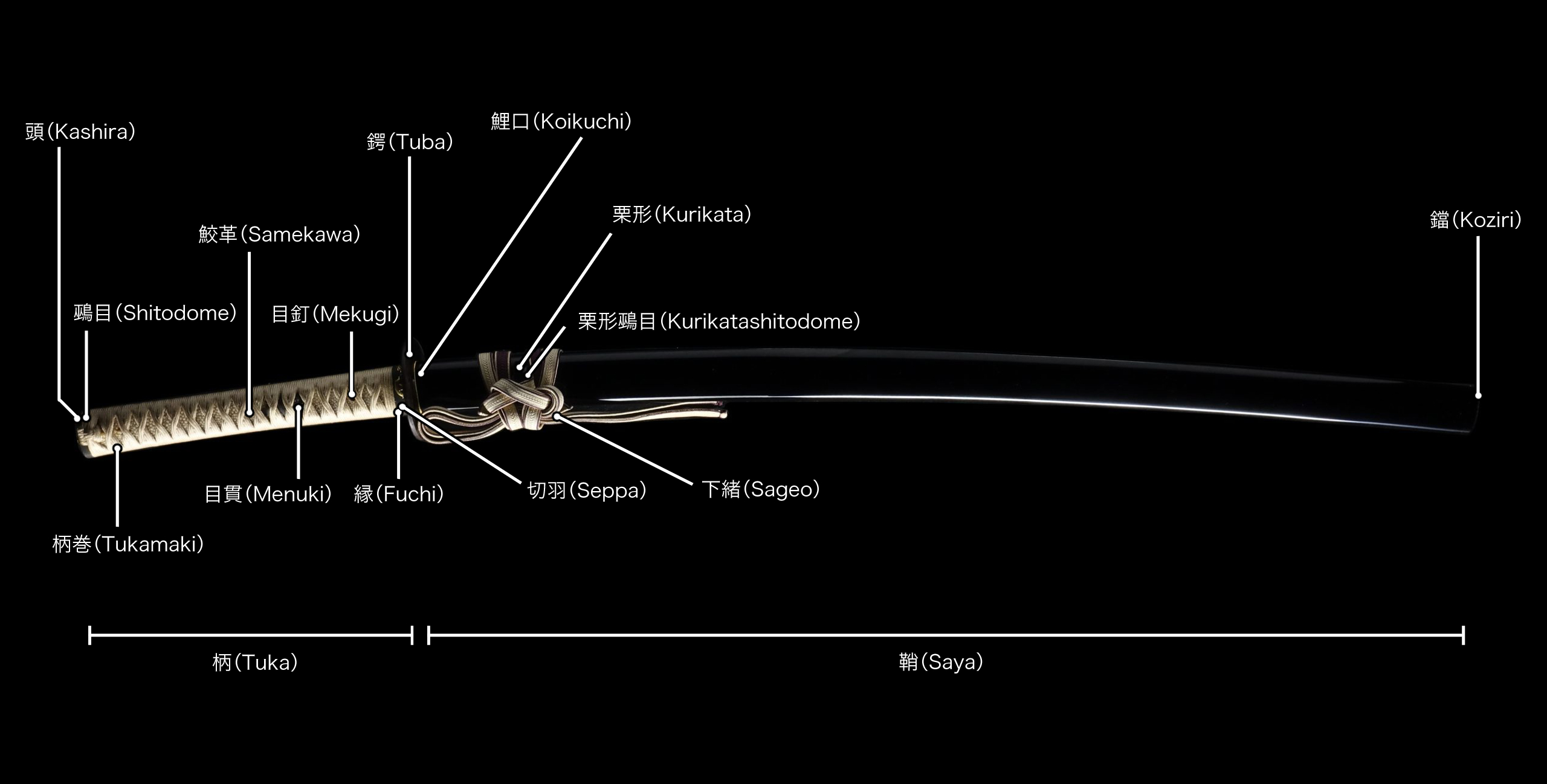
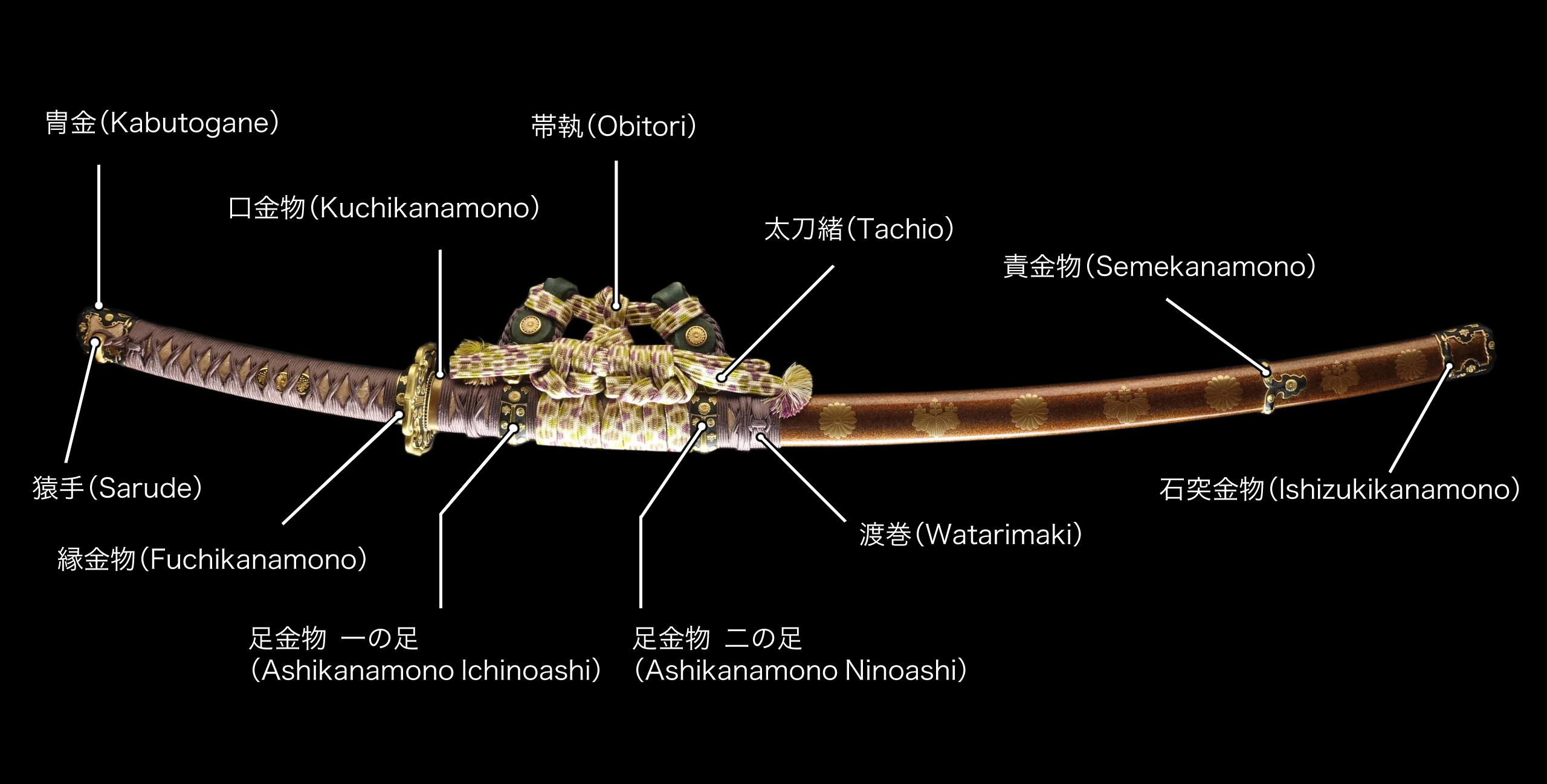
| Ara-nie(荒沸) | Large nie crystals |
|---|---|
| Ashi(足) | Literally legs, usually nioi, extending from the hamon towards the cutting edge. |
| Ashi-kanamono(足金物) | Fittings attached to the saya that attach to the obi-tori. |
| Ashi-kawa(足革) | Fixed length leather obi-tori straps in the case of ito-maki-tachi koshirae. |
| Ashi-ma(足間) | The space between the two ashi-kanamono. |
| Ayasugi-hada(綾杉肌) | Undulating grain pattern in the ji resembling a Japanese cedar grain pattern. |
| Bakufu(幕府) | Tent government |
|---|---|
| Bakumatsu(幕末) | An era in the late Edo period 1853-1867 |
| Banzashi-daisho(番差大小) | A pair of swords in matching mountings. The scabbards were plain black lacquer with horn fittings. The handle had a horn pommel, and the base had a shakudo-nanko fitting (fuchi), with plain black brocade wrap over a white ray-skin base. Other fittings, sword guard, the decorative handgrips (menuki), and other utensils (kogai and kozuka) were also made out of a gold and copper alloy called shakudo. |
| Bizen(備前) | Archeaic province of Japan, modern day Okayama prefecture |
| Bizen-to(備前刀) | Swords produced in Bizen |
| Bizen-zori(備前反り) | Deep curvature close to the tang area of the sword; also known as koshi-zori |
| Bo-hi(棒樋) | Long groove, carved into the blade, often mistakenly referred to as a blood groove |
| Bonji(梵字) | Sanscrit characters carved into the blade invoking Buddhist deities. |
| Boshi(帽子) | The hamon formed within the kissaki |
| Bo-utsuri(棒映り) | A straight formation of usturi |
| Bu(分) | Japanese imperial form of measurement (10 bu = 1 sun) |
| Bushi(武士) | Another term for samurai – the warrior class |
| Chikei(地景) | A curved line of nie, seen in the ji |
|---|---|
| Choji abura(丁子油) | Clove oil, used for preserving blades |
| Choji ashi(丁子足) | Clove-shaped ashi |
| Choji midare(丁子乱れ) | A hamon consisting of choji shapes, but the overall line of the hamon has no definable form. |
| Choji midare komi(丁子乱れ込み) | A choji midare hamon that continues into the kissaki |
| Choji utsuri(丁子映り) | Utsuri in the pattern of choji |
| Chokuto(直刀) | A straight sword, but similar in construction to the tachi |
| Chu-kissaki(中切先) | A medium sized kissaki, in relation to the overall size of the blade |
| Chu-suguha(中直刃) | A medium-sized straight hamon |
| Daimyo(大名) | Provincial samurai lords |
|---|---|
| Daisho(大小) | A pair of swords in matching fittings worn together: dai- being the long sword, and sho- being the shorter companion sword. Only the samurai were permitted to wear daisho during the Edo period. |
| Dewa(出羽) | Archaic name for region in present-day Akita & Yamagata Prefectures |
| Dogane(胴金) | Tubular fittings on the tsuka or saya. |
| Eto(干支) | Zodiacal calender often used for date inscriptions on swords, originally from China. |
|---|
| Fuchi(縁) | A decorative reinforcing collar attached to the base of the tsuka. |
|---|---|
| Fudo Myo-O(不動明王) | Buddhist deity, the immovable King of Light. Patron deity of swordsmen. Commonly used for horimono. |
| Fukusa(袱紗) | The curve of the cutting edge of the kissaki. |
| Fukurin(覆輪) | A gold, silver, or bronze band attached to the tsuka and saya on both the mune side and the ha side to secure the ji-ita. |
| Funbari(踏ん張り) | Used to describe a blade when it noticeably tapers between the base of the cutting edge and the tip, or tapers noticebly in the base of the blade. |
| Futasuji-hi(二筋樋) | Two parallel grooves carved into the blade |
| Gendaito(現代刀) | Japanese swords produced after 1876 |
|---|---|
| Goban-kaji(御番鍛冶) | The swordsmiths summoned to work for the retired emperor Gotoba |
| Goka-den(五箇伝) | The five original traditions of swordmaking from the koto period |
| Goki shichido(五畿七道) | The five home provinces and seven main roads. Originally used for units of governmental administration. Currently used for classifying swordsmiths by region and style. |
| Gomabashi(護摩箸) | A horimono in the form of the ritual chopsticks used in both Shinto and Buddhist rites. |
| Gunome(互の目) | A type of hamon that undulates in a series of semi-circles |
| Ha(刃) | The hardened part of the blade along the cutting edge. |
|---|---|
| Habaki(鎺) | The small metal collar (often decorated) that buffers the tsuba and secures the blade into the saya |
| Habaki-moto(鎺元) | The part of the blade that sits under the habaki |
| Ha-buchi(刃縁) | The line that divides the ha and the ji |
| Ha-cho(刃長) | The Length of the cutting edge, determined by measuring in a straight line from the mune-machi to the tip of the kissaki. See Nagasa. |
| Hada(肌) | The pattern in the steel skin of the blade, also called jihada |
| Hadori(刃取り) | A polishing technique which highlights the hamon, also known as kesho |
| Hagire(刃切れ) | A hairline crack in the blade rising up from the cutting edge |
| Haitorei(廃刀令) | The law administered in Japan 1876, banning the wearing of swords in public |
| Hakikake(掃掛) | Similar to sunagashi, ashi resembling brush strokes. |
| Haki-omote(佩表) | The side of a sword that faces outwards when worn with the cutting edge facing downwards (see tachi). |
| Ha-machi(刃区) | The notch where the cutting edge of the blade begins |
| Ha-mon(刃紋) | The crystalline structure which forms along the cutting edge of a blade as a result of the hardening process |
| Ha-saki(刃先) | The cutting edge that runs from the ha-machi to the tip of the kissaki. |
| Hataraki(働き) | The various activities within the hamon, created during the hardening process |
| Ha-watari(刃渡り) | See Nagasa |
| Heian Period(平安時代) | 794-1185 |
| Hi(樋) | A groove carved into the blade for weight decreasing or decorational purposes |
| Hikae-mekugi-ana(控え目釘穴) | A second hole close to the nakago-jiri, sometimes added for a second retaining peg. |
| Hira-ji(平地) | The surface area of the blade between the shinogi and the cutting edge. |
| Hira-dukuri(平造り) | A sword made without any ridgelines, flat on both sides |
| Hiro-suguha(広直刃) | A wide suguha hamon |
| Hitatsura(皆焼) | A type of hamon with tobiyaki liberally spread across the width of the blade. |
| Horimono(彫り物) | Decorative or religious blade carvings |
| Hyogo-gusari Koshirae(兵庫鎖拵) | A very durable and practical type of tachi koshirae that was popular with high-ranking samurai warriors of the late 12th Century. Hyogo-gusari koshirae ashi are constructed from chain. |
| Ichimonji School(一文字派) | A 13th C. school of swordsmiths working in the Bizen tradition |
|---|---|
| Ichi-no-ashi(一の足) | The ashi-kanamono closest to the saya mouth. |
| Ikubi kissaki(猪首切先) | A stout kissaki which is shorter in length than it is wide. |
| Inazuma(稲妻) | (lit. lightning) A line of nie inside the hamon resembling lightning |
| Iori-mune(庵棟) | A two-sided mune resembling the roof of a house |
| Ishiduki(石突) | The scabbard chape attached to protect the saya-jiri. |
| Itame-hada(板目肌) | A wood grain type pattern in the skin steel of the blade |
| Ito-maki-tachi-Koshirae(糸巻太刀拵) | A type of tachi koshirae that has the wrapping on the handle repeated on the upper part of the saya (watari-maki) |
| Ji(地) | The surface area of the blade between the shinogi and the hamon. |
|---|---|
| Jifu(地斑) | Patches of dense ji-nie |
| Jifu-utsuri(地斑映り) | Discontinuous utsuri |
| Ji-gane(地金) | The steel of a constructed blade |
| Ji-hada(地肌) | The surface area of the blade between the hamon and the shinogi, see hada |
| Ji-ita(地板) | A thin plate of gilded or carved metal applied to the saya and tsuka and fixed in place by the fukurin. |
| Ji-nie(地沸) | Nie in the ji |
| Ji-tetsu(地鉄) | See hada and jigane |
| Juka-choji(重花丁子) | Multiple grouped choji pattern |
| Kabuto-gane(兜金) | A pommel cap for the tsuka. |
|---|---|
| Kaen(火焔) | A type boshi that resembles burning flames |
| Kaeri(返り) | The part of the boshi that turns back towards the tang, along the mune |
| Kaeri-duno(返り角) | A small hook on the saya to stop the saya coming out of the belt. |
| Kaiken(懐剣) | A small concealable dagger |
| Kaki-toshi(掻通し) | A groove that ends by tapering within the tang |
| Kaki-nagashi(掻流し) | A type of groove that continues through to the end of the tang |
| Kaku-tome(角止め) | A groove end that is square, usually stops just before the habaki |
| Kamakura Period(鎌倉時代) | 1185-1333 |
| Kanbun Shinto(寛文新刀) | Blades made around the Kanbun era 1661-1673 |
| Kanitsume(蟹爪) | A type of gunome resembling crabs claws |
| Kanmuri-otoshi-dukuri(冠落とし造り) | The backridge of the blade is beveled like a naginata |
| Kara-tsuba(唐鐔) | Originally Chinese style formal tsuba for kara-tachi. |
| Kasane(重ね) | The thickness of the blade |
| Kashira(頭) | A decorative pommel attached to reinforce the end of the tsuka. |
| Kata-ochi gunome(片落互の目) | Flat topped gunome that slant in the same direction like saw teeth |
| Katana(刀) | Curved blades worn with the cutting edge up, when thrust through the sash |
| Katte-agari yasuri(勝手上り鑢) | File marks on the tang that slant downward to the left |
| Katte-sagari yasuri(勝手下り鑢) | File marks on the tang that slant downward to the right |
| Kawara-gane(瓦金) | A small strip of metal (or horn) used to reinforce the mouth of the kogai-hitsu. |
| Kawazu-ko choji(蛙子丁子) | Tadpole shaped choji |
| Kazari-tachi koshirae(飾太刀拵) | Richly decorated formal tachi koshirae that were popular during the peak of the aristocratic government in the Nara and Heian eras. |
| Kazu-uchimono(数打ち物) | Mass produced blades of little artistic quality |
| Ken(剣) | Straight ritual Chinese style sword, often associated with Fudo Myo-O |
| Keicho era(慶長) | 1596-1615 |
| Keicho Shinto(慶長新刀) | Blades produced around the Keicho era (1596-1615) at the start of the Shinto sword period |
| Kesho(化粧) | See Hadori |
| Kinsuji(金筋) | (Lit. Golden line) a small shiny line of nie inside the hamon |
| Kiriha-dukuri(切刃造) | A sword made with the shinogi close to the cutting edge |
| Kiri yasuri(切り鑢) | File marks on the tang that are horizontal |
| Kissaki(切先) | The tip of the blade, from the point to the yokote |
| Kissaki-moroha-dukuri(切先諸刃造り) | A blade made with a double edge in the monouchi area |
| Ko(小) | Prefix, meaning small (ex. Ko-nie – small nie) |
| Ko-ashi(小足) | small ashi |
| Kobuse(甲伏) | The most common type of blade manufacture, in which the steel used for the cutting edge is wrapped around a lower carbon steel, then hammered out into the shape of the blade |
| Kobushi-gata-choji(拳形丁子) | Fist shaped choji |
| Ko-dachi(小太刀) | A small tachi |
| Kogai(笄) | A bodkin like implement with a small scoop on the end. Used for fixing a samurai’s hair and cleaning his ears. |
| Kogai-hitsu(笄櫃) | The pocket on the obverse of a saya where the kogai is kept. |
| Kogatana(小刀) | Utility knife |
| Koi-guchi(鯉口) | The mouth of the saya |
| Ko-itame(小板目) | Small wood grain pattern |
| Kojiri(小尻) | A decorative fitting on the bottom of the saya. |
| Ko-maru(小丸) | A type of boshi that turns back in a small smooth circular motion |
| Ko-nie(小沸) | Small nie particles |
| Konuka-hada(小糠肌) | A term used mainly for Hizen blades, commonly referred to as rice grain hada |
| Koshi-ba(腰刃) | A flamboyant section of hamon at the base when compared to the rest of the blade |
| Koshi-bi(腰樋) | A short type of groove carved in the blade close to the tang |
| Ko-shinogi(小鎬) | The part of the shinogi that runs from the yokote to the tip in the kissaki |
| Koshi-no-hiraita(腰の開いた) | Wide based undulations that slope gently, usually with choji. |
| Koshirae(拵え) | A full set of sword mountings. |
| Koshi-zori(腰反り) | Swords with the deepest part of the curve near to the tang |
| Koto(古刀) | (Old swords) Swords made prior to the Edo period |
| Ko-wakizashi(小脇差) | A short wakizashi |
| Koduka(小柄) | A term used to refer to both a decorative handle for a small utility knife and for the complete handle and knife assembled together. |
| Koduka-hitsu(小柄櫃) | The pocket on the reverse of the saya where the kozuka is stored. |
| Kuchi-kanamono(口金物) | A metal fitting that protects the mouth of the saya. |
| Kuichigai-ba(食い違い刃) | An over-lapping break in the hamon, common in yamato-den blades |
| Kuri-jiri(栗尻) | Round-ended type of nakago, similar to the shape of a chestnut |
| Kurikara(倶利伽羅) | A horimono of a dragon wrapped around a ken, a representation of Fudo Myo-O |
| Kurikata(栗形) | A nodule with a hole affixed on the outside of the saya to attach the sageo. |
| Machi(区) | The notches that mark the end of the mune (mune-machi) and the end of the cutting edge (ha-machi) |
|---|---|
| Maru-dome(丸止め) | A carved groove end that is rounded |
| Maru-mune(丸棟) | A mune that is rounded |
| Masame-hada(柾目肌) | A straight grain pattern in the hada |
| Mei(銘) | Signature or inscription on the tang |
| Mekugi(目釘) | The bamboo peg used to secure the handle onto the tang |
| Mekugi-ana(目釘穴) | The hole on the tang where the mekugi is inserted |
| Mekugi-nuki(目釘抜き) | A tool for removing the mekugi |
| Menuki(目貫) | Decorative hand grips affixed to both sides of the tsuka |
| Midare-komi(乱れ込み) | A boshi where a midare hamon continues into the kissaki |
| Midare(乱れ) | A hamon of irregular form. All hamon are midare except suguha |
| Midare-utsuri(乱れ映り) | irregular utsuri |
| Mihaba(身幅) | The width of a blade: measured from the mune to the cutting edge. |
| Mitsu-gashira(三ツ頭) | The place where the Shinogi meets the ko-shinogi and the yokote |
| Mitsu-kado(三ツ角) | The point where the yokote, ha-saki, and fukura meet. |
| Mitsu-mune(三ツ棟) | A mune with three sides |
| Mokume-hada(木目肌) | A grain pattern in the hada similar to itame, but more rounded |
| Mune-machi(棟区) | See machi |
| Monouchi(物打) | One-third of the blade from the yokote towards the tang |
| Moroha-dukuri(諸刃造り) | An asymmetrical blade with a cutting edge on both sides |
| Mune(Also mine)(棟(峰)) | The back of the blade |
| Mu-zori(無反り) | A blade with no curvature |
| Nagare-hada(流れ肌) | A hada that flows along the blade like a flowing stream. |
|---|---|
| Nagasa(長さ) | The blade length; measured from the tip to the mune-machi |
| Naginata(薙刀) | A Japanese halberd |
| Nakago(茎) | The tang of a blade |
| Nakago-jiri(茎尻) | The tip of the tang |
| Nanatsu-gane(七ツ金) | Metal fittings used for adjusting the length of the obi-tori. There are three on the ichi-no-ashi, and four on the ni-no-ashi. |
| Nanbokucho Period(南北朝時代) | 1333-1392 |
| Nashi-ji(梨地) | Pear Skin |
| Nezumi ashi(鼠足) | Very small ashi |
| Nie(沸) | Small martensite crystals individually visible to the naked eye |
| Nie-deki(沸出来) | A blade with a predominantly nie hamon |
| Nihonto(日本刀) | Japanese swords |
| Ni-no-ashi(二の足) | The ashi-kanamono furthest away from the saya mouth. |
| Nioi(匂) | Martensite crystals not individually distinguishable to the naked eye. Similar to the milky way in appearance |
| Nioi-deki(匂出来) | A sword with a hamon consisting mainly of nioi |
| Nioi-guchi(匂口) | The dividing line between the hamon and the ji |
| No-dachi(野太刀) | Long swords popular during the Nanbokucho period |
| Notare(湾れ) | Gently undulating hamon |
| O(大) | Prefix, denoting large (ex. O-gunome – large gunome) |
|---|---|
| Obi-tori(帯執) | Leather straps for a belt to be passed through for a tachi. |
| O-busa(大房) | Large rising choji |
| O-dachi(大太刀) | A tachi with a cutting edge that exceeds 3 shaku (91cm). |
| Omote(表) | The front side of the blade (differs between tachi and katana). |
| O-seppa(大切羽) | Large sized spacers (seppa) that match the shape of the tsuba. |
| Oshigata(押し型) | A rubbing taken of the tang and outline of a blade. The hamon and activities are then drawn by hand. |
| Raden(螺鈿) | Mother of Pearl |
|---|---|
| Ryo-shinogi-dukuri(両鎬造り) | A shinogi on both sides. |
| Sageo(下げ緒) | A cord attached to the kurikata to help secure the sword in the belt. |
|---|---|
| Saka ashi(逆足) | Slanted ashi |
| Saka choji(逆丁子) | Slanted choji |
| Saki-hada(先肌) | Width of the blade at the yokote |
| Saki-zori(先反り) | When the curvature is deepest in the upper part of the blade |
| Sanbon-sugi(三本杉) | A type of hamon that resembles three cedar trees repeated along the blade. |
| Saru-te(猿手) | A ring for the attachment of a ude-nukio. |
| Saya(鞘) | Scabbard |
| Saya-jiri(鞘尻) | The bottom of the outside of the saya |
| Seoi-dachi(背負い太刀) | Swords worn across the back |
| Shaku(尺) | Japanese imperial form of measurement (1 shaku = 30.3cm) |
| Semegane(責金) | A decorated metal band that supports the saya between the ni-no-ashi and the ishizuke. |
| Sengoku jidai(戦国時代) | Age of the warring states 1493-1573 |
| Seppa(切羽) | Spacers that fit between the tsuka and the tsuba, and between the tsuba and the habaki to ensure the tsuka fits perfectly. |
| Shinogi(鎬) | The ridge line that that runs from the yokote to the end of the nakago |
| Shinogi-ji(鎬地) | The area between the shinogi and the mune |
| Shinogi-suji(鎬筋) | A ridgeline that runs the from the nakago-jiri to the yokote, separating the hira-ji from the shinogi-ji. |
| Shinogi-dukuri(鎬造り) | A sword manufactured with the ridgeline near to the mune |
| Shin-shinto(新々刀) | Swords made between 1781 and 1868 |
| Shinto(新刀) | Swords made between 1600 and 1781 |
| Shirasaya(白鞘) | A plain wooden sleeping scabbard and handle to protect the blade. |
| Soden-Bizen(相伝備前) | Bizen swords displaying soshu-den traits |
| Soe-bi(添樋) | A smaller carved groove that runs parallel to the large groove |
| Sori(反り) | Curvature of the blade |
| Soshu-den(相州伝) | The tradition of swordmaking originating from the archaic Sagami province. |
| Sudare-ba(簾刃) | A hamon that resembles brush strokes, or a bamboo curtain. |
| Sugata(姿) | The shape of the blade |
| Suguha(直刃) | A straight hamon |
| Sujikai yasuri(筋違鑢) | Acutely slanted file mark pattern on the nakago |
| Suken(素剣) | Also known as a ken, short straight ritual Chinese style sword, often associated with Fudo Myo-O |
| Sun(寸) | Japanese imperial form of measurement (1 sun = 3.03cm, 10 sun = 1 shaku) |
| Sunagashi(砂流し) | An activity in the hamon that resembles sweeping sands |
| Sunnobi tanto(寸延短刀) | Oversized tanto |
| Suriage(磨り上げ) | Blade that has been shortened from its original length |
| Tachi(太刀) | Swords made to be worn with the cutting edge down, suspended from the belt |
|---|---|
| Tachi-o(Haki-o)(太刀緒(佩緒)) | A thin, approximately three meter, cord belt that passes through the obi-tori. Used for tachi when worn during peacetime. |
| Tachi-mei(太刀銘) | A blade signed on the side of the tang that faces outward when worn with the cutting edge downward. |
| Taiko-gane(Mon-gane)(太鼓金(文金)) | A decorated metal stud used to fix the ashi-kawa. Often in the design of a clan mon. |
| Taiko-gawa(太鼓革) | A leather ashi-kawa strap has a round shape at the base like a taiko drum. |
| Tamahagane(玉鋼) | Japanese steel, used for the manufacture of Japanese swords, indigenous to Japan |
| Tanto(短刀) | Blades made shorter that 30cm |
| Tawarabyo(俵鋲) | Decorative pins originally used to secure the same-gawa on old tachi. |
| Togariba(尖刃) | Pointed shapes protruding from the hamon |
| Torii-zori(鳥居反り) | A blade with an even curve |
| Tsuba(鍔(鐔)) | A Japanese sword guard. |
| Tsuchioki(土置き) | The clay applied to the blade before the hardening process |
| Tsuka(柄) | The hilt |
| Tsurugi(剣) | Alternate Japanese word for sword. |
| Tsutsu-gane(Naga-kanamono)(筒金(長金物)) | Cylindrical decorative metal fittings. |
| Tsuyusaki-gane(Shizuku-gane)(露先金(雫金)) | Decorative fittings attached to the end of the ude-nukio. |
| Ubu(生ぶ) | Original, usually used when referring to the nakago. |
|---|---|
| Ubu-ha(生ぶ刃) | An area of the cutting edge from the ha-machi that has not yet been sharpened. This is typical with new blades. |
| Uchi-gatana(打ち刀) | Blades produced for one-handed use during the Muromachi period worn thrust through the belt with the cutting edge uppermost. |
| Uchi-gatana Koshirae(打ち刀拵え) | A general term for practical sword mountings of the Sengoku era. Later, katana-koshirae. |
| Uchi-noke(打除け) | Small crescent shapes appearing like niju-ba in the ji close to the hamon. |
| Uchi-zori(内反り) | The back of the blade curves toward the cutting edge |
| Ude-nuki-o(Te-nuki-o)(腕抜き緒(手抜き緒)) | A cord for wrapping around the wrist to secure the sword in the hand. |
| Ura(裏) | The back side of the blade |
| Ura-gawara(裏瓦) | A small strip of metal, or horn, used to reinforce the mouth of the kozuka-hitsu. |
| Utsuri(映り) | (Reflection) A white misty formation that runs parallel to the hamon in the ji. |
| Utsushi-mono(写し物) | Copies of past masterpieces (not to be confused with forgeries) |
| Wakizashi(脇差) | Blades over 30 cm in length, but shorter than 60 cm. Often a companion sword to the katana. |
|---|---|
| Watari-maki(渡巻) | The wrapping that matches the tsuka-maki on an ito-maki-tachi that runs from the koi-guchi to just past the ni-no-ashi. |
| Yagura-gane(櫓金) | A ring type fitting that allows the obi-tori to be attached to the yamagata-kanamono. |
|---|---|
| Yaki-ba(焼き刃) | The hardened area of the blade |
| Yaki-dashi(焼き出し) | A part of the hamon which starts off straight at the hamachi, but turns into a different hamon several centimetres along the blade |
| Yaki-haba(焼き幅) | The width of the Yakiba |
| Yaki-ire(焼き入れ) | The hardening process of the blade when it is heated, then quenched in water |
| Yaki-otoshi(焼き落とし) | A hamon which starts further along the blade, about 3-5cm from the ha-machi. |
| Yaki-dume(焼き詰め) | A type of boshi without a turn-back. |
| Yari(槍) | A Japanese spear usually mounted on a long shaft. |
| Yamagata(山形) | Mountain shaped |
| Yamagata-kanamono(山形金物) | The mountain shaped parts of the ashi-kanamono |
| Yasuri-me(鑢目) | File markings (on the tang) |
| Yo(葉) | An activity in the hamon that resembles falling leaves |
| Yokote(横手) | The dividing line between the kissaki and the body of the blade (mainly on shinogi-zukuri swords) |
| Yoroi-doshi(鎧通し) | Armour piercing (tanto) |
| Yubashiri(湯走り) | A concentration of nie in the ji |
| Zaimei(在銘) | A blade with an original signature |
|---|---|
| Zencho(全長) | The length of the sword, determined by measuring in a straight line from the tip of the nakago to the tip of the kissaki. |
